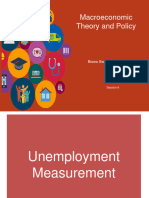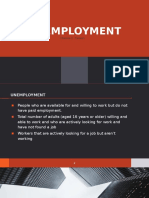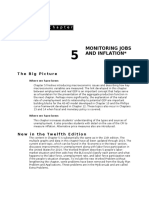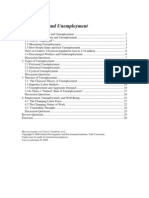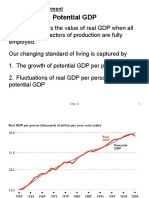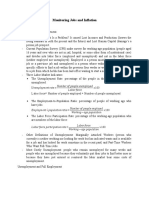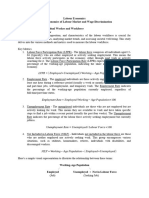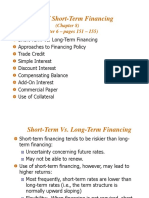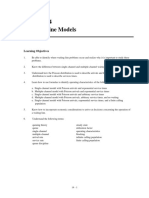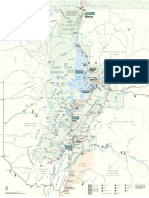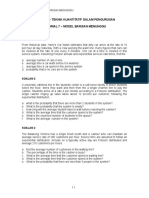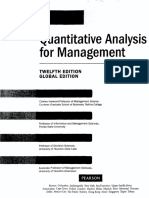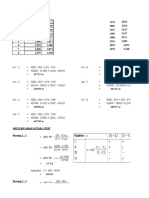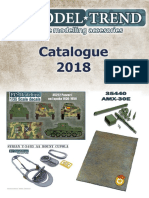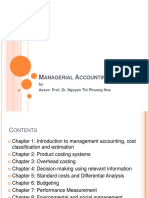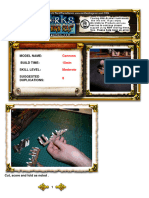SG 22
Uploaded by
Iqra JawedSG 22
Uploaded by
Iqra JawedChapter5
MonitoringJobsandInflation
1EmploymentandUnemployment
1) Theworking-agepopulationisdefinedasthenumberof
A) peopleovertheageof16whoarenotinjail,hospital,orotherinstitution.
B) peoplewhohaveajob.
C) peopleworkingfull-timejobswhoareovertheageof16.
D) peoplelookingforwork.
Answer: A
Topic: PopulationSurvey
Skill: Recognition
Questionhistory: Previousedition,Chapter5
AACSB: ReflectiveThinking
2) Theworking-agepopulationcanbedividedintotwogroups,
A) peopleinthelaborforceandpeoplelookingforwork.
B) peopleinthelaborforceandpeoplewithajob.
C) peoplelookingforworkandthoseinthearmedforces.
D) peopleinthelaborforceandpeoplewhoarenotinthelaborforce.
Answer: D
Topic: PopulationSurvey
Skill: Recognition
Questionhistory: Previousedition,Chapter5
AACSB: ReflectiveThinking
3) Thetotalnumberofpeopleaged16yearsandoverwhoarenotinstitutionalized________.
A) equalsthenumberofemployedplusunemployed
B) istheworking-agepopulation
C) doesnotincludestudents
D) isthelaborforce
Answer: B
Topic: WorkingAgePopulation
Skill: Recognition
Questionhistory: Previousedition,Chapter5
AACSB: ReflectiveThinking
Copyright2012PearsonEducation,Inc.
606ParkinMacroeconomics,TenthEdition
4) Whichofthefollowingstatementsisincorrect?
A) Thelaborforceisequaltothenumberofpeopleemployedplusthenumberofpeople
unemployed.
B) Theworkingagepopulationincludeseveryoneovertheageof16.
C) Theunemploymentrateisthenumberofpersonswhoareunemployeddividedbythe
laborforcethentimes100.
D) Thelabor-forceparticipationrateisthelaborforcedividedbytheworking-age
populationthentimes100.
Answer: B
Topic: WorkingAgePopulation
Skill: Recognition
Questionhistory: Previousedition,Chapter5
AACSB: ReflectiveThinking
5) WhichofthefollowingisNOTincludedintheworking-agepopulation?
A) discouragedworkers
B) peoplewaitingtobecalledbacktoajobafterbeinglaidoff
C) retireesundertheageof55
D) peopleinprison
Answer: D
Topic: WorkingAgePopulation
Skill: Recognition
Questionhistory: Previousedition,Chapter5
AACSB: ReflectiveThinking
6) Allpeopleintheworking-agepopulationcanbedividedinto
A) laborforceparticipants.
B) employed,unemployed,ornotinthelaborforce.
C) eitherover-employedorunder-employed.
D) potentialemployees.
Answer: B
Topic: WorkingAgePopulation
Skill: Recognition
Questionhistory: Previousedition,Chapter5
AACSB: ReflectiveThinking
7) SupposetheworkingagepopulationinTinyTownis100people.If25ofthesepeopleareNOT
inthelaborforce,the________equals________.
A) unemploymentrate;25/100100
B) unemploymentrate;25/75100
C) laborforce;75
D) laborforce;25/100100
Answer: C
Topic: WorkingAgePopulation
Skill: Conceptual
Questionhistory: Previousedition,Chapter5
AACSB: AnalyticalSkills
Copyright2012PearsonEducation,Inc.
Chapter5MonitoringJobsandInflation607
8) Thelaborforceisthesumofthe
A) working-agepopulationandthenumberofunemployedpeople.
B) numberofemployedpeopleandtheworking-agepopulation.
C) numberofemployedpeopleandthenumberofunemployedpeople.
D) totalpopulationandthenumberofunemployedpeople.
Answer: C
Topic: LaborForce
Skill: Recognition
Questionhistory: Previousedition,Chapter5
AACSB: ReflectiveThinking
9) Thelaborforceisdefinedas
A) peoplewithfulltimejobs.
B) workerswithjobsandunemployedworkers.
C) allpeoplecapableofwork.
D) Alloftheaboveanswersarecorrect.
Answer: B
Topic: LaborForce
Skill: Recognition
Questionhistory: Previousedition,Chapter5
AACSB: ReflectiveThinking
10) The________equalsthenumberof________.
A) laborforce;personsover16yearsold
B) laborforce;unemployedandemployedpersons
C) workingagepopulation;employedpersons
D) unemploymentrate;peopleunemployed
Answer: B
Topic: LaborForce
Skill: Recognition
Questionhistory: Previousedition,Chapter5
AACSB: ReflectiveThinking
11) Thelaborforceisdefinedaspeople
A) whohaveajoborarelookingforajob.
B) intheworking-agepopulationwhohaveajob.
C) intheworking-agepopulationwhohaveafulltimejob.
D) whoare16yearsofageorolder.
Answer: A
Topic: LaborForce
Skill: Recognition
Questionhistory: Previousedition,Chapter5
AACSB: ReflectiveThinking
Copyright2012PearsonEducation,Inc.
608ParkinMacroeconomics,TenthEdition
12) Whichpopulationcategoryequalsthesumofemployedandunemployedpeople?
A) working-agepopulation
B) laborforce
C) youngandinstitutionalized
D) notinthelaborforce
Answer: B
Topic: LaborForce
Skill: Recognition
Questionhistory: Previousedition,Chapter5
AACSB: ReflectiveThinking
13) The________isthetotalnumberofpeopleaged16yearsandolder(andnotinjail,hospitalor
institutionalcare)whilethe________isthenumberofpeopleemployedandtheunemployed.
A) laborforce;working-agepopulation
B) laborforceparticipationrate;laborforce
C) working-agepopulation;laborforce
D) working-agepopulation;laborforceparticipationrate
Answer: C
Topic: LaborForce
Skill: Recognition
Questionhistory: Previousedition,Chapter5
AACSB: ReflectiveThinking
14) Thelaborforceisdefinedasthenumberof
A) people16andover.
B) unemployedpeople.
C) peoplewithjobs,bothpart-timeandfull-time.
D) peoplewhoareemployedandunemployed.
Answer: D
Topic: LaborForce
Skill: Recognition
Questionhistory: Previousedition,Chapter5
AACSB: ReflectiveThinking
15) Thelaborforceisdefinedasthe
A) numberofpeopleover16yearsofage.
B) numberofpeoplewhoareworking.
C) sumofemployedandunemployedpeople.
D) numberofpeopleinblue-collarjobs.
Answer: C
Topic: LaborForce
Skill: Recognition
Questionhistory: Previousedition,Chapter5
AACSB: ReflectiveThinking
Copyright2012PearsonEducation,Inc.
Chapter5MonitoringJobsandInflation609
16) Thelaborforceisdefinedasthe
A) numberofemployedpeopleplusthenumberofunemployedpeople.
B) numberofpeoplewhoareworking.
C) numberofpeoplewhoareworkinginlabor-typejobs.
D) numberofunionmemberswhoareworking.
Answer: A
Topic: LaborForce
Skill: Recognition
Questionhistory: Previousedition,Chapter5
AACSB: ReflectiveThinking
17) Thelaborforceincludes
A) onlythenumberofpeopleemployed.
B) discouragedworkers.
C) onlythenumberofpeopleunemployed.
D) bothemployedandunemployedworkers.
Answer: D
Topic: LaborForce
Skill: Recognition
Questionhistory: Previousedition,Chapter5
AACSB: ReflectiveThinking
18) Thelaborforceisdefinedasthenumberofpeoplewho
A) areemployedplusthenumberofpeoplewhoareunemployed.
B) areavailableandlookingforworkbutareunabletofindemployment.
C) wouldliketohaveajobbuthavestoppedseekingwork.
D) wouldliketohaveafull-timejobbutareworkingpart-time.
Answer: A
Topic: LaborForce
Skill: Recognition
Questionhistory: Previousedition,Chapter5
AACSB: ReflectiveThinking
19) Full-timestudentsandprisonersare________.
A) notinthelaborforce
B) inthelaborforce
C) countedasdiscouragedworkers
D) countedasunemployed
Answer: A
Topic: LaborForce
Skill: Recognition
Questionhistory: Previousedition,Chapter5
AACSB: ReflectiveThinking
Copyright2012PearsonEducation,Inc.
610ParkinMacroeconomics,TenthEdition
20) WhichofthefollowingisNOTconsideredtobeinthelaborforce?
A) astudentwhoworkspart-time
B) apersonwhoisnotworkingbutwhohastriedtofindajobinthepastweek
C) apersonwhoiswaitingtostartanewjobinthenext30days
D) apersonwhoisnotworkingandwhohasnottriedtofindajob
Answer: D
Topic: LaborForce
Skill: Conceptual
Questionhistory: Previousedition,Chapter5
AACSB: ReflectiveThinking
21) Inaneconomy,42millionpeopleareinthelaborforce,38millionareemployed,and47million
areofworkingage.Howmanypeoplearenotinthelaborforce?
A) 19percent
B) 9million
C) 5million
D) 4million
Answer: C
Topic: LaborForce
Skill: Analytical
Questionhistory: Previousedition,Chapter5
AACSB: AnalyticalSkills
22) Ifthenumberofpeopleunemployedis100,thenumberofpeopleemployedis1000,andthe
working-agepopulationis1400,thenthelaborforceis
A) 1000.
B) 1100.
C) 1400.
D) 1500.
Answer: B
Topic: LaborForce
Skill: Analytical
Questionhistory: Previousedition,Chapter5
AACSB: AnalyticalSkills
23) TheofficialU-3unemploymentrate
A) includespersonswithoutajobwhohavemadeeffortsinthelastweektofindajob.
B) includespersonswithoutajob,whethertheyareactivelysearchingforworkornot.
C) countsdiscouragedworkersasunemployed.
D) countspeoplewithpart-timejobswhowantfull-timejobsasunemployed.
Answer: A
Topic: Unemployment
Skill: Recognition
Questionhistory: Modified10thedition
AACSB: ReflectiveThinking
Copyright2012PearsonEducation,Inc.
Chapter5MonitoringJobsandInflation611
24) TheofficialU-3unemploymentrateincludesthetotalnumberofpeoplewho
A) havejobsorarecurrentlylookingforjobs.
B) areavailableandlookingforworkbutunabletofindemployment.
C) wouldliketohaveajobbuthavestoppedseekingwork.
D) wouldliketohaveafull-timejobbutareworkingpart-time.
Answer: B
Topic: Unemployment
Skill: Analytical
Questionhistory: Modified10thedition
AACSB: ReflectiveThinking
25) WhichofthefollowingpeoplewouldbecountedasisemployedintheCurrentPopulation
Survey?
A) Rich,whoisworking20hoursaweekbutwantsafull-timejob
B) Misty,whojustquitherjobtoreturnfull-timetoschool
C) April,whojustgraduatedfromcollegeandislookingforwork
D) Jason,whowaslaidofffromworklessthan6monthsagobutwhohasstoppedlooking
forwork
Answer: A
Topic: Unemployment
Skill: Conceptual
Questionhistory: Previousedition,Chapter5
AACSB: ReflectiveThinking
26) Whichofthefollowingbestfitsthedefinitionofunemployed?
A) retiredandnotworking
B) workinglessthanafullworkweek
C) notworkingbutlookingforajob
D) notworkingandnotlookingforwork
Answer: C
Topic: Unemployment
Skill: Conceptual
Questionhistory: Previousedition,Chapter5
AACSB: ReflectiveThinking
27) Usingthedefinitionofunemployment,whichofthefollowingindividualswouldbe
unemployed?
A) Afull-timestudentquitsschool,entersthelabormarketforthefirsttime,andsearchesfor
employment.
B) Becauseoftheincreasedlevelofautomobileimports,anemployeeofGeneralMotorsis
laidoffbutexpectstobecalledbacktoworksoon.
C) Becauseofareductioninthemilitarybudget,yournextdoorneighborlosesherjobina
plantwherenuclearwarheadsaremadeandmustlookforanewjob.
D) Alloftheseindividualsareunemployed.
Answer: D
Topic: PopulationSurvey
Skill: Conceptual
Questionhistory: Previousedition,Chapter5
AACSB: ReflectiveThinking
Copyright2012PearsonEducation,Inc.
612ParkinMacroeconomics,TenthEdition
28) WhichofthefollowingpeoplewouldbeconsideredunemployedbytheBureauofLabor
Statistics?
I. Mrs.Xretiresfromherjobattheageof55anddoesnotlookforanotherjob.
II. Mr.Ywaslaidofffromhisjobasawelder,butexpectstoberehiredin8months.
A) Ionly
B) IIonly
C) bothIandII
D) neitherInorII
Answer: B
Topic: Unemployment
Skill: Conceptual
Questionhistory: Previousedition,Chapter5
AACSB: ReflectiveThinking
29) Usingtheofficialmeasureofunemployment,whichofthefollowingpeopleisconsidered
unemployed?
A) apart-timeworkerwhowishestoworkfulltime
B) apersonwhogaveuplookingforjobsbecauseheorshewasdiscouragedabouthisorher
jobprospects
C) apersonwhohasbeensearchingforwork,butturnsdownajobpayingalowerwagerate
thandesired
D) apersonwhoisworkingbutexpectstobelaidoffattheendofthemonth
Answer: C
Topic: Unemployment
Skill: Conceptual
Questionhistory: Modified10thedition
AACSB: ReflectiveThinking
30) Usingtheofficialmeasureofunemployment,whichofthefollowingwould NOTbecountedas
unemployed?
A) apersonwhoisnotworkingbutwhohastriedtofindajobinthepastweek
B) apersonwhoiswaitingtobecalledbacktoajobafterhavingbeenlaidoff
C) apersonwhoperformstraditionalhouseworkanddoesnotworkoutsidethehomefor
pay
D) apersonwhoiswaitingtostartanewjobinthenext30days
Answer: C
Topic: Unemployment
Skill: Conceptual
Questionhistory: Modified10thedition
AACSB: ReflectiveThinking
31) Theunemploymentrateisthe________whoareunemployed.
A) numberofpeopleinthelaborforce
B) percentageofpeopleinthelaborforce
C) percentageofpeopleinthecountry
D) percentageoftheworking-agepopulation
Answer: B
Topic: UnemploymentRate
Skill: Recognition
Questionhistory: Previousedition,Chapter5
AACSB: ReflectiveThinking
Copyright2012PearsonEducation,Inc.
Chapter5MonitoringJobsandInflation613
32) Theunemploymentrateiscalculatedas
A) [(laborforce)(population)] 100.
B) [(unemployment)(population)] 100.
C) [(unemployment)(laborforce)] 100.
D) [(laborforce)(unemployment)] 100.
Answer: C
Topic: UnemploymentRate
Skill: Recognition
Questionhistory: New10thedition
AACSB: AnalyticalSkills
33) Theunemploymentrateequals
A) (numberofpeopleemployed/workingagepopulation) 100.
B) (numberofpeopleunemployed/laborforce) 100.
C) (laborforce/workingagepopulation) 100.
D) (numberofpeopleemployed/numberofpeopleage16andover) 100.
Answer: B
Topic: UnemploymentRate
Skill: Recognition
Questionhistory: Previousedition,Chapter5
AACSB: AnalyticalSkills
34) Theunemploymentrateequalsthenumberof
A) unemployedworkersmultipliedby100.
B) unemployedworkersdividedbythepopulationthenmultipliedby100.
C) unemployedworkersdividedbythenumberofemployedworkersthenmultipliedby100.
D) unemployedworkersdividedbythelaborforcethenmultipliedby100.
Answer: D
Topic: UnemploymentRate
Skill: Recognition
Questionhistory: Modified10thedition
AACSB: AnalyticalSkills
35) Theunemploymentrateequals
A) (thenumberofunemployedworkers)/(thenumberofemployed+unemployedworkers)
100.
B) (thenumberofunemployedworkers)/(thecivilianpopulation)100.
C) (thenumberofunemployedworkers)/(theU.S.populationolderthan16yearsofage)
100.
D) (thenumberofunemployed+ employedworkers)/(U.S.populationolderthan16yearsof
age)100.
Answer: A
Topic: UnemploymentRate
Skill: Recognition
Questionhistory: Modified10thedition
AACSB: AnalyticalSkills
Copyright2012PearsonEducation,Inc.
614ParkinMacroeconomics,TenthEdition
36) Theunemploymentrateequals
A) thetotalnumberofpeoplewithoutjobsinagivenperiod.
B) thepercentageofthepopulationnotcurrentlyemployed.
C) therateofchangeinunemploymentfiguresfromoneperiodtoanother.
D) thepercentageofthelaborforcecurrentlyunemployed.
Answer: D
Topic: UnemploymentRate
Skill: Recognition
Questionhistory: Previousedition,Chapter5
AACSB: ReflectiveThinking
37) Theunemploymentrateisfoundbydividingthenumberofunemployedpeoplebythe
A) numberofworkingindividuals,andmultiplyingby100.
B) numberoftheworking-agepopulation,andmultiplyingby100.
C) sumofworkingindividualsplusunemployedworkers,andmultiplyingby100.
D) numberinthelaborforce,anddividingby100.
Answer: C
Topic: UnemploymentRate
Skill: Recognition
Questionhistory: Previousedition,Chapter5
AACSB: AnalyticalSkills
38) The________iscalculatedasthenumberofpeople________dividedbythelaborforce
multipliedby100.
A) unemploymentrate;unemployed
B) employment-to-populationratio;unemployed
C) employmentrate;employed
D) employment-to-populationratio;intheworkingagepopulation
Answer: A
Topic: UnemploymentRate
Skill: Recognition
Questionhistory: Previousedition,Chapter5
AACSB: AnalyticalSkills
39) Theunemploymentrateisdefinedasthe
A) numberofpeoplenotworking.
B) percentageofthepopulationnotworking.
C) percentageofthelaborforcenotworking.
D) percentageoftheworking-agepopulationnotworking.
Answer: C
Topic: UnemploymentRate
Skill: Recognition
Questionhistory: Previousedition,Chapter5
AACSB: ReflectiveThinking
Copyright2012PearsonEducation,Inc.
Chapter5MonitoringJobsandInflation615
40) Theunemploymentrateismeasuredas
A) thenumberofpeoplethatwanttoworkbutcannotfindjobsoutoftheentirepopulation.
B) thepercentageofpeopleinthelaborforcewhoareunemployed.
C) anindicatortodeterminelong-termeconomicgrowth.
D) anindicatorforpotentialinflation.
Answer: B
Topic: Unemployment
Skill: Recognition
Questionhistory: Previousedition,Chapter5
AACSB: ReflectiveThinking
41) Tocalculatetheunemploymentrate,whichofthefollowingarenecessarypiecesofinformation?
I. thenumberofunemployedpersons
II. thepopulation
III. thenumberofpeopleinthelaborforce
IV. theworkingagepopulation
A) I,IIIIIandIV
B) IandII
C) IandIII
D) IandIV
Answer: C
Topic: UnemploymentRate
Skill: Recognition
Questionhistory: Previousedition,Chapter5
AACSB: ReflectiveThinking
42) Theunemploymentratemeasuresthepercentageof
A) peoplewhowantfull-timejobs,butcantfindthem.
B) theworking-agepopulationwhocantfindajob.
C) peopleinthelaborforcewhocantfindajob.
D) theworkingagepopulationthatcantfindafull -timejob.
Answer: C
Topic: UnemploymentRate
Skill: Conceptual
Questionhistory: Previousedition,Chapter5
AACSB: ReflectiveThinking
43) Whichlabormarketstatistictendsriseduringrecessionsandfallduringexpansions?
A) theunemploymentrate
B) thelabor-forceparticipationrate
C) theemployment-to-populationratio
D) aggregatehours
Answer: A
Topic: UnemploymentRate
Skill: Conceptual
Questionhistory: Previousedition,Chapter5
AACSB: ReflectiveThinking
Copyright2012PearsonEducation,Inc.
616ParkinMacroeconomics,TenthEdition
44) SupposethepopulationofTinyTownis100peopleandtheworkingagepopulationis70.If10
ofthesepeopleareunemployed,theunemploymentrateinTinyTownis
A) 10percent.
B) 10/70100.
C) 10/80100.
D) Thereisnotenoughinformationprovidedtocalculatetheunemploymentrate.
Answer: D
Topic: UnemploymentRate
Skill: Analytical
Questionhistory: Previousedition,Chapter5
AACSB: AnalyticalSkills
45) ThepopulationofTinyTownis100peopleandthelaborforceismadeupof75people.If5of
thesepeopleareunemployed,theunemploymentrateis
A) 5/100100.
B) 5/80100.
C) 5/75100.
D) Thereisnotenoughinformationprovidedtocalculatetheunemploymentrate.
Answer: C
Topic: UnemploymentRate
Skill: Analytical
Questionhistory: Previousedition,Chapter5
AACSB: AnalyticalSkills
46) BasedonthefollowingdataforthecountryofTinyTown,theunemploymentrateequals:
Population=100
Laborforce=80
Numberofemployedpersons=70
Numberofdiscouragedworkers=5
A) 10/100100.
B) 10/80100.
C) 15/80100.
D) 5/70100.
Answer: B
Topic: UnemploymentRate
Skill: Analytical
Questionhistory: Previousedition,Chapter5
AACSB: AnalyticalSkills
47) Inaneconomy,23millionpeopleareemployedand2millionareunemployed,but5million
part-timeworkerswouldpreferfull-timework.Whatistheunemploymentrate?
A) 23.2percent
B) 6.7percent
C) 8percent
D) 25percent
Answer: C
Topic: UnemploymentRate
Skill: Analytical
Questionhistory: Previousedition,Chapter5
AACSB: AnalyticalSkills
Copyright2012PearsonEducation,Inc.
Chapter5MonitoringJobsandInflation617
48) Assumethatthetotallaborforceis100individualswith10unemployed.Theunemployment
rateis________.Nowassumethat10peopledropoutofthelaborforceandthat10remain
unemployed.Thenewunemploymentrateis________.
A) 9percent,10percent
B) 10percent,9percent
C) 10percent,11percent
D) 11percent,10percent
Answer: C
Topic: Unemployment
Skill: Analytical
Questionhistory: Previousedition,Chapter5
AACSB: AnalyticalSkills
49) WhichofthefollowingdecreasestheofficialU-3unemploymentrate?
A) Workersleavethelaborforce.
B) Morewomenenterthelaborforceandseekjobs.
C) Youngpeoplegraduatefromcollegeandstarttolookfortheirfirstfull -timejob.
D) Noneoftheabovebecausetheyallincreaseordonotchangetheunemploymentrate.
Answer: A
Topic: UnemploymentRate
Skill: Analytical
Questionhistory: Previousedition,Chapter1
AACSB: ReflectiveThinking
50) Duringarecession,peopledropoutofthelaborforcebecausetheyareunabletofindajob.All
elsethesame,this
A) increasestheofficialU-3unemploymentrate.
B) decreasestheofficialU-3unemploymentrate.
C) doesnotchangetheofficialU-3unemploymentrate.
D) increasestheofficialU-3unemploymentrateandthelaborforceparticipationrate.
Answer: B
Topic: UnemploymentRate
Skill: Conceptual
Questionhistory: Modified10thedition
AACSB: ReflectiveThinking
51) IntheUnitedStatesin1996,thepopulationwas265.5millionandtheworkingagepopulation
was200.6million.Therewere133.9millionpeopleinthelaborforceand126.7ofthemwere
employed.Theunemploymentrateequaled________.
A) 7.2percent
B) 5.4percent
C) 3.6percent
D) 33percent
Answer: B
Topic: UnemploymentRate
Skill: Analytical
Questionhistory: Previousedition,Chapter5
AACSB: AnalyticalSkills
Copyright2012PearsonEducation,Inc.
618ParkinMacroeconomics,TenthEdition
52) Supposethereare100millioninthelaborforce,and6millionunemployedpeople.Duringthe
nextmonth,200,000peoplelosetheirjobsand300,000findjobs.Thenewtotalofemployed
personsis________andthenewunemploymentrateis________.
A) 100.1million;5.8percent
B) 100million;6.1percent
C) 94.1million;5.9percent
D) 93.9million;6.1percent
Answer: C
Topic: UnemploymentRate
Skill: Analytical
Questionhistory: Previousedition,Chapter5
AACSB: AnalyticalSkills
53) Supposetheworking-agepopulationis220million,thelaborforceis150million,andthe
unemploymentrateis10percent.Thenumberofunemployedpeopleis
A) 15million.
B) 22million.
C) 37million.
D) 7million.
Answer: A
Topic: UnemploymentRate
Skill: Analytical
Questionhistory: Previousedition,Chapter5
AACSB: AnalyticalSkills
54) Supposeinitiallythattheworking-agepopulationis220million,thelaborforceis150million,
andtheofficialU-3unemploymentrateis10percent.5millionnewjobsarecreatedandfilled
by5millionpeoplewhohadpreviouslybeendiscouragedworkers.WhatisthenewU -3
unemploymentrate?
A) 6.25percent
B) 6.7percent
C) 9.7percent
D) 8.7percent
Answer: C
Topic: UnemploymentRate
Skill: Analytical
Questionhistory: Modified10thedition
AACSB: AnalyticalSkills
55) Ifthenumberofpeopleunemployedis100,thenumberofpeopleemployedis1000,andthe
working-agepopulationis1400,thentheunemploymentrateis
A) 6.6percent.
B) 10percent.
C) 9.1percent.
D) 7.1percent.
Answer: C
Topic: UnemploymentRate
Skill: Analytical
Questionhistory: Previousedition,Chapter5
AACSB: AnalyticalSkills
Copyright2012PearsonEducation,Inc.
Chapter5MonitoringJobsandInflation619
56) Supposethepopulationis220millionpeople,thelaborforceis150millionpeople,thenumber
ofpeopleemployedis130millionandtheworking-agepopulationis175millionpeople.What
istheunemploymentrate?
A) 9.0percent
B) 13.3percent
C) 11.4percent
D) 15.4percent
Answer: B
Topic: UnemploymentRate
Skill: Analytical
Questionhistory: Previousedition,Chapter5
AACSB: AnalyticalSkills
57) Supposetherearecurrently100peopleunemployed,1500peopleemployed,1600peopleinthe
laborforce,and2000peopleintheworkingagepopulation.Theunemploymentrateequals100
times
A) 100/1500.
B) 100/1600.
C) 100/2000.
D) 1500/2000.
Answer: B
Topic: UnemploymentRate
Skill: Analytical
Questionhistory: Previousedition,Chapter5
AACSB: AnalyticalSkills
58) Ifthepopulationis300million,with70millionundertheageof16andinstitutionalized,
another70millionnotinthelaborforce,10millionunemployedand150millionemployed,the
unemploymentrateis
A) 23.3percent.
B) 6.7percent.
C) 6.25percent.
D) 26.7percent.
Answer: C
Topic: UnemploymentRate
Skill: Analytical
Questionhistory: Previousedition,Chapter5
AACSB: AnalyticalSkills
59) Supposethecurrentunemploymentrateis5percent,thelaborforceis400millionpeople,the
laborforceparticipationrateis80percentandtheworking-agepopulationis500million
people.Whatnumberofpeopleareunemployed?
A) 100millionpeople
B) 25millionpeople
C) 20millionpeople
D) 5millionpeople
Answer: C
Topic: UnemploymentRate
Skill: Analytical
Questionhistory: Previousedition,Chapter5
AACSB: AnalyticalSkills
Copyright2012PearsonEducation,Inc.
620ParkinMacroeconomics,TenthEdition
PersonA
PersonB
PersonC
PersonD
Nowthatthekidsareinschoolforafullday,thisperson
islookingforworkandhasinterviewedforthreejobs
duringthepasttwoweeks.
Thispersonhasbeenlaidofffromajobbutexpectstobe
calledbackassoonastheeconomyimproves.
Thispersonhasjustgraduatedfromcollegeandwill
startanewjobinthreeweeks.Inthemeantimethis
personwilltourthegreatAmericanbeaches.
Thispersonwaslaidofflastyearwhennewequipment
wasinstalledattheplant,reducingthenumberof
workersneeded.Shortlyafterbeinglaidoff,thisperson
lookedforanewjob,wasunabletofindoneandthen
stoppedlooking,eventhoughthispersonstillwantsa
jobandisavailableforwork.
60) Theabovetableshowsanswersgivenbypeopleinterviewedinagovernmentsurveyof
households.Whichindividualsareconsideredtobeapartofthelaborforce?
A) CandD
B) B,C,andD
C) A,C,andD
D) A,B,andC
Answer: D
Topic: PopulationSurvey
Skill: Conceptual
Questionhistory: Previousedition,Chapter5
AACSB: ReflectiveThinking
61) Theabovetableshowsanswersgivenbypeopleinterviewedinagovernmentsurveyof
households.WhichindividualsareconsideredunemployedusingtheofficialU-3
unemploymentrate?
A) A,B,andC
B) B,C,andD
C) A,C,andD
D) CandD
Answer: A
Topic: PopulationSurvey
Skill: Conceptual
Questionhistory: Modified10thedition
AACSB: ReflectiveThinking
Copyright2012PearsonEducation,Inc.
Chapter5MonitoringJobsandInflation621
62) Theabovetableshowsanswersgivenbypeopleinterviewedinagovernmentsurveyof
households.Whichindividualorindividualsareconsideredmarginallyattached?
A) A
B) B,C,andD
C) AandD
D) AandD
Answer: A
Topic: MarginallyAttachedWorkers
Skill: Conceptual
Questionhistory: New10thedition
AACSB: ReflectiveThinking
Wanttoworkbut
Total
Currently Notworking
nolongerlooking
population employed andlookingfor
forwork
(millions) (millions) work(millions)
(millions)
80
40
2
4
63) Inthetableabove,thesizeofthelaborforceis
A) 80million.
B) 46million.
C) 42million.
D) 40million.
Answer: C
Topic: LaborForce
Skill: Analytical
Questionhistory: Previousedition,Chapter5
AACSB: AnalyticalSkills
64) Inthetableabove,thenumberofpeopleofficiallyunemployedis________.
A) 40million
B) 6million
C) 4million
D) 2million
Answer: D
Topic: PopulationSurvey
Skill: Analytical
Questionhistory: Previousedition,Chapter5
AACSB: AnalyticalSkills
Copyright2012PearsonEducation,Inc.
622ParkinMacroeconomics,TenthEdition
65) Inthetableabove,theofficialU-3unemploymentrateis
A) 50percent.
B) 15percent.
C) 10percent.
D) 5percent.
Answer: D
Topic: UnemploymentRate
Skill: Analytical
Questionhistory: Modified10thedition
AACSB: AnalyticalSkills
66) Inthetableabove,thenumberofmarginallyattachedworkersis________.
A) 40million
B) 6million
C) 2million
D) 4million
Answer: D
Topic: MarginallyAttachedWorkers
Skill: Analytical
Questionhistory: New10thedition
AACSB: AnalyticalSkills
67) Theemployment-to-populationratioequals
A) (laborforce)/(working-agepopulation) 100.
B) (numberofpeopleemployed)/(laborforce) 100.
C) (numberofpeoplewithfull-timejobs)/(laborforce) 100.
D) (numberofpeopleemployed)/(working-agepopulation) 100.
Answer: D
Topic: Employment-to-PopulationRatio
Skill: Recognition
Questionhistory: Previousedition,Chapter5
AACSB: AnalyticalSkills
68) Theemployment-to-populationratioisdefinedas
A) totalemploymentdividedbylaborhoursthenmultipliedby100.
B) thelaborforcedividedbytheworking-agepopulationthenmultipliedby100.
C) totalemploymentdividedbythelaborforcethenmultipliedby100.
D) totalemploymentdividedbytheworking-agepopulationthenmultipliedby100.
Answer: D
Topic: Employment-to-PopulationRatio
Skill: Recognition
Questionhistory: Modified10thedition
AACSB: AnalyticalSkills
Copyright2012PearsonEducation,Inc.
Chapter5MonitoringJobsandInflation623
69) Theemployment-to-populationratioisequaltothenumberof
A) unemployedpeopledividedbythetotalpopulationthenmultipliedby100.
B) employedpeopledividedbytheworking-agepopulationthenmultipliedby100.
C) employedpeopledividedbythetotalpopulationthenmultipliedby100.
D) unemployedpeopledividedbytheworkingagepopulationthenmultipliedby100.
Answer: B
Topic: Employment-to-PopulationRatio
Skill: Recognition
Questionhistory: Modified10thedition
AACSB: AnalyticalSkills
70) Thepercentageofpeopleemployedaged16yearsandolderdividedbytheworking -age
populationisknownasthe
A) employmentrate.
B) employment-to-populationratio.
C) laborforceparticipationrate.
D) working-agepopulationratio.
Answer: B
Topic: Employment-to-PopulationRatio
Skill: Recognition
Questionhistory: Previousedition,Chapter5
AACSB: AnalyticalSkills
71) Thepercentageofthepeopleofworkingagewhohavejobsiscalledthe________.
A) laborforce
B) inverseoftheunemploymentrate
C) employment-to-populationratio
D) employment-to-working-age-populationratio
Answer: C
Topic: Employment-to-PopulationRatio
Skill: Recognition
Questionhistory: Previousedition,Chapter5
AACSB: ReflectiveThinking
72) Inaneconomy,43millionpeopleareemployed,3millionareunemployed,and4millionare
notinthelaborforce.Whatistheemployment-to-populationratio?
A) 86percent
B) 92percent
C) 93percent
D) 6.5percent
Answer: B
Topic: Employment-to-PopulationRatio
Skill: Analytical
Questionhistory: Previousedition,Chapter5
AACSB: AnalyticalSkills
Copyright2012PearsonEducation,Inc.
624ParkinMacroeconomics,TenthEdition
73) Supposethenumberofpeopleemployedis25millionandthenumberofpeopleinthelabor
forceis75million.Whatistheemployment-to-populationratio?
A) 33percent
B) 25percent
C) 75percent
D) Thereisnotenoughinformationgiventoanswerthequestion.
Answer: D
Topic: Employment-to-PopulationRatio
Skill: Analytical
Questionhistory: Previousedition,Chapter5
AACSB: AnalyticalSkills
74) Ifthenumberofpeopleunemployedis100,thenumberofpeopleemployedis1000,andthe
working-agepopulationis1400,thentheemployment-to-populationratiois
A) 78.6percent.
B) 75percent.
C) 71.4percent.
D) 66.6percent.
Answer: C
Topic: Employment-to-PopulationRatio
Skill: Analytical
Questionhistory: Previousedition,Chapter5
AACSB: AnalyticalSkills
75) Ifthepopulationis300million,with70millionundertheageof16andinstitutionalized,
another70millionnotinthelaborforce,10millionunemployed,and150millionemployed,the
employment-to-populationrateis
A) 53.3percent.
B) 65.2percent.
C) 46.7percent.
D) 87.5percent.
Answer: B
Topic: Employment-to-PopulationRatio
Skill: Analytical
Questionhistory: Previousedition,Chapter5
AACSB: AnalyticalSkills
Copyright2012PearsonEducation,Inc.
Chapter5MonitoringJobsandInflation625
76) BasedonthefollowingdataforthecountryofTinyTown,theemployment-to-populationratio
equals________multipliedby100.
Population=200
Workingagepopulation=100
LaborForce=90
Numberofemployedpersons=75
A) 90/100.
B) 75/200
C) 90/200.
D) 75/100.
Answer: D
Topic: Employment-to-PopulationRatio
Skill: Analytical
Questionhistory: Previousedition,Chapter5
AACSB: AnalyticalSkills
77) From1980to2000thetrendintheemployment-to-populationratiowas________andfrom
2000to2010thetrendwas________.
A) upward;downward
B) downward;downward
C) upward;upward
D) downward;upward
Answer: A
Topic: Employment-to-PopulationRatio
Skill: Recognition
Questionhistory: New10thedition
AACSB: ReflectiveThinking
Wanttoworkbut
Total
Currently Notworking
nolongerlooking
population employed andlookingfor
forwork
(millions) (millions) work(millions)
(millions)
80
40
2
4
78) Thelaborforceparticipationrateistheratioof
A) (thelaborforcedividedbytheworking-agepopulation)multipliedby100.
B) (thenumberofunemployeddividedbytheworking-agepopulation)multipliedby100.
C) (thelaborforcedividedbythetotalpopulation)multipliedby100.
D) (thenumberofunemployeddividedbythelaborforce)multipliedby100.
Answer: A
Topic: LaborForceParticipationRate
Skill: Recognition
Questionhistory: Previousedition,Chapter5
AACSB: AnalyticalSkills
Copyright2012PearsonEducation,Inc.
626ParkinMacroeconomics,TenthEdition
79) Thelaborforceparticipationrateiscalculatedasthe
A) laborforcedividedbythenumberofpersonsemployedthenmultipliedby100.
B) numberofpersonsunemployeddividedbythelaborforcethenmultipliedby100.
C) laborforcedividedbytheunemploymentratethenmultipliedby100.
D) laborforcedividedbytheworkingagepopulationthenmultipliedby100.
Answer: D
Topic: LaborForceParticipationRate
Skill: Recognition
Questionhistory: Previousedition,Chapter5
AACSB: AnalyticalSkills
80) Thelaborforceparticipationrateispercentageofthe________whoareinthelaborforce.
A) peopleunderage65
B) working-agepopulation
C) peopleoverage16
D) population
Answer: B
Topic: LaborForceParticipationRate
Skill: Recognition
Questionhistory: Previousedition,Chapter5
AACSB: ReflectiveThinking
81) Thelaborforceparticipationrateshowsthepercentageof
A) peoplenotworking,butwhowanttowork.
B) peoplewhoarenotactivelyparticipatinginmeaningfuleconomicactivity.
C) newentrantsintothelaborforce.
D) non-institutionalizedworking-agepeoplewhoareactuallyworkingorseeking
employment.
Answer: D
Topic: LaborForceParticipationRate
Skill: Recognition
Questionhistory: Previousedition,Chapter5
AACSB: ReflectiveThinking
82) From1980to2000thetrendinthelaborforceparticipationratewas________andfrom2000to
2010thetrendwas________.
A) upward;downward
B) downward;downward
C) upward;upward
D) downward;upward
Answer: A
Topic: LaborForceParticipationRate
Skill: Recognition
Questionhistory: New10thedition
AACSB: ReflectiveThinking
Copyright2012PearsonEducation,Inc.
Chapter5MonitoringJobsandInflation627
83) Whichofthefollowingpiecesofinformationdoyouneedtocalculatethelaborforce
participationrate?
I. thenumberofemployedpersons
II. thenumberofunemployedpersons
III. thepopulation
IV. theworkingagepopulation
A) IandII
B) IandIII
C) I,IIandIII
D) I,IIandIV
Answer: D
Topic: LaborForceParticipationRate
Skill: Recognition
Questionhistory: Previousedition,Chapter5
AACSB: ReflectiveThinking
84) Ifthepeoplewhotakeearlyretirementarenotcountedintheworking -agepopulation,then
A) theunemploymentratewouldbelower.
B) thelaborforceparticipationratewouldbeless.
C) theunemploymentratewouldbehigher.
D) thelaborforceparticipationratewouldbehigher.
Answer: D
Topic: LaborForceParticipationRate
Skill: Conceptual
Questionhistory: Previousedition,Chapter5
AACSB: ReflectiveThinking
85) Inaneconomy,40millionpeopleareemployed,2millionareunemployed,and8millionare
notinthelaborforce.Whatisthelaborforceparticipationrate?
A) 83percent
B) 84percent
C) 80percent
D) 87.5percent
Answer: B
Topic: LaborForceParticipationRate
Skill: Analytical
Questionhistory: Previousedition,Chapter5
AACSB: AnalyticalSkills
86) Ifthelaborforceparticipationrateisrisingandtheworking-agepopulationisnotchanging,
thenthe
A) sizeofthelaborforceisrising.
B) numberofunemployedpeopleisrisingandthesizeofthelaborforceisfalling.
C) sizeofthelaborforceisfalling.
D) numberofunemployedpeopleisfallingandthesizeofthelaborforceisrising.
Answer: A
Topic: LaborForceParticipationRate
Skill: Analytical
Questionhistory: Previousedition,Chapter5
AACSB: ReflectiveThinking
Copyright2012PearsonEducation,Inc.
628ParkinMacroeconomics,TenthEdition
87) SupposethelaborforceinTinyTownis100people.Ifthe________inTinyTownis150people,
thelaborforceparticipationrateequals________multipliedby100.
A) workingagepopulation;100/150
B) workingagepopulation;100/250
C) numberofemployedpersons;100/250
D) numberofemployedpersons;100/150
Answer: A
Topic: LaborForceParticipationRate
Skill: Conceptual
Questionhistory: Previousedition,Chapter5
AACSB: AnalyticalSkills
88) Supposetherearecurrently100peopleunemployed,1500peopleemployed,and2000peoplein
theworkingagepopulation.Thelaborforceparticipationrateequals100times
A) 100/1500.
B) 100/1600.
C) 1500/2000.
D) 1600/2000.
Answer: D
Topic: LaborForceParticipationRate
Skill: Analytical
Questionhistory: Previousedition,Chapter5
AACSB: AnalyticalSkills
89) Ifthenumberofpeopleunemployedis100,thenumberofpeopleemployedis1000,andthe
working-agepopulationis1400,thenthelaborforceparticipationrateis
A) 78.6percent.
B) 71.4percent.
C) 64.3percent.
D) 66.6percent.
Answer: A
Topic: LaborForceParticipationRate
Skill: Analytical
Questionhistory: Previousedition,Chapter5
AACSB: AnalyticalSkills
90) Supposethepopulationis220millionpeople,thelaborforceis150millionpeople,thenumber
ofpeopleemployedis130millionandtheworking-agepopulationis175millionpeople.What
isthelaborforceparticipationrate?
A) 0.68percent
B) 68percent
C) 85.7percent
D) 86.7percent
Answer: C
Topic: LaborForceParticipationRate
Skill: Analytical
Questionhistory: Previousedition,Chapter5
AACSB: AnalyticalSkills
Copyright2012PearsonEducation,Inc.
Chapter5MonitoringJobsandInflation629
91) Ifthepopulationis300million,with70millionundertheageof16andinstitutionalized,
another70millionnotinthelaborforce,10millionunemployedand150millionemployed,the
laborforceparticipationrateis
A) 69.6percent.
B) 23.3percent.
C) 6.67percent.
D) 50percent.
Answer: A
Topic: LaborForceParticipationRate
Skill: Analytical
Questionhistory: Previousedition,Chapter5
AACSB: AnalyticalSkills
Category
Discouragedworkers
Unemployedworkers
Employedworkers
Population(16yearsandover)
Number(millions)
15
40
100
225
92) Intheabovetable,theworkingagepopulationis
A) 225million.
B) 100million.
C) 140million.
D) 155million.
Answer: A
Topic: PopulationSurvey
Skill: Analytical
Questionhistory: Previousedition,Chapter5
AACSB: AnalyticalSkills
93) Intheabovetable,thesizeofthelaborforceis
A) 210million.
B) 155million.
C) 140million.
D) 100million.
Answer: C
Topic: PopulationSurvey
Skill: Analytical
Questionhistory: Previousedition,Chapter5
AACSB: AnalyticalSkills
Copyright2012PearsonEducation,Inc.
630ParkinMacroeconomics,TenthEdition
94) Intheabovetable,theunemploymentrateis
A) 6percent.
B) 24percent.
C) 18percent.
D) 29percent.
Answer: D
Topic: UnemploymentRate
Skill: Analytical
Questionhistory: Previousedition,Chapter5
AACSB: AnalyticalSkills
95) Intheabovetable,thelaborforceparticipationrateis
A) 55percent.
B) 44percent.
C) 62percent.
D) 69percent.
Answer: C
Topic: LaborForceParticipationRate
Skill: Analytical
Questionhistory: Previousedition,Chapter5
AACSB: AnalyticalSkills
96) Intheabovetable,theemployment-to-populationratiois
A) 51percent.
B) 42percent.
C) 62percent.
D) 44percent.
Answer: D
Topic: Employment-to-PopulationRatio
Skill: Analytical
Questionhistory: Previousedition,Chapter5
AACSB: AnalyticalSkills
97) Intheabovetable,thenumberofmarginallyattachedworkersis
A) 40million.
B) 55million.
C) 15million.
D) 100million.
Answer: C
Topic: MarginallyAttachedWorkers
Skill: Analytical
Questionhistory: New10thedition
AACSB: AnalyticalSkills
Copyright2012PearsonEducation,Inc.
Chapter5MonitoringJobsandInflation631
Component
Under16
Workingfull-time
Workingpart-time
Retired
Unemployed
Numberofpeople
(millions)
50
90
30
40
5
98) Usingthedataintheabovetable,theunemploymentrateis
A) 4.0percent.
B) 4.16percent.
C) 5.55percent.
D) 28.0percent.
Answer: A
Topic: UnemploymentRate
Skill: Analytical
Questionhistory: Previousedition,Chapter5
AACSB: AnalyticalSkills
99) Usingthedataintheabovetable,thelaborforceis________million.
A) 215
B) 120
C) 125
D) 165
Answer: C
Topic: LaborForce
Skill: Analytical
Questionhistory: Previousedition,Chapter5
AACSB: AnalyticalSkills
100) Usingthedataintheabovetable,thelaborforceparticipationrateis
A) 66percent.
B) 58.1percent.
C) 75.7percent.
D) 96.0percent.
Answer: C
Topic: LaborForceParticipationRate
Skill: Analytical
Questionhistory: Previousedition,Chapter5
AACSB: AnalyticalSkills
Copyright2012PearsonEducation,Inc.
632ParkinMacroeconomics,TenthEdition
Component
Totalpopulation
Working-agepopulation
Notinlaborforce
Employed
Numberof
people
2600
2000
500
1300
101) Usingtheinformationinthetableabove,calculatethenumberofpeopleinthelaborforce.
A) 2500
B) 2100
C) 1500
D) 800
Answer: C
Topic: LaborForce
Skill: Analytical
Questionhistory: Previousedition,Chapter5
AACSB: AnalyticalSkills
102) Usingtheinformationinthetableabove,calculatetheunemploymentrate.
A) 53.3percent
B) 30.8percent
C) 13.3percent
D) 7.7percent
Answer: C
Topic: UnemploymentRate
Skill: Analytical
Questionhistory: Previousedition,Chapter5
AACSB: AnalyticalSkills
103) Usingtheinformationinthetableabove,calculatetheemployment -to-populationratio.
A) 75percent
B) 65percent
C) 50percent
D) 23.2percent
Answer: B
Topic: Employment-to-PopulationRatio
Skill: Analytical
Questionhistory: Previousedition,Chapter5
AACSB: AnalyticalSkills
Copyright2012PearsonEducation,Inc.
Chapter5MonitoringJobsandInflation633
Component
Totalpopulation
Working-agepopulation
Laborforce
Employed
Unemployed
Numberofpeople
(millions)
246
207
139
133
6
104) Usingtheinformationintheabovetable,theunemploymentrateis
A) 4.5percent.
B) 4.3percent.
C) 2.8percent.
D) 6.0percent.
Answer: B
Topic: UnemploymentRate
Skill: Analytical
Questionhistory: Previousedition,Chapter5
AACSB: AnalyticalSkills
105) Thelaborforceparticipationrateis
A) 67.1percent.
B) 64.0percent.
C) 95.7percent.
D) 56percent.
Answer: A
Topic: LaborForceParticipationRate
Skill: Analytical
Questionhistory: Previousedition,Chapter5
AACSB: AnalyticalSkills
106) Theemployment-to-populationratiois
A) 67percent.
B) 64percent.
C) 50percent.
D) 62percent.
Answer: B
Topic: Employment-to-PopulationRatio
Skill: Analytical
Questionhistory: Previousedition,Chapter5
AACSB: AnalyticalSkills
Copyright2012PearsonEducation,Inc.
634ParkinMacroeconomics,TenthEdition
107) Anindividualwhohasstoppedlookingforajobbuthaslookedinthepastandstillwantsajob
isreferredtoas
A) acontingentworker.
B) aproductiveworker.
C) amarginallyattachedworker.
D) anunemployedworker.
Answer: C
Topic: MarginallyAttachedWorkers
Skill: Recognition
Questionhistory: New10thedition
AACSB: ReflectiveThinking
108) Anindividualwhohasstoppedlookingforajobbecauseheisconvincedthathecannotfinda
jobisreferredtoas
A) acontingentworker.
B) aproductiveworker.
C) adiscouragedworker.
D) anunemployedworker.
Answer: C
Topic: DiscouragedWorkers
Skill: Recognition
Questionhistory: Previousedition,Chapter5
AACSB: ReflectiveThinking
109) Adiscouragedworker________countedasofficiallyunemployedand________countedasin
thelaborforce.
A) is;is
B) is;isnot
C) isnot;is
D) isnot;isnot
Answer: D
Topic: DiscouragedWorkers
Skill: Recognition
Questionhistory: Modified10thedition
AACSB: ReflectiveThinking
110) Discouragedworkers________countedasofficiallyunemployedbecausethey________.
A) are;arenotworking
B) are;arestillinthelaborforce
C) arenot;arenotqualifiedtowork
D) arenot;arenotactivelyseekingwork
Answer: D
Topic: DiscouragedWorkers
Skill: Conceptual
Questionhistory: New10thedition
AACSB: ReflectiveThinking
Copyright2012PearsonEducation,Inc.
Chapter5MonitoringJobsandInflation635
111) Duringarecession,the________.
A) numberofdiscouragedworkersdecreases
B) unemploymentratedecreases
C) employment-to-populationratioincreases
D) numberofmarginallyattachedworkersincreases
Answer: D
Topic: MarginallyAttachedWorkers
Skill: Conceptual
Questionhistory: Modified10thedition
AACSB: ReflectiveThinking
112) Includingmarginallyattachedworkersinthecalculationoftheunemploymentratewould
A) increasethereportedrate.
B) lowerthereportedrate.
C) notchangethereportedrate.
D) changethereportedrate,butinanunpredictablemanner.
Answer: A
Topic: MarginallyAttachedWorkers
Skill: Conceptual
Questionhistory: Modified10thedition
AACSB: ReflectiveThinking
113) Whenanindividualwhohasnotbeenworkingbuthasbeenlookingforworkdecidesto
terminatethesearchprocess,theofficialunemploymentrate
A) willfall.
B) willrise.
C) willremainunchanged.
D) mayfallorrisedependingonwhetherornottheindividualresumeshiseducation.
Answer: A
Topic: MarginallyAttachedWorkers
Skill: Conceptual
Questionhistory: Modified10thedition
AACSB: ReflectiveThinking
114) Marginallyattachedworkersfallintowhichofthefollowingpopulationcategories?
A) employed
B) unemployed
C) laborforce
D) notinthelaborforce
Answer: D
Topic: MarginallyAttachedWorkers
Skill: Conceptual
Questionhistory: Modified10thedition
AACSB: ReflectiveThinking
Copyright2012PearsonEducation,Inc.
636ParkinMacroeconomics,TenthEdition
115) Whoofthefollowingiscountedasunemployed?
A) Rene,aretiredchemist
B) Homer,afull-timestudentatavocationalschool
C) Kim,aworkeronstrikefromhercompanyforaweek
D) Glenn,astudentwhojustgraduatedfromcollegelast weekandiscurrentlylookingfora
job
Answer: D
Topic: StudyGuideQuestion,PopulationSurvey
Skill: Recognition
Questionhistory: Previousedition,Chapter5
AACSB: ReflectiveThinking
116) Inacountrywithaworking-agepopulationof150million,120millionworkersareemployed
and10millionworkersareunemployed.Whatisthesizeofthelaborforce?
A) 150million
B) 130million
C) 120million
D) 10million
Answer: B
Topic: StudyGuideQuestion,PopulationSurvey
Skill: Conceptual
Questionhistory: Previousedition,Chapter5
AACSB: AnalyticalSkills
117) Inacountrywithaworking-agepopulationof300million,230millionworkersareemployed
and40millionworkersareunemployed.Whatisthelaborforceparticipationrate?
A) 100percent
B) 90percent
C) 65percent
D) 5percent
Answer: B
Topic: StudyGuideQuestion,PopulationSurvey
Skill: Conceptual
Questionhistory: Previousedition,Chapter5
AACSB: AnalyticalSkills
118) Inacountrywithaworking-agepopulationof100million,70millionworkersareemployed
and5millionworkersareunemployed.Whatisthelaborforceparticipationrate?
A) 70percent
B) 5percent
C) 75percent
D) 7percent
Answer: C
Topic: StudyGuideQuestion,LaborForceParticipationRate
Skill: Conceptual
Questionhistory: Previousedition,Chapter5
AACSB: AnalyticalSkills
Copyright2012PearsonEducation,Inc.
Chapter5MonitoringJobsandInflation637
119) Inacountrywithaworking-agepopulationof130million,90millionworkersareemployed
and10millionworkersareunemployed.Whatistheunemploymentrate?
A) 5.0percent
B) 7.1percent
C) 7.7percent
D) 10.0percent
Answer: D
Topic: StudyGuideQuestion,UnemploymentRate
Skill: Conceptual
Questionhistory: Previousedition,Chapter5
AACSB: AnalyticalSkills
2UnemploymentandFullEmployment
1) Bobinheritsalargesumofmoneyfromhisdeadunclesestate.Bobdecidestoretireyoung,so
hequitshisjobandheadstotheBahamas.Bobisanexampleof
A) frictionalunemployment.
B) structuralunemployment.
C) cyclicalunemployment.
D) Noneoftheaboveiscorrect.
Answer: D
Topic: Unemployment
Skill: Conceptual
Questionhistory: Previousedition,Chapter5
AACSB: ReflectiveThinking
2) Thethreetypesofunemploymentare
A) voluntary,involuntary,andstructural.
B) voluntary,part-time,andcyclical.
C) frictional,part-time,andinvoluntary.
D) frictional,structural,andcyclical.
Answer: D
Topic: Unemployment
Skill: Recognition
Questionhistory: Previousedition,Chapter5
AACSB: ReflectiveThinking
3) Frictionalunemployment
A) includesdiscouragedworkers.
B) isvoluntarypart-timeunemployment.
C) isunemploymentassociatednormallaborturnover.
D) isunemploymentassociatedwithdecliningindustries.
Answer: C
Topic: FrictionalUnemployment
Skill: Recognition
Questionhistory: Previousedition,Chapter5
AACSB: ReflectiveThinking
Copyright2012PearsonEducation,Inc.
638ParkinMacroeconomics,TenthEdition
4) Frictionalunemploymentis
A) unemploymentassociatedwithbusinesscyclerecessions.
B) unemploymentassociatedwiththechangingofjobsinachangingeconomy.
C) long-termunemployment.
D) unemploymentassociatedwithdecliningindustries.
Answer: B
Topic: FrictionalUnemployment
Skill: Recognition
Questionhistory: Previousedition,Chapter5
AACSB: ReflectiveThinking
5) Thistypeofunemploymentreflectsthenormalamountofunemployedworkerswhopossess
skillsthatwillenablethemtofindanotherjob.
A) cyclicalunemployment
B) frictionalunemployment
C) structuralunemployment
D) Noneoftheaboveanswersiscorrect.
Answer: B
Topic: FrictionalUnemployment
Skill: Recognition
Questionhistory: Previousedition,Chapter5
AACSB: ReflectiveThinking
6) Frictionalunemploymentincludes
A) unemploymentcausedbynormallaborturnoverassociatedwithpeopleleavingand
enteringthelaborforce.
B) unemploymentcausedbyindustriesmovingoverseastobettermeetforeigncompetition.
C) unemploymentcausedbyalackofeducationsothatworkersdonotpossessnecessaryjob
skills.
D) unemploymentcausedbyautomationoftheworkplacethatdisplacesunskilledworkers.
Answer: A
Topic: FrictionalUnemployment
Skill: Recognition
Questionhistory: Previousedition,Chapter5
AACSB: ReflectiveThinking
7) Unemploymentcausedbythenormallaborturnoveriscalled________unemployment.
A) part-time
B) frictional
C) involuntary
D) cyclical
Answer: B
Topic: UnemploymentTypes
Skill: Recognition
Questionhistory: Previousedition,Chapter5
AACSB: ReflectiveThinking
Copyright2012PearsonEducation,Inc.
Chapter5MonitoringJobsandInflation639
8) Frictionalunemploymentistheresultof
A) technologicalchangeorforeigncompetition.
B) normallabormarketturnover.
C) aslowdownintherateofeconomicexpansion.
D) irresponsibleworkerswithpoorworkhabits.
Answer: B
Topic: FrictionalUnemployment
Skill: Recognition
Questionhistory: Previousedition,Chapter5
AACSB: ReflectiveThinking
9) Whichofthefollowingcorrectlydescribesfrictionalunemployment?
A) Frictionalunemploymentisduemainlytojoblosers.
B) Frictionalunemploymentisduemainlytojobleavers.
C) Frictionalunemploymentoccursmainlyduringrecessions.
D) Frictionalunemploymentisanormaloccurrenceinagrowingeconomy.
Answer: D
Topic: FrictionalUnemployment
Skill: Recognition
Questionhistory: Previousedition,Chapter5
AACSB: ReflectiveThinking
10) Frictionalunemploymentcomesaboutbecauseof
A) frictionbetweenlaborandmanagement.
B) amismatchbetweenskillsandavailablejobs.
C) normallabormarketturnover.
D) ageneraleconomicslowdown.
Answer: C
Topic: FrictionalUnemployment
Skill: Recognition
Questionhistory: Previousedition,Chapter5
AACSB: ReflectiveThinking
11) Thetypeofunemploymentcreatedbythenormalrateofreentryandentryintothelaborforceis
A) frictionalunemployment.
B) structuralunemployment.
C) cyclicalunemployment.
D) seasonalunemployment.
Answer: A
Topic: FrictionalUnemployment
Skill: Recognition
Questionhistory: Previousedition,Chapter5
AACSB: ReflectiveThinking
Copyright2012PearsonEducation,Inc.
640ParkinMacroeconomics,TenthEdition
12) Unemploymentcausedbypeoplevoluntarilyleavingtheirjobsisclassifiedas
A) part-timeunemployment.
B) cyclicalunemployment.
C) frictionalunemployment.
D) seasonalunemployment.
Answer: C
Topic: FrictionalUnemployment
Skill: Recognition
Questionhistory: Previousedition,Chapter5
AACSB: ReflectiveThinking
13) SupposethecountryofTinyTownexperiencedfrictionalunemployment.Thisfrictional
unemploymentwould
A) definitelysignalthatthecountryisinarecession.
B) beconsideredanaturaloccurrenceinagrowingeconomy.
C) signalthattherearemorejobleaversthanjoblosers.
D) signalthatthenumberofdiscouragedworkersisgrowing.
Answer: B
Topic: FrictionalUnemployment
Skill: Conceptual
Questionhistory: Previousedition,Chapter5
AACSB: ReflectiveThinking
14) Whenanindividualisfrictionallyunemployed,theunemploymentarisesinpartfrom
A) ashort-termeliminationofjobsbecauseofaslowdowninbusinessactivity.
B) individualssearchingforappropriateemployment.
C) thepermanenteliminationofjobsbecauseofachangeinthestructureoftheeconomy.
D) areductionintheoveralldemandforworkersskills.
Answer: B
Topic: FrictionalUnemployment
Skill: Conceptual
Questionhistory: Previousedition,Chapter5
AACSB: ReflectiveThinking
15) Frictionalunemploymentincreaseswhen
A) realGDPdecreasesandtheunemploymentraterises.
B) thenumberofworkerswhoquitonejobtofindanotherincreases.
C) discouragedworkersdropoutoftheworkforce.
D) workersarereplacedbymachinesandtheunemployedworkersdonothavetheskillsto
performnewjobs.
Answer: B
Topic: FrictionalUnemployment
Skill: Conceptual
Questionhistory: Previousedition,Chapter5
AACSB: ReflectiveThinking
Copyright2012PearsonEducation,Inc.
Chapter5MonitoringJobsandInflation641
16) Topreventfrictionalunemployment,wewouldhaveto
A) eliminaterecessions.
B) eliminatethebusinesscycle.
C) preventpeoplefromleavingtheirjobs.
D) makesureeveryonegoestocollege.
Answer: C
Topic: FrictionalUnemployment
Skill: Conceptual
Questionhistory: Previousedition,Chapter5
AACSB: ReflectiveThinking
17) Apersonquitsherjobinordertospendtimelookingforabetter -payingjob.Thistypeof
unemploymentisanexampleof
A) frictionalunemployment.
B) cyclicalunemployment.
C) seasonalunemployment.
D) structuralunemployment.
Answer: A
Topic: FrictionalUnemployment
Skill: Conceptual
Questionhistory: Modified10thedition
AACSB: ReflectiveThinking
18) Anindividualwithgoodjobprospectswhoisbetweenjobsisbestconsideredas
A) structurallyunemployed.
B) cyclicallyunemployed.
C) notinthelaborforce.
D) frictionallyunemployed.
Answer: D
Topic: FrictionalUnemployment
Skill: Conceptual
Questionhistory: Previousedition,Chapter5
AACSB: ReflectiveThinking
19) Arecentaccountinggraduatefromamajorbusinessschoolissearchingforaplacetobeginhis
careerasanaccountant.Thisindividualisbestconsideredas
A) structurallyunemployed.
B) seasonallyunemployed.
C) cyclicallyunemployed.
D) frictionallyunemployed.
Answer: D
Topic: FrictionalUnemployment
Skill: Conceptual
Questionhistory: Previousedition,Chapter5
AACSB: ReflectiveThinking
Copyright2012PearsonEducation,Inc.
642ParkinMacroeconomics,TenthEdition
20) Whenaworkerquitsajobtolookforabetterjob,
A) structuralandcyclicalunemploymentincrease.
B) structuralunemploymentdecreases.
C) cyclicalunemploymentincreases.
D) frictionalunemploymentincreases.
Answer: D
Topic: FrictionalUnemployment
Skill: Conceptual
Questionhistory: Previousedition,Chapter5
AACSB: ReflectiveThinking
21) Whenawomanreentersthelaborforceandlooksforajobafterspendingtimeathomeraisinga
child,
A) cyclicalunemploymentincreases.
B) structuralunemploymentdecreases.
C) frictionalandcyclicalunemploymentincrease.
D) frictionalunemploymentincreases.
Answer: D
Topic: FrictionalUnemployment
Skill: Conceptual
Questionhistory: Previousedition,Chapter5
AACSB: ReflectiveThinking
22) Studentswholeaveschoolinthespringandlookforworkareonesourceof________.
A) structuralunemployment
B) cyclicalunemployment
C) frictionalunemployment
D) business-cyclefluctuations
Answer: C
Topic: FrictionalUnemployment
Skill: Conceptual
Questionhistory: Previousedition,Chapter5
AACSB: ReflectiveThinking
23) Whenastudentfinishescollegeandbeginslookingforwork,
A) cyclicalunemploymentincreases.
B) structuralunemploymentincreases.
C) frictionalunemploymentincreases.
D) frictionalandcyclicalunemploymentincrease.
Answer: C
Topic: FrictionalUnemployment
Skill: Conceptual
Questionhistory: Previousedition,Chapter5
AACSB: ReflectiveThinking
Copyright2012PearsonEducation,Inc.
Chapter5MonitoringJobsandInflation643
24) Whichofthefollowingmostlikelywoulddecreasefrictionalunemployment?
A) anincreaseinthenumberofhighschoolandcollegegraduates
B) effectiveInternet-basedemploymentservicesandjobregistries
C) anexpansionofunemploymentcompensationbenefits
D) Alloftheabovewoulddecreasefrictionalunemployment.
Answer: B
Topic: FrictionalUnemployment
Skill: Conceptual
Questionhistory: Previousedition,Chapter5
AACSB: ReflectiveThinking
25) SupposethatMattquitsajobwiththeXYZCorporationinordertolookformorerewarding
employment.Mattwouldbebestbeconsideredas
A) stillbeingemployed.
B) includedintheeconomyshiddenemployment.
C) frictionallyunemployed.
D) cyclicallyunemployed.
Answer: C
Topic: FrictionalUnemployment
Skill: Conceptual
Questionhistory: Previousedition,Chapter5
AACSB: ReflectiveThinking
26) Catherinequitherjobinordertolookforanewone;therefore,sheisbestconsideredas
A) frictionallyunemployed.
B) structurallyunemployed.
C) cyclicallyunemployed.
D) seasonallyunemployed.
Answer: A
Topic: FrictionalUnemployment
Skill: Conceptual
Questionhistory: Previousedition,Chapter5
AACSB: ReflectiveThinking
27) Becauseofabankmerger,Ms.DavislostherpositionasVicePresidentandhadtoseekwork
withotherbanks.Ms.Davishastheskillsnecessarytofindanewjob,thussheisbest
consideredas
A) frictionallyunemployed.
B) cyclicallyunemployed.
C) structurallyunemployed.
D) naturallyunemployed.
Answer: A
Topic: FrictionalUnemployment
Skill: Conceptual
Questionhistory: Previousedition,Chapter5
AACSB: ReflectiveThinking
Copyright2012PearsonEducation,Inc.
644ParkinMacroeconomics,TenthEdition
28) Billloseshisjobasaloanofficerwhenthebankheworksforisboughtupbyalargerfinancial
institution.Billhastheskillsnecessarytofindanewjob,soasBillsearchesforworkheisbest
consideredanexampleof
A) frictionalunemployment.
B) structuralunemployment.
C) cyclicalunemployment.
D) adiscouragedworker.
Answer: A
Topic: FrictionalUnemployment
Skill: Conceptual
Questionhistory: Modified10thedition
AACSB: ReflectiveThinking
29) Thebestexampleofafrictionallyunemployedindividualis
A) Charleswhohaslosthisjobasanautoworkerbecauseofincreasedimportsandcantfind
agoodjobthatutilizeshisskills.
B) Marywhoquitherjobtofindworkclosertoherhome.
C) Samwholosthisjobasarealestatesalespersonwhenthehousingmarketwentsoft
becauseofarecession.
D) Sandywhohasfewskillsandisnolongerlookingforwork.
Answer: B
Topic: FrictionalUnemployment
Skill: Conceptual
Questionhistory: Previousedition,Chapter5
AACSB: ReflectiveThinking
30) Structuralunemploymentis
A) associatedwiththenormalchangingofjobsinadynamiceconomy.
B) associatedwiththegeneraldownturnsintheeconomy.
C) associatedwiththegeneraldeclineofspecificindustries.
D) almostalwaysshort-terminnature.
Answer: C
Topic: StructuralUnemployment
Skill: Recognition
Questionhistory: Previousedition,Chapter5
AACSB: ReflectiveThinking
31) Structuralunemploymentistheresultof
A) technologicalchangeorforeigncompetition.
B) normallabormarketturnover.
C) aslowdownintherateofeconomicexpansion.
D) irresponsibleworkerswithpoorworkhabits.
Answer: A
Topic: StructuralUnemployment
Skill: Recognition
Questionhistory: Previousedition,Chapter5
AACSB: ReflectiveThinking
Copyright2012PearsonEducation,Inc.
Chapter5MonitoringJobsandInflation645
32) Structuralunemploymentis
A) associatedwiththechangingofjobsinadynamiceconomy.
B) associatedwithgeneraldownturnsintheeconomy.
C) associatedwithchangesintechnologythatchangerequiredjobskills.
D) veryshort-termunemployment.
Answer: C
Topic: StructuralUnemployment
Skill: Recognition
Questionhistory: Previousedition,Chapter5
AACSB: ReflectiveThinking
33) SupposethatoveraperiodofyearsthecountryofQuasilandswitchedfrombeingan
agriculturally-basedeconomytoatechnologically-basedeconomy.Asaresult,manypeople
lostjobsbecausetheylackedthecorrectskills.Astheysearchfornewjobs,thesepeoplearepart
of
A) frictionalunemployment.
B) structuralunemployment.
C) cyclicalunemployment.
D) discouragedworkers.
Answer: B
Topic: StructuralUnemployment
Skill: Recognition
Questionhistory: Modified10thedition
AACSB: ReflectiveThinking
34) Anindividualisstructurallyunemployedif
A) thereisarecessionandtheindividualislaidoff.
B) theindividualwantstoworkjustduringcertainmonthsoftheyear.
C) theindividualquitsajobinordertosearchforabetterone.
D) theindividuallacksmarketablejobskillsbecausetechnologyhaschanged.
Answer: D
Topic: StructuralUnemployment
Skill: Recognition
Questionhistory: Previousedition,Chapter5
AACSB: ReflectiveThinking
35) Whichstatementcorrectlydescribesstructuralunemployment?
A) Structuralunemploymentoccursmainlyduringrecessions.
B) Structuralunemploymentisalsocalledfrictionalunemployment.
C) Structuralunemploymentoccursevenwhentheeconomyisatthenaturalunemployment
rate.
D) Theamountofstructuralunemploymentdependsonnormallaborturnover.
Answer: C
Topic: StructuralUnemployment
Skill: Recognition
Questionhistory: Previousedition,Chapter5
AACSB: ReflectiveThinking
Copyright2012PearsonEducation,Inc.
646ParkinMacroeconomics,TenthEdition
36) Unemploymentcausedbychangesintechnologyiscalled________unemployment.
A) structural
B) frictional
C) techno
D) cyclical
Answer: A
Topic: StructuralUnemployment
Skill: Recognition
Questionhistory: Previousedition,Chapter5
AACSB: ReflectiveThinking
37) Structuralunemployment
A) fallsduringtheexpansionphaseofthebusinesscycle.
B) fallsasthepaceoftechnologicalprogressincreases.
C) generallylastslongerthanfrictionalunemployment.
D) fallswhenthegovernmentprovidesmoregenerousunemploymentcompensation
benefits.
Answer: C
Topic: StructuralUnemployment
Skill: Recognition
Questionhistory: Previousedition,Chapter5
AACSB: ReflectiveThinking
38) Supposethatthenumberofjobsinthefishingindustrydecreasesbutthenumberofjobsinthe
travelindustryincreases.Initially,________.
A) theeconomyremainsatfullemployment
B) structuralunemploymentincreases
C) thereisashortageofworkersinbothsectors
D) cyclicalunemploymentincreases
Answer: B
Topic: StructuralUnemployment
Skill: Conceptual
Questionhistory: Previousedition,Chapter5
AACSB: ReflectiveThinking
39) Whentheautomobilereplacedhorse-drawncarriagesastheprincipalmeansoftransportation,
firmsproducinghorse-drawncarriageswentbankruptandpermanentlylaidoffalltheir
workers,therebyincreasing
A) frictionalunemployment.
B) structuralunemployment.
C) frictionalandcyclicalunemployment.
D) cyclicalunemployment.
Answer: B
Topic: StructuralUnemployment
Skill: Conceptual
Questionhistory: Previousedition,Chapter5
AACSB: ReflectiveThinking
Copyright2012PearsonEducation,Inc.
Chapter5MonitoringJobsandInflation647
40) Thenationsstructuralunemploymentwillincreasewhen
A) badeconomicpoliciessendtheeconomyintoarecession.
B) thereisinfluxintothelabormarketofnewcollegegraduates.
C) thereisanincreaseinpost-Christmaslayoffsofworkers.
D) anincreaseintextileimportsdisplacesoldertextileworkerswhodonothavetheskills
necessarytofindnewjobs.
Answer: D
Topic: StructuralUnemployment
Skill: Conceptual
Questionhistory: Previousedition,Chapter5
AACSB: ReflectiveThinking
41) Amajorcharacteristicofstructuralunemploymentthatdifferentiatesitfromfrictional
unemploymentisthatstructuralunemployment
A) existsonlyduringarecession.
B) existsinanexpansionwhereasthereisnofrictionalunemploymentinanexpansion.
C) isashort-termproblem.
D) usuallylastslongerthanfrictionalunemployment.
Answer: D
Topic: StructuralUnemployment
Skill: Conceptual
Questionhistory: Previousedition,Chapter5
AACSB: ReflectiveThinking
42) Whentheeconomyswitchesproductiontowardservicesandawayfrommanufacturingand
workersinthemanufacturingindustryarepermanentlylaidoff,
A) frictionalunemploymentdecreases.
B) structuralunemploymentincreases.
C) cyclicalunemploymentincreases.
D) frictionalandcyclicalunemploymentincrease.
Answer: B
Topic: StructuralUnemployment
Skill: Conceptual
Questionhistory: Previousedition,Chapter5
AACSB: ReflectiveThinking
43) SupposethecountryofTinyTowndecidedtoopenitsborderstofreetrade.Asaresult,a
numberofitsworkerslosttheirjobstointernationalcompetitionandcantfindnewjobs
becausetheirskillsdontmatchwhatisrequiredforjobopenings.Theworkerswholosttheir
jobsandsearchedfornewonesarebestbeconsideredpartof
A) frictionalunemployment.
B) structuralunemployment
C) cyclicalunemployment.
D) discouragedworkers.
Answer: B
Topic: StructuralUnemployment
Skill: Conceptual
Questionhistory: Previousedition,Chapter5
AACSB: ReflectiveThinking
Copyright2012PearsonEducation,Inc.
648ParkinMacroeconomics,TenthEdition
44) Inthe1990s,videorecordingsweremadeprimarilyontapes.However,inthe2000sDVDs
becameincreasinglypopular,leadingtoasharpdeclineinvideotapes.Asaresult,manypeople
whomanufacturedtapeslosttheirjobsanddidnthavetheskillsnecessarytoworkmaking
DVDs.Thisoccurrenceisbestconsideranexampleof
A) frictionalunemployment.
B) structuralunemployment.
C) cyclicalunemployment.
D) underemployment.
Answer: B
Topic: StructuralUnemployment
Skill: Conceptual
Questionhistory: Previousedition,Chapter5
AACSB: ReflectiveThinking
45) Howwouldyoubestdescribeamanufacturingemployeewhohasbeenfiredbecausehewas
replacedbyarobot(newtechnology)anddoesnothavetheskillsnecessarytohelpoperatethe
robot?
A) jobleaver
B) entrant/reentrant
C) cyclicallyunemployed
D) structurallyunemployed
Answer: D
Topic: StructuralUnemployment
Skill: Conceptual
Questionhistory: Previousedition,Chapter5
AACSB: ReflectiveThinking
46) Whichofthefollowingindividualsisthebestexampleofastructurallyunemployedworker?
A) arecentcollegegraduatewhohasenteredthelaborforce
B) anindividualwhohasbeenlaidofffromhisjobbecauseofabusinesscyclerecession
C) anautomobileworkerwhohaslostherjobbecauseofanincreaseinautomobileimports
anddoesnothavetheskillscurrentlyneededbybusinesses
D) anindividualwhoquitsonejobinthehopeoffindingabetterjob
Answer: C
Topic: StructuralUnemployment
Skill: Conceptual
Questionhistory: Previousedition,Chapter5
AACSB: ReflectiveThinking
47) Ms.Krupskyhasshorthandandtypingskillsandstillfindsherselfunemployed.Intodays
economy,Ms.Krupskyisanexampleofwhattypeofunemployment?
A) cyclicalunemployment
B) frictionalunemployment
C) structuralunemployment
D) Noneoftheaboveanswersiscorrect.
Answer: C
Topic: StructuralUnemployment
Skill: Conceptual
Questionhistory: Previousedition,Chapter5
AACSB: ReflectiveThinking
Copyright2012PearsonEducation,Inc.
Chapter5MonitoringJobsandInflation649
48) Andrewjustlosthisjobasacorkscrewoperatorsincehiscompanyhasfoundamachineto
performhisworktasks.Andrewdidnothavetheskillsneededtooperatethemachine.Andrew
hassearchedforanewjobfor6monthsandcontinuestosearch.Therefore,Andrewis
consideredtobe
A) frictionallyunemployed.
B) adiscouragedworker.
C) cyclicallyunemployed.
D) structurallyunemployed.
Answer: D
Topic: StructuralUnemployment
Skill: Conceptual
Questionhistory: Previousedition,Chapter5
AACSB: ReflectiveThinking
49) Nicholasdoesnotpossessmarketablejobskills;therefore,heis
A) frictionallyunemployed.
B) structurallyunemployed.
C) cyclicallyunemployed.
D) seasonallyunemployed.
Answer: B
Topic: StructuralUnemployment
Skill: Conceptual
Questionhistory: Previousedition,Chapter5
AACSB: ReflectiveThinking
PersonA
PersonB
PersonC
PersonD
Thispersonhasjustgraduatedfromhighschoolandis
workingatapart-timejobbutwantsafull-timejob.
Attheageof45,thispersonwaslaidofffromthe
automobileindustrywhennewequipmentwasinstalled
andthepersondidnothavetheskillsnecessarytouse
theequipment.Thispersonnowissearchingtofinda
newjob.
Asaresultofthispersonsspousebeingtransferredtoa
jobinanewcity,thispersonislookingforanewjob.
Thispersonjustgraduatedfromcollegeandislooking
foranengineeringjob.Inthemeantime,thispersonis
workingfull-timewaitingtables.
50) TheabovetableshowsanswersgivenbypeopleinterviewedintheCurrentPopulationSurvey.
Whichpeoplearestructurallyunemployed?
A) A,B,C,andD
B) A,B,andC
C) BandC.
D) A,B,andD
Answer: C
Topic: StructuralUnemployment
Skill: Conceptual
Questionhistory: Previousedition,Chapter5
AACSB: ReflectiveThinking
Copyright2012PearsonEducation,Inc.
650ParkinMacroeconomics,TenthEdition
51) TheabovetableshowsanswersgivenbypeopleinterviewedintheCurrentPopulationSurvey.
Whichpersoniscyclicallyunemployed?
A) A
B) B
C) C
D) Noneofthepeople
Answer: D
Topic: StructuralUnemployment
Skill: Conceptual
Questionhistory: Previousedition,Chapter5
AACSB: ReflectiveThinking
52) Cyclicalunemployment
A) isduemainlytojobleavers.
B) mayincreaseordecreaseduringanexpansion.
C) occurswhentechnologyimprovementschangejobrequirements.
D) fluctuatesoverthebusinesscycle.
Answer: D
Topic: CyclicalUnemployment
Skill: Recognition
Questionhistory: Previousedition,Chapter5
AACSB: ReflectiveThinking
53) Whichtypeofunemploymentincreasesduringarecession?
A) cyclicalunemployment
B) frictionalunemployment
C) structuralunemployment
D) thenaturalunemploymentrate
Answer: A
Topic: CyclicalUnemployment
Skill: Recognition
Questionhistory: Previousedition,Chapter5
AACSB: ReflectiveThinking
54) Cyclicalunemployment
A) isalwayspresentinaneconomy.
B) ishigherduringanexpansion.
C) decreasesduringarecession.
D) fluctuatesoverthebusinesscycle.
Answer: D
Topic: CyclicalUnemployment
Skill: Recognition
Questionhistory: Previousedition,Chapter5
AACSB: ReflectiveThinking
Copyright2012PearsonEducation,Inc.
Chapter5MonitoringJobsandInflation651
55) Cyclicalunemploymentistheresultof
A) technologicalchangeorforeigncompetition.
B) normallabormarketturnover.
C) thebusinesscycle.
D) irresponsibleworkerswithpoorworkhabits.
Answer: C
Topic: CyclicalUnemployment
Skill: Recognition
Questionhistory: Previousedition,Chapter5
AACSB: ReflectiveThinking
56) Cyclicalunemploymentoccurswhen
A) individualsenterintothelabormarketmakingtheroundsofpotentialemployers.
B) individualswithskillsnolongervaluedinthelabormarketcannotfindemployment.
C) individualsgiveupthesearchforemployment.
D) abusinesscyclerecessiondecreasesemployment.
Answer: D
Topic: CyclicalUnemployment
Skill: Recognition
Questionhistory: Previousedition,Chapter5
AACSB: ReflectiveThinking
57) Unemploymentcausedbythefluctuationofthebusinesscycleiscalled________
unemployment.
A) structural
B) recession-related
C) frictional
D) cyclical
Answer: D
Topic: CyclicalUnemployment
Skill: Recognition
Questionhistory: Previousedition,Chapter5
AACSB: ReflectiveThinking
58) Unemploymentthatistheresultofrecessionsiscalled
A) frictionalunemployment.
B) cyclicalunemployment.
C) downtimeunemployment.
D) structuralunemployment.
Answer: B
Topic: CyclicalUnemployment
Skill: Recognition
Questionhistory: Previousedition,Chapter5
AACSB: ReflectiveThinking
Copyright2012PearsonEducation,Inc.
652ParkinMacroeconomics,TenthEdition
59) SupposethecountryofQuasilandexperiencedadecreaseinrealGDPandpeoplewerelaidoff
fromtheirjobs.Thepeoplewouldbeconsideredpartof
A) frictionalunemployment.
B) structuralunemployment.
C) cyclicalunemployment.
D) discouragedworkers.
Answer: C
Topic: CyclicalUnemployment
Skill: Recognition
Questionhistory: Previousedition,Chapter5
AACSB: ReflectiveThinking
60) Theprimaryfactorleadingtocyclicalunemploymentiswhen
A) businessesoftendiscriminateintheirhiringpracticesonthebasisofage,sex,andrace.
B) thelevelofoveralleconomicactivityfluctuates.
C) workersquittheirjobsinordertolookforhigherpayingemployment.
D) someworkersdonothavemarketablejobskills.
Answer: B
Topic: CyclicalUnemployment
Skill: Recognition
Questionhistory: Previousedition,Chapter5
AACSB: ReflectiveThinking
61) Ifaworkeristemporarilylaidoffbecausetheeconomyisinarecession,
A) frictionalunemploymentincreases.
B) structuralunemploymentincreases.
C) thesizeofthelaborforcerises.
D) cyclicalunemploymentincreases.
Answer: D
Topic: CyclicalUnemployment
Skill: Conceptual
Questionhistory: Previousedition,Chapter5
AACSB: ReflectiveThinking
62) Arecessioncausesadecreaseinthedemandforhousing,resultinginsubstantiallayoffsinthe
constructionindustry.Thepeoplelaidoffareconsidered
A) cyclicallyunemployment.
B) frictionallyunemployment.
C) seasonallyunemployment.
D) structurallyunemployment.
Answer: A
Topic: CyclicalUnemployment
Skill: Conceptual
Questionhistory: Previousedition,Chapter5
AACSB: ReflectiveThinking
Copyright2012PearsonEducation,Inc.
Chapter5MonitoringJobsandInflation653
63) Iftheeconomyentersanexpansion,
A) cyclicalunemploymentincreases.
B) structuralunemploymentincreases.
C) cyclicalunemploymentdecreases.
D) structuralunemploymentdecreases.
Answer: C
Topic: CyclicalUnemployment
Skill: Conceptual
Questionhistory: Previousedition,Chapter5
AACSB: ReflectiveThinking
64) Cyclicalunemployment
A) isthemajorpartofthenaturalunemploymentrate.
B) decreasesduringeconomicexpansions.
C) risesasaresultofincreasedinternationalcompetition.
D) fallswhenunemploymentcompensationpaymentsareincreased.
Answer: B
Topic: CyclicalUnemployment
Skill: Conceptual
Questionhistory: Previousedition,Chapter5
AACSB: ReflectiveThinking
65) Duringaneconomicexpansion,realGDP________andunemployment________.
A) increases;increases
B) increases;decreases
C) decreases;increases
D) decreases;decreases
Answer: B
Topic: CyclicalUnemployment
Skill: Conceptual
Questionhistory: Previousedition,Chapter5
AACSB: ReflectiveThinking
66) Anobserveroftheeconomynoticesthatoverthepast12monthstheunemploymentratehas
fallenfrom7.0percentto6.5percent.Duringthesametime,therateofgrowthinrealGDPhas
beenpositive.Fromthisinformationwemightconcludethat
A) inflationisnotoccurring.
B) anexpansionisoccurringintheeconomy.
C) arecessionisinprogress.
D) atroughinthebusinesscyclewillsoonbereached.
Answer: B
Topic: CyclicalUnemployment
Skill: Conceptual
Questionhistory: Previousedition,Chapter5
AACSB: ReflectiveThinking
Copyright2012PearsonEducation,Inc.
654ParkinMacroeconomics,TenthEdition
67) Cyclicalunemployment________.
A) decreasesduringanexpansion
B) growsatthesamerateaspotentialGDP
C) iszeroatabusiness-cycletrough
D) decreasesduringarecession
Answer: A
Topic: CyclicalUnemployment
Skill: Recognition
Questionhistory: Previousedition,Chapter5
AACSB: ReflectiveThinking
68) Cyclicalunemployment________duringexpansionsand________duringrecessions.
A) increases;increases
B) increases;decreases
C) decreases;increases
D) decreases;decreases
Answer: C
Topic: CyclicalUnemployment
Skill: Recognition
Questionhistory: Previousedition,Chapter5
AACSB: ReflectiveThinking
69) Autoandsteelworkerscommonlyexperiencethistypeofunemploymentinarecession.
A) frictionalunemployment
B) cyclicalunemployment
C) structuralunemployment
D) naturalunemploymentrate
Answer: B
Topic: CyclicalUnemployment
Skill: Conceptual
Questionhistory: Previousedition,Chapter5
AACSB: ReflectiveThinking
70) Iftheeconomyentersarecession,
A) frictionalunemploymentincreases.
B) structuralunemploymentdecreases.
C) cyclicalunemploymentincreases.
D) thenumberofworkersonlayoffdecreases.
Answer: C
Topic: CyclicalUnemployment
Skill: Conceptual
Questionhistory: Previousedition,Chapter5
AACSB: ReflectiveThinking
Copyright2012PearsonEducation,Inc.
Chapter5MonitoringJobsandInflation655
71) Recessionsandexpansionsaffectmoststronglywhichtypeofunemployment?
A) frictionalunemployment
B) structuralunemployment
C) cyclicalunemployment
D) seasonalunemployment
Answer: C
Topic: CyclicalUnemployment
Skill: Conceptual
Questionhistory: Previousedition,Chapter5
AACSB: ReflectiveThinking
72) Mikehasjustbeenlaidofffromhisconstructionjobbecauseconsumersarenotpurchasingnew
homesbecauseoftherecession.Mikewouldbeconsideredtobepartof
A) structuralunemployment.
B) cyclicalunemployment.
C) seasonalunemployment.
D) frictionalunemployment.
Answer: B
Topic: CyclicalUnemployment
Skill: Conceptual
Questionhistory: Previousedition,Chapter5
AACSB: ReflectiveThinking
73) Billisahigh-schooldropoutwholosthisjobinafastfoodrestaurantwhentheeconomy
plungedintoarecession.After8months,Billisstilllookingforwork.Heisanexampleof
A) frictionalunemployment.
B) structuralunemployment.
C) cyclicalunemployment.
D) thenaturalunemploymentrate
Answer: C
Topic: CyclicalUnemployment
Skill: Conceptual
Questionhistory: Previousedition,Chapter5
AACSB: ReflectiveThinking
74) Thebestexampleofacyclicallyunemployedindividualis
A) Charleswholosthisjobasarealestatesalespersonwhenthehousingmarketwentsoft
becauseofarecession.
B) Alicewhoquitherjobtoentercollege.
C) Marywholostherjobinthetextileindustryfollowingadecreaseinthetariffontextiles.
D) Bobwhohasjustgraduatedfromcollegeandisenteringthelabormarket.
Answer: A
Topic: CyclicalUnemployment
Skill: Conceptual
Questionhistory: Previousedition,Chapter5
AACSB: ReflectiveThinking
Copyright2012PearsonEducation,Inc.
656ParkinMacroeconomics,TenthEdition
75) Whichofthefollowingsituationsbestdescribesanindividualwhoiscyclicallyunemployed?
A) Catherineisaskiinstructorwhoisnotworkingbecauseitissummer.
B) Matthewwasanartilleryman,buthehasbeenunabletofindworksinceheleftthearmy.
C) Nicholaswaslaid-offwhenordersforGeneralMotorscarsfellduringarecession.
D) Susanquitherjobasapreschoolteachertotrytofindabetterpayingjob.
Answer: C
Topic: CyclicalUnemployment
Skill: Conceptual
Questionhistory: Previousedition,Chapter5
AACSB: ReflectiveThinking
76) Fullemploymentoccurswhen
A) structuralunemploymentiszero.
B) cyclicalunemploymentiszero.
C) frictionalunemploymentiszero.
D) cyclicalandfrictionalunemploymentarezero.
Answer: B
Topic: FullEmployment
Skill: Recognition
Questionhistory: Previousedition,Chapter5
AACSB: ReflectiveThinking
77) Fullemploymentoccurswhen
A) thereisnocyclicalunemployment.
B) thereisnounemployment.
C) thereisnofrictionalunemployment.
D) theunemploymentrateislessthan5percent.
Answer: A
Topic: FullEmployment
Skill: Recognition
Questionhistory: Previousedition,Chapter5
AACSB: ReflectiveThinking
78) Fullemploymentmeansthat
A) nooneisunemployed.
B) thereisnocyclicalunemployment.
C) thereisnocyclicalorfrictionalunemployment.
D) thereisnostructuralorfrictionalunemployment.
Answer: B
Topic: FullEmployment
Skill: Recognition
Questionhistory: Previousedition,Chapter5
AACSB: ReflectiveThinking
Copyright2012PearsonEducation,Inc.
Chapter5MonitoringJobsandInflation657
79) Theeconomyisatfullemploymentwhen
A) therearenounemployedworkers.
B) allunemploymentisfrictionalorstructural.
C) therearefewerunemployedworkersthanavailablejobs.
D) allunemploymentiscyclical.
Answer: B
Topic: FullEmployment
Skill: Recognition
Questionhistory: Previousedition,Chapter5
AACSB: ReflectiveThinking
80) Fullemploymentoccurswhenthe
A) unemploymentrateequalsthenaturalunemploymentrate.
B) structuralunemploymentrateequalsthefrictionalunemploymentrate.
C) naturalunemploymentrateequalsthefrictionalunemploymentrate.
D) cyclicalunemploymentrateequalsthenaturalunemploymentrate.
Answer: A
Topic: FullEmployment
Skill: Recognition
Questionhistory: Previousedition,Chapter5
AACSB: ReflectiveThinking
81) Fullemploymentoccurs
A) onlyiftheunemploymentrateiszero.
B) onlyiftheunemploymentrateisequaltothenaturalunemploymentrate.
C) onlyifunemploymentisequaltostructuralunemploymentpluscyclicalunemployment.
D) Noneoftheaboveanswersarecorrect.
Answer: B
Topic: FullEmployment
Skill: Recognition
Questionhistory: Previousedition,Chapter5
AACSB: ReflectiveThinking
82) Whentheeconomyisatfullemploymentthe
A) naturalunemploymentrateisequalto0percent.
B) naturalunemploymentrateequalstheunemploymentrate.
C) naturalunemploymentrateisequalto10percent.
D) unemploymentrateisequalto0percent.
Answer: B
Topic: FullEmployment
Skill: Recognition
Questionhistory: Previousedition,Chapter5
AACSB: ReflectiveThinking
Copyright2012PearsonEducation,Inc.
658ParkinMacroeconomics,TenthEdition
83) Aneconomyisatfullemploymentwhen________.
A) theunemploymentrateiszero
B) thereisnofrictionalunemployment
C) theunemploymentrateequalsthenaturalunemploymentrate
D) thereisnostructuralunemployment
Answer: C
Topic: FullEmployment
Skill: Recognition
Questionhistory: Previousedition,Chapter5
AACSB: ReflectiveThinking
84) Supposethenaturalunemploymentrateequals6percentandthecurrentunemploymentrateis
8percent.Wecanconcludethat
A) thereisnostructuralunemployment.
B) thereisnofrictionalunemployment.
C) thereisnocyclicalunemployment.
D) fullemploymentisnotoccurring.
Answer: D
Topic: FullEmployment
Skill: Conceptual
Questionhistory: Previousedition,Chapter5
AACSB: ReflectiveThinking
85) Fullemploymentmeans
A) zerounemployment.
B) onlycyclicalunemploymentexists.
C) onlyfrictionalandstructuralunemploymentexists.
D) Noneoftheaboveanswersarecorrect.
Answer: C
Topic: FullEmployment
Skill: Conceptual
Questionhistory: Previousedition,Chapter5
AACSB: ReflectiveThinking
86) Wheneconomistsspeakoffullemployment,theyrefertothecaseinwhichthesumoffrictional
andstructuralunemploymentis
A) fallingovertime.
B) equaltozero.
C) equaltotheactualamountofunemployment.
D) greaterthanthelevelofdeficientdemandunemployment.
Answer: C
Topic: FullEmployment
Skill: Conceptual
Questionhistory: Previousedition,Chapter5
AACSB: ReflectiveThinking
Copyright2012PearsonEducation,Inc.
Chapter5MonitoringJobsandInflation659
87) Whentheeconomyisoperatingatfullemployment,thenaturalunemploymentrateconsistsof
only
A) cyclicalunemployment.
B) frictionalandstructuralunemployment.
C) frictionalandcyclicalunemployment.
D) structuralandcyclicalunemployment.
Answer: B
Topic: FullEmployment
Skill: Conceptual
Questionhistory: Previousedition,Chapter5
AACSB: ReflectiveThinking
88) Anunemploymentrateofzeropercentcannotbeexpectedbecause
A) therearesomepeoplewhodonotwanttowork.
B) therewillalwaysbediscouragedworkers.
C) someportionofthelaborforcewillalwaysbebetweenjobs.
D) cyclicalunemploymentwillalwaysexist.
Answer: C
Topic: NaturalUnemploymentRate
Skill: Conceptual
Questionhistory: Previousedition,Chapter5
AACSB: ReflectiveThinking
89) Thenaturalunemploymentrate
i) occurswhenonlythereisnocyclicalunemploymentpresent.
ii) istheunemploymentratewhentheeconomyisatpotentialGDP.
A) ionly.
B) iionly
C) neitherinorii.
D) iandii
Answer: D
Topic: NaturalUnemploymentRate
Skill: Recognition
Questionhistory: Modified10thedition
AACSB: ReflectiveThinking
90) Thenaturalunemploymentrate
A) fallswithanincreaseincyclicalunemployment.
B) riseswithanincreaseinstructuralunemployment.
C) riseswithanincreaseincyclicalunemployment.
D) riseswithadecreaseinfrictionalunemployment.
Answer: B
Topic: NaturalUnemploymentRate
Skill: Recognition
Questionhistory: Previousedition,Chapter5
AACSB: ReflectiveThinking
Copyright2012PearsonEducation,Inc.
660ParkinMacroeconomics,TenthEdition
91) Theunemploymentrateisatthenaturalunemploymentratewhen
A) frictionalunemploymentequalszero.
B) structuralunemploymentequalszero.
C) cyclicalunemploymentequalszero.
D) alltypesofunemploymentequalzero.
Answer: C
Topic: NaturalUnemploymentRate
Skill: Recognition
Questionhistory: Previousedition,Chapter5
AACSB: ReflectiveThinking
92) Thenaturalunemploymentrateistheunemploymentratethatexistswhenthereisno
A) structuralunemployment.
B) frictionalunemployment.
C) cyclicalunemployment.
D) cyclicalorstructuralunemployment.
Answer: C
Topic: NaturalUnemploymentRate
Skill: Recognition
Questionhistory: Previousedition,Chapter5
AACSB: ReflectiveThinking
93) Whencyclicalunemploymentiszero,
A) frictionalunemploymentiszero.
B) cyclicalandfrictionalunemploymentarezero.
C) structuralunemploymentiszero.
D) theunemploymentrateequalsthenaturalunemploymentrate.
Answer: D
Topic: NaturalUnemploymentRate
Skill: Recognition
Questionhistory: Previousedition,Chapter5
AACSB: ReflectiveThinking
94) Thenaturalunemploymentrate
A) isaconstantfigureofabout4percent.
B) fluctuateswiththerateofinflation.
C) istheunemploymentratethatoccurswhentheeconomyisatfullemployment.
D) isequaltocyclicalunemployment.
Answer: C
Topic: NaturalUnemploymentRate
Skill: Recognition
Questionhistory: Previousedition,Chapter5
AACSB: ReflectiveThinking
Copyright2012PearsonEducation,Inc.
Chapter5MonitoringJobsandInflation661
95) Ifunemploymentisatthenaturalrate,thenthere
A) isnocyclicalunemployment.
B) isnofrictionalunemployment.
C) willbecyclicalandfrictionalunemploymentbutnotstructuralunemployment.
D) willbeonlycyclicalunemployment.
Answer: A
Topic: NaturalUnemploymentRate
Skill: Recognition
Questionhistory: Previousedition,Chapter5
AACSB: ReflectiveThinking
96) Ifunemploymentequalsthenaturalunemploymentrate,thenthere
A) iszerounemployment.
B) isonlyfrictionalorstructuralunemployment.
C) arenojobopeningsexistingatthetime.
D) islessthanfullemployment.
Answer: B
Topic: NaturalUnemploymentRate
Skill: Recognition
Questionhistory: Previousedition,Chapter5
AACSB: ReflectiveThinking
97) Thenaturalunemploymentrate
A) occurswhentheunemploymentrateis0percent.
B) istheunemploymentratewhenthereisnostructuralunemployment.
C) istheunemploymentrateatfullemployment.
D) istheunemploymentratewhenthereisonlycyclicalunemployment.
Answer: C
Topic: NaturalUnemploymentRate
Skill: Recognition
Questionhistory: Previousedition,Chapter5
AACSB: ReflectiveThinking
98) Fullemploymentexistswhen
A) thereisonlyfrictionalandstructuralunemployment.
B) theeconomyisatthenaturalunemploymentrate.
C) thereisnocyclicalunemployment.
D) Alloftheaboveanswersarecorrect.
Answer: D
Topic: NaturalUnemploymentRate
Skill: Recognition
Questionhistory: Previousedition,Chapter5
AACSB: ReflectiveThinking
Copyright2012PearsonEducation,Inc.
662ParkinMacroeconomics,TenthEdition
99) Whentheeconomymovesintoandoutofrecessionsandexpansions,theunemploymentrate
fluctuatesaroundthe
A) naturalunemploymentrate.
B) structuralunemploymentrate.
C) cyclicalunemployment.
D) frictionalunemploymentrate.
Answer: A
Topic: NaturalUnemploymentRate
Skill: Recognition
Questionhistory: Previousedition,Chapter5
AACSB: ReflectiveThinking
100) Thenaturalunemploymentrate________.
A) isthesamefromyeartoyear
B) isgreaterthantheactualrateofunemployment
C) istheunemploymentratewhenthereisnocyclicalunemployment
D) equalszero
Answer: C
Topic: NaturalUnemploymentRate
Skill: Recognition
Questionhistory: Previousedition,Chapter5
AACSB: ReflectiveThinking
101) Whencyclicalunemploymentincreasesandotherthingsremainthesame,________.
A) thenaturalunemploymentrateincreases
B) theamountoffrictionalunemploymentincreases
C) theamountofstructuralunemploymentdecreases
D) thenaturalunemploymentratedoesnotchange
Answer: D
Topic: NaturalUnemploymentRate
Skill: Conceptual
Questionhistory: Previousedition,Chapter5
AACSB: ReflectiveThinking
102) Therelationshipbetweentheunemploymentrateandthenaturalunemploymentrateisthatthe
unemploymentrate
A) fluctuatesaboutthenaturalrate.
B) equalsthenaturalrate.
C) isalwaysbelowthenaturalrate.
D) isalwaysabovethenaturalrate.
Answer: A
Topic: NaturalUnemploymentRate
Skill: Conceptual
Questionhistory: Previousedition,Chapter5
AACSB: ReflectiveThinking
Copyright2012PearsonEducation,Inc.
Chapter5MonitoringJobsandInflation663
103) Supposetheeconomyisexperiencingfrictionalunemploymentof1percent,structural
unemploymentof3percentandcyclicalunemploymentof4percent.Whatisthenatural
unemploymentrate?
A) 3percent.
B) 4percent.
C) 5percent.
D) 7percent.
Answer: B
Topic: NaturalUnemploymentRate
Skill: Analytical
Questionhistory: Previousedition,Chapter5
AACSB: ReflectiveThinking
104) Supposethatthenaturalunemploymentrateis4.5percentandtheactualunemploymentrateis
3.5percent.Thencyclicalunemploymentis
A) 1percent.
B) -1percent.
C) 8percent.
D) 0percent.
Answer: B
Topic: NaturalUnemploymentRate
Skill: Analytical
Questionhistory: Previousedition,Chapter5
AACSB: ReflectiveThinking
105) Thenaturalunemploymentrate
A) estimatedtobecloseto9percentinrecentyearsintheUnitedStates.
B) hasbeenestimatedtorangebetween4percentand6percentintheUnitedStatesinrecent
years.
C) isattainedwhenevertheunemploymentrateislessthan5percentbecause95percent
employmentisconsideredfullemployment.
D) occurswhen100percentofthelaborforceisemployed.
Answer: B
Topic: NaturalUnemploymentRate
Skill: Conceptual
Questionhistory: Previousedition,Chapter5
AACSB: ReflectiveThinking
106) Cyclicalunemploymentexistswhen
A) frictionalandstructuralunemploymentiszero.
B) realnationalincomeexceedspotentialincome.
C) realGDPexceedspotentialGDP.
D) realGDPislessthanpotentialGDP.
Answer: D
Topic: PotentialGDPandUnemployment
Skill: Conceptual
Questionhistory: Previousedition,Chapter5
AACSB: ReflectiveThinking
Copyright2012PearsonEducation,Inc.
664ParkinMacroeconomics,TenthEdition
107) WhenrealGDPis________potentialGDP,theunemploymentrateis________thenatural
unemploymentrate.
A) greaterthan;lessthan
B) lessthan;equalto
C) equalto;greaterthan
D) greaterthan;greaterthan
Answer: A
Topic: PotentialGDPandUnemployment
Skill: Conceptual
Questionhistory: Previousedition,Chapter5
AACSB: ReflectiveThinking
108) Supposethattheunemploymentrateequals4.5percentandthatthenaturalunemploymentrate
is5.5percent.Wecanconcludethat
A) theoutputgapisnegative.
B) theoutputgapequalszero.
C) theoutputgapispositive.
D) wehavemismeasuredthenaturalunemploymentrate.
Answer: C
Topic: PotentialGDPandUnemployment
Skill: Conceptual
Questionhistory: Modified10thedition
AACSB: ReflectiveThinking
109) Whentheunemploymentrateislessthanthenaturalunemploymentrate,
A) theoutputgapispositive.
B) theoutputgapequalszero.
C) theoutputgapisnegative.
D) Noneoftheaboveispossiblebecauseitisimpossiblefortheunemploymentratetobeless
thanthenaturalrate.
Answer: A
Topic: PotentialGDPandUnemployment
Skill: Conceptual
Questionhistory: Modified10thedition
AACSB: ReflectiveThinking
110) Whenmorelaborisunemployedthantheamountatthenaturalunemploymentrate,thenreal
GDP________potentialGDP.
A) isequalto
B) islessthan
C) isgreaterthan
D) cannotbecomparedto
Answer: B
Topic: PotentialGDPandUnemployment
Skill: Conceptual
Questionhistory: New10thedition
AACSB: ReflectiveThinking
Copyright2012PearsonEducation,Inc.
Chapter5MonitoringJobsandInflation665
111) Theunemploymentrategenerallyfallsduring________inthebusinesscycle.
A) apeak
B) arecession
C) atrough
D) anexpansion
Answer: D
Topic: StudyGuideQuestion,UnemploymentRate
Skill: Conceptual
Questionhistory: Previousedition,Chapter5
AACSB: ReflectiveThinking
112) Atthenaturalunemploymentrate,thereisno
A) frictionalunemployment.
B) structuralunemployment.
C) cyclicalunemployment.
D) unemployment.
Answer: C
Topic: StudyGuideQuestion,NaturalRateofUnemployment
Skill: Recognition
Questionhistory: Previousedition,Chapter5
AACSB: ReflectiveThinking
113) Iftheeconomyisatfullemployment,
A) theentirepopulationisemployed.
B) theentirelaborforceisemployed.
C) theonlyunemploymentisfrictionalunemploymentplusdiscouragedworkers.
D) realGDPequalspotentialGDP.
Answer: D
Topic: StudyGuideQuestion,FullEmployment
Skill: Recognition
Questionhistory: Previousedition,Chapter5
AACSB: ReflectiveThinking
3ThePriceLevel,Inflation,andDeflation
1) Anincreaseinthepricelevelisdefinedas
A) arecession.
B) agrowthboom.
C) inflation.
D) anexpansion.
Answer: C
Topic: Inflation
Skill: Recognition
Questionhistory: Previousedition,Chapter5
AACSB: ReflectiveThinking
Copyright2012PearsonEducation,Inc.
666ParkinMacroeconomics,TenthEdition
2) Inflationisaproblemwhen
A) itisunpredictable.
B) itcausesthevalueofmoneytovaryunpredictably.
C) itcausesresourcestobedivertedfromproductiveuses.
D) Alloftheaboveanswersarecorrect.
Answer: D
Topic: WhyInflationIsaProblem
Skill: Conceptual
Questionhistory: Previousedition,Chapter5
AACSB: ReflectiveThinking
3) Unpredictablechangesinthevalueofmoney,whichbringsaboutgainsandlosses,area
consequenceofunpredictablechangesin
A) realGDP.
B) unemploymentrate.
C) inflation.
D) productivity.
Answer: C
Topic: WhyInflationIsaProblem
Skill: Conceptual
Questionhistory: Previousedition,Chapter5
AACSB: ReflectiveThinking
4) Thecostofinflationtosocietyincludes
I. theopportunitycostsofresourcesusedbypeopletoprotectthemselvesagainstinflation.
II. thediversionofproductiveresourcestoforecastinginflation.
A) Ionly
B) IIonly
C) bothIandII
D) neitherInorII
Answer: C
Topic: WhyInflationIsaProblem
Skill: Conceptual
Questionhistory: Previousedition,Chapter5
AACSB: ReflectiveThinking
5) Thecostofinflationtosocietyincludes
A) unpredictablechangesinthevalueofmoney.
B) higherinterestratespaidbyborrowers.
C) higherinterestratespaidbythegovernmentonitsdebt.
D) thelostspendingwhenpeopledonothaveenoughmoney.
Answer: A
Topic: WhyInflationIsaProblem
Skill: Conceptual
Questionhistory: Previousedition,Chapter5
AACSB: ReflectiveThinking
Copyright2012PearsonEducation,Inc.
Chapter5MonitoringJobsandInflation667
6) Inaperiodofrapid,unexpectedinflation,resourcescanbelost
A) whenfirmsinvestinresearchanddevelopmentinsteadofforecastinginflation.
B) whenfirmsuseresourcestoforecastinflation.
C) becauserapidinflationalmostalwaysturnsintoahyperinflation.
D) BothanswersBandCarecorrect.
Answer: B
Topic: WhyInflationIsaProblem
Skill: Conceptual
Questionhistory: Previousedition,Chapter5
AACSB: ReflectiveThinking
7) Hyperinflationisdefinedas
A) declininginflationrates.
B) risingbutlowinflationrates.
C) veryhighinflationrates.
D) verylowinflationrates.
Answer: C
Topic: WhyInflationIsaProblem
Skill: Recognition
Questionhistory: Previousedition,Chapter5
AACSB: ReflectiveThinking
8) TheConsumerPriceIndexisameasureoftheaverageofthepricespaidby________forafixed
basketofconsumergoodsandservices.
A) urbanconsumers
B) allconsumers
C) urbanwageearnersandclericalworkers
D) consumerslivingincitieswithapopulationgreaterthan100,000
Answer: A
Topic: ConsumerPriceIndex
Skill: Recognition
Questionhistory: Previousedition,Chapter5
AACSB: ReflectiveThinking
9) ThefirststepinmeasuringtheCPIisto
A) selectthemarketbasket.
B) conductamonthlysurvey.
C) collectpricesforthebasketofgoodsandservices.
D) interviewbusinesses.
Answer: A
Topic: ConsumerPriceIndex
Skill: Recognition
Questionhistory: Previousedition,Chapter5
AACSB: ReflectiveThinking
Copyright2012PearsonEducation,Inc.
668ParkinMacroeconomics,TenthEdition
10) Theconsumerpriceindex(CPI)
A) comparesthecostofthetypicalbasketofgoodsconsumedinperiod1tothecostofa
basketofgoodstypicallyconsumedinperiod2.
B) comparesthecostinthecurrentperiodtothecostinareferencebaseperiodofabasketof
goodstypicallyconsumedinthebaseperiod.
C) measurestheincreaseinthepricesofthegoodsincludedinGDP.
D) istheratiooftheaveragepriceofatypicalbasketofgoodstothecostofproducingthose
goods.
Answer: B
Topic: ConsumerPriceIndex
Skill: Conceptual
Questionhistory: Previousedition,Chapter5
AACSB: ReflectiveThinking
11) IfthebasketofgoodsandservicesusedtocalculatetheCPIcost$200inthereferencebase
periodand$450inalateryear,theCPIforthelatteryearequals
A) 200.
B) 225.
C) 325.
D) 450.
Answer: B
Topic: ConsumerPriceIndex
Skill: Analytical
Questionhistory: Previousedition,Chapter5
AACSB: AnalyticalSkills
12) IftheCPIbasketcosts$35inthebaseperiodbutcosts$42,whatistheCPIinthenextperiod?
A) 83.3
B) $42
C) 20percent
D) 120
Answer: D
Topic: ConsumerPriceIndex
Skill: Analytical
Questionhistory: Previousedition,Chapter5
AACSB: AnalyticalSkills
13) SupposetheConsumerPriceIndexis143.6.Whatdoesthatnumbermean?
A) Onaverage,goodscost$143.60.
B) Onaverage,goodscost$243.60.
C) Pricesrose143.6percentoverthereferencebaseperiod,onaverage.
D) Pricesrose43.6percentoverthereferencebaseperiod,onaverage.
Answer: D
Topic: ConsumerPriceIndex
Skill: Conceptual
Questionhistory: Modified10thedition
AACSB: AnalyticalSkills
Copyright2012PearsonEducation,Inc.
Chapter5MonitoringJobsandInflation669
14) IftheCPIis120,thismeansthat
A) pricesare120percenthigherthaninthereferencebaseperiod.
B) pricesare0.12timeshigherthaninthereferencebaseperiod.
C) pricesare20percenthigherthaninthereferencebaseperiod.
D) theinflationratemustbepositive.
Answer: C
Topic: ConsumerPriceIndex
Skill: Analytical
Questionhistory: Previousedition,Chapter5
AACSB: AnalyticalSkills
DVDs
Bottled
water
CPIbasket
quantity
10discs
200bottles
2003price
2011price
$16perdisc
$12perdisc
$1.00perbottle $1.25perbottle
15) If2003isthereferencebaseperiod,whatisthepriceindexfortheCPIbasketofgoodsfor2011
intheabovetable?
A) 97.3
B) 102.8
C) 128.0
D) zerobecausethepriceofCDsfellandthepriceofwaterincreased
Answer: B
Topic: ConsumerPriceIndex
Skill: Conceptual
Questionhistory: Modified10thedition
AACSB: AnalyticalSkills
2008
Item
Movietickets
Bagsof
popcorn
Drinksofsoda
Quantity
4
Price
$5.00
2009
Price
$7.50
$3.00
$3.00
$1.00
$1.50
16) Theinformationinthetableabovegivesthe2008referencebaseperiodCPIbasketandprices
usedtoconstructtheCPIforasmallnation.Italsohasthe2009prices.Whatisthevalueofthe
CPIforthereferencebaseperiod,2008?
A) 140
B) 133
C) 100
D) 75
Answer: C
Topic: ConsumerPriceIndex
Skill: Analytical
Questionhistory: Previousedition,Chapter5
AACSB: AnalyticalSkills
Copyright2012PearsonEducation,Inc.
670ParkinMacroeconomics,TenthEdition
17) Theinformationinthetableabovegivesthe2008referencebaseperiodCPIbasketandprices
usedtoconstructtheCPIforasmallnation.Italsohasthe2009prices.Whatisthevalueofthe
CPIfor2009?
A) 140
B) 133
C) 100
D) 75
Answer: A
Topic: ConsumerPriceIndex
Skill: Analytical
Questionhistory: Previousedition,Chapter5
AACSB: AnalyticalSkills
18) TheCPIbasketcontains400orangesand800pens.Inthebaseyear,thepriceofanorangeis
$1.00andthepriceofapenis$0.75.Thisyear,urbanconsumerseachbuy300orangesat$2.00
eachand850pensat$1.00each.TheCPIthisyearis________.
A) 1.60
B) 62.5
C) 160
D) 140
Answer: C
Topic: ConsumerPriceIndex
Skill: Analytical
Questionhistory: Previousedition,Chapter5
AACSB: AnalyticalSkills
19) IftheCPIbasketofgoodscost$200inthereferencebaseperiodand$450inalateryear,theCPI
inthelateryearequals
A) 225.
B) 250.
C) 300.
D) 450.
Answer: A
Topic: ConsumerPriceIndex
Skill: Analytical
Questionhistory: Previousedition,Chapter5
AACSB: AnalyticalSkills
20) UsingthenotationPttodesignatethisperiodspricelevelandPt-1 todesignatelastperiods
pricelevel,theformulaformeasuringtheinflationratefromlastperiodtothisperiodis
A) [(Pt-Pt-1 )/Pt]100.
B) [(Pt-1 -Pt)/Pt-1 ]100.
C) [(Pt-Pt-1 )/Pt-1 ]100.
D) [(Pt-1 -Pt)/Pt]100.
Answer: C
Topic: InflationRate
Skill: Recognition
Questionhistory: Previousedition,Chapter5
AACSB: AnalyticalSkills
Copyright2012PearsonEducation,Inc.
Chapter5MonitoringJobsandInflation671
21) SupposetheCPIlastyearis121andtheCPIthisyearis137.Thecorrectmethodtocalculatethe
inflationrateis
A) (137-121)/100=0.16.
B) 137121=258.
C) [(137-121)/121]100= 13.2.
D) (137/121)100=113.2.
Answer: C
Topic: InflationRate
Skill: Analytical
Questionhistory: Previousedition,Chapter5
AACSB: AnalyticalSkills
22) IftheCPIwas132.5attheendoflastyearand140.2attheendofthisyear,theinflationrate
overthesetwoyearswas
A) 7.7percent.
B) 5.4percent.
C) 4.4percent.
D) 5.8percent.
Answer: D
Topic: InflationRate
Skill: Analytical
Questionhistory: Previousedition,Chapter5
AACSB: AnalyticalSkills
23) IftheCPIwas121.5attheendoflastyearand138.3attheendofthisyear,theinflationrate
overthesetwoyearswas
A) 10.2percent.
B) 13.8percent.
C) 12.2percent.
D) 16.8percent.
Answer: B
Topic: InflationRate
Skill: Analytical
Questionhistory: Previousedition,Chapter5
AACSB: AnalyticalSkills
24) IftheCPIwas122.3attheendoflastyearand124.5attheendofthisyear,theinflationrate
overthesetwoyearswas
A) 1.8percent.
B) 2.5percent.
C) 22.5percent.
D) 18.0percent.
Answer: A
Topic: InflationRate
Skill: Analytical
Questionhistory: Previousedition,Chapter5
AACSB: AnalyticalSkills
Copyright2012PearsonEducation,Inc.
672ParkinMacroeconomics,TenthEdition
25) IftheCPIwas132.5attheendoflastyearand137.5attheendofthisyear,theinflationrate
overthesetwoyearswas
A) 3.6percent.
B) 3.8percent.
C) 5.0percent.
D) Noneoftheaboveanswersiscorrect.
Answer: B
Topic: InflationRate
Skill: Analytical
Questionhistory: Previousedition,Chapter5
AACSB: AnalyticalSkills
26) AttheendoflastyeartheConsumerPriceIndexwasequalto163.8andattheendofthisyearit
wasequalto157.5.Whatistheinflationrateoverthistimeperiod?
A) 6.3percent
B) 4.0percent
C) 3.85percent
D) 10.1percent
Answer: B
Topic: InflationRate
Skill: Analytical
Questionhistory: Previousedition,Chapter5
AACSB: AnalyticalSkills
27) Ifthepricelevellastyearwas220andthisyearis250,whatistheinflationratebetweenthetwo
years?
A) 30percent
B) 13.6percent
C) 12.2percent
D) 20percent
Answer: B
Topic: InflationRate
Skill: Analytical
Questionhistory: Previousedition,Chapter5
AACSB: AnalyticalSkills
28) Ifthisyearthepricelevelis135andlastyearitwas125,theinflationrateis
A) 8percent.
B) 10percent.
C) 12percent.
D) noneoftheabove
Answer: A
Topic: InflationRate
Skill: Analytical
Questionhistory: Previousedition,Chapter5
AACSB: AnalyticalSkills
Copyright2012PearsonEducation,Inc.
Chapter5MonitoringJobsandInflation673
29) Supposethepricelevelthisyearis150andthepricelevellastyearwas125.Theinflationrate
betweenlastyearandthisyearwas
A) 20percent.
B) 2percent.
C) 16.6percent.
D) 1.6percent.
Answer: A
Topic: InflationRate
Skill: Analytical
Questionhistory: Previousedition,Chapter5
AACSB: AnalyticalSkills
30) SupposethatlastyeartheConsumerPriceIndexwas124;thisyearitis130.7.Whatwasthe
inflationratebetweentheseyears?
A) 30.7percent
B) 6.7percent
C) 5.4percent
D) 5.1percent
Answer: C
Topic: InflationRate
Skill: Analytical
Questionhistory: Previousedition,Chapter5
AACSB: AnalyticalSkills
31) IftheCPIthisyearis220andwas200inlastyear,theannualinflationratebetweenthetwo
yearsis
A) 5percent.
B) 10percent.
C) 20percent.
D) 2percent.
Answer: B
Topic: Inflation
Skill: Analytical
Questionhistory: Previousedition,Chapter5
AACSB: AnalyticalSkills
32) IftheConsumerPriceIndexlastyearwas110and115thisyear,theinflationrateis
approximately
A) 4.5percent.
B) 5.0percent.
C) 10.0percent.
D) 15.0percent.
Answer: A
Topic: InflationRate
Skill: Analytical
Questionhistory: Previousedition,Chapter5
AACSB: AnalyticalSkills
Copyright2012PearsonEducation,Inc.
674ParkinMacroeconomics,TenthEdition
33) IftheCPIforthisyearis220andtheCPIforlastyearwas215,theinflationrateis
A) justover2percent.
B) 5percent.
C) justover5percent.
D) 10percent.
Answer: A
Topic: InflationRate
Skill: Analytical
Questionhistory: Previousedition,Chapter5
AACSB: AnalyticalSkills
34) Ifthisyearspricelevelis126andlastyearspricelevelwas120,theinflationrateis________.
A) 0.95percentayear
B) 5percentayear
C) 6percentayear
D) 1.05percentayear
Answer: B
Topic: InflationRate
Skill: Analytical
Questionhistory: Previousedition,Chapter5
AACSB: AnalyticalSkills
35) IftheCPIattheendoflastyearwas100andtheCPIattheendofthisyearwas115,the
inflationratewas
A) 1.5percent.
B) 15percent.
C) 100percent.
D) 115percent.
Answer: B
Topic: InflationRate
Skill: Analytical
Questionhistory: Previousedition,Chapter5
AACSB: AnalyticalSkills
36) Lastyearspricelevelwas120andsincethentherehasbeena5percentinflation.Thisyears
pricelevelis
A) 125.
B) 126.
C) 130.
D) noneoftheabove
Answer: B
Topic: InflationRate
Skill: Analytical
Questionhistory: Previousedition,Chapter5
AACSB: AnalyticalSkills
Copyright2012PearsonEducation,Inc.
Chapter5MonitoringJobsandInflation675
Year
2008
2009
2010
2011
Pricelevel
91
100
110
121
37) Intheabovetable,theinflationratebetween2008and2009isapproximately
A) 0.9percent.
B) 1percent.
C) 10percent.
D) 100percent.
Answer: C
Topic: InflationRate
Skill: Analytical
Questionhistory: Modified10thedition
AACSB: AnalyticalSkills
38) Intheabovetable,theinflationratebetween2009and2010isapproximately
A) 9percent.
B) 10percent.
C) 100percent.
D) 110percent.
Answer: B
Topic: InflationRate
Skill: Analytical
Questionhistory: Modified10thedition
AACSB: AnalyticalSkills
39) Intheabovetable,theinflationratebetween2010and2011isapproximately
A) 10percent.
B) 11percent.
C) 121percent.
D) Noneoftheaboveanswersiscorrect.
Answer: A
Topic: InflationRate
Skill: Analytical
Questionhistory: Modified10thedition
AACSB: AnalyticalSkills
Copyright2012PearsonEducation,Inc.
676ParkinMacroeconomics,TenthEdition
Year
Priceindex
1
2
3
4
5
6
100
117
125
120
D
150
Inflationrate
(percent)
A
B
C
8.3
E
40) Inthetableabove,whatinflationratebelongsinspaceA?
A) 17.0percent
B) 6.8percent
C) 8.3percent
D) -4.0percent
Answer: A
Topic: InflationRate
Skill: Analytical
Questionhistory: Previousedition,Chapter5
AACSB: AnalyticalSkills
41) Inthetableabove,whatinflationratebelongsinspaceB?
A) 17.0percent
B) 6.8percent
C) 8.3percent
D) -4.0percent
Answer: B
Topic: InflationRate
Skill: Analytical
Questionhistory: Previousedition,Chapter5
AACSB: AnalyticalSkills
42) Inthetableabove,whatinflationratebelongsinspaceC?
A) 17.0percent
B) 6.8percent
C) 8.3percent
D) -4.0percent
Answer: D
Topic: InflationRate
Skill: Analytical
Questionhistory: Previousedition,Chapter5
AACSB: AnalyticalSkills
Copyright2012PearsonEducation,Inc.
Chapter5MonitoringJobsandInflation677
43) Inthetableabove,whatpricelevelbelongsinspaceD?
A) 125
B) 130
C) 140
D) 145
Answer: B
Topic: InflationRate
Skill: Analytical
Questionhistory: Previousedition,Chapter5
AACSB: AnalyticalSkills
44) Inthetableabove,whatinflationratebelongsinspaceE?
A) 17.0percent
B) 6.8percent
C) 8.3percent
D) 15.4percent
Answer: D
Topic: InflationRate
Skill: Analytical
Questionhistory: Previousedition,Chapter5
AACSB: AnalyticalSkills
Item
Books
Pens
2010
Quantity
Price
10
$30
20
$1
2011
Quantity
Price
8
$50
15
$2
45) In2010,consumersinDexterconsumedonlybooksandpens.Thepricesandquantitiesfor2010
and2011arelistedinthetableabove.ThereferencebaseperiodforDextersCPIis2010.Whatis
thecostoftheCPIbasketin2010?
A) $430
B) $335
C) $320
D) $540
Answer: C
Topic: TheConsumerPriceIndex
Skill: Analytical
Questionhistory: Modified10thedition
AACSB: AnalyticalSkills
Copyright2012PearsonEducation,Inc.
678ParkinMacroeconomics,TenthEdition
46) In2010,consumersinDexterconsumedonlybooksandpens.Thepricesandquantitiesfor2010
and2011arelistedinthetableabove.ThereferencebaseperiodforDextersCPIis2010.Whatis
theCPIin2010?
A) 320
B) 1.00
C) 3.20
D) 100
Answer: D
Topic: TheConsumerPriceIndex
Skill: Analytical
Questionhistory: Modified10thedition
AACSB: AnalyticalSkills
47) In2010,consumersinDexterconsumedonlybooksandpens.Thepricesandquantitiesfor2010
and2011arelistedinthetableabove.ThereferencebaseperiodforDextersCPIis2010.Whatis
thecostoftheCPIbasketin2011?
A) $430
B) $335
C) $320
D) $540
Answer: D
Topic: TheConsumerPriceIndex
Skill: Analytical
Questionhistory: Modified10thedition
AACSB: AnalyticalSkills
48) In2010,consumersinDexterconsumedonlybooksandpens.Thepricesandquantitiesfor2010
and2011arelistedinthetableabove.ThereferencebaseperiodforDextersCPIis2010.Whatis
theCPIin2011?
A) 59
B) 129
C) 169
D) 102
Answer: C
Topic: TheConsumerPriceIndex
Skill: Analytical
Questionhistory: Modified10thedition
AACSB: AnalyticalSkills
49) In2010,consumersinDexterconsumedonlybooksandpens.Thepricesandquantitiesfor2010
and2011arelistedinthetableabove.ThereferencebaseperiodforDextersCPIis2010.Whatis
theinflationratein2011?
A) 69percent
B) zero
C) 31percent
D) 2percent
Answer: A
Topic: InflationRate
Skill: Analytical
Questionhistory: Modified10thedition
AACSB: AnalyticalSkills
Copyright2012PearsonEducation,Inc.
Chapter5MonitoringJobsandInflation679
50) Ifthisyearspricelevelexceedslastyears,
A) theinflationratebetweentheseyearshasbeenpositive.
B) theinflationrateisaccelerating.
C) deflationisoccurring.
D) norelativepricechangesareoccurring.
Answer: A
Topic: InflationandthePriceLevel
Skill: Recognition
Questionhistory: Previousedition,Chapter5
AACSB: ReflectiveThinking
51) Ifthepricelevelforthelastthreemonthshasbeen112,125,and126,wewouldsay
A) inflationhasbeenconstantoverthethreemonths.
B) inflationwasmorerapidbetweenthefirstandsecondmonththanbetweenthesecondand
thirdmonth.
C) inflationwaslessrapidbetweenthefirstandsecondmonththanbetweenthesecondand
thirdmonth.
D) inflationhassteadilyincreasedoverthethreemonths.
Answer: B
Topic: InflationandthePriceLevel
Skill: Conceptual
Questionhistory: Previousedition,Chapter5
AACSB: ReflectiveThinking
52) Assumetheinflationratefallsfrom4percentto2percent.Thismeansthat
A) thepricelevelhasfallen.
B) thepricelevelisincreasingmoreslowly.
C) theeconomyisexperiencingdeflation.
D) realGDPisdecreasing.
Answer: B
Topic: InflationandthePriceLevel
Skill: Conceptual
Questionhistory: Previousedition,Chapter5
AACSB: ReflectiveThinking
53) Iftheinflationrateisnegative,thepricelevelinaneconomyis
A) falling.
B) risingslowly.
C) constant.
D) risingrapidly.
Answer: A
Topic: InflationandthePriceLevel
Skill: Conceptual
Questionhistory: Previousedition,Chapter5
AACSB: ReflectiveThinking
Copyright2012PearsonEducation,Inc.
680ParkinMacroeconomics,TenthEdition
54) Supposethatthepricelevelwas100in2008,110in2009,and130in2010.Overthesethree
years,
A) deflationoccurredatanacceleratingrate.
B) theinflationratewaspositivebutslowing.
C) priceswerestable.
D) theinflationratewaspositiveandaccelerating.
Answer: D
Topic: InflationandthePriceLevel
Skill: Analytical
Questionhistory: Previousedition,Chapter5
AACSB: AnalyticalSkills
55) InChina,supposethatthepricelevelwas100in2007,110in2008,120in2009,and130in2011.
Overthesethreeyears,
A) theinflationrateaccelerated.
B) inflationdidnotoccur.
C) priceswerestable.
D) theinflationratewaspositive.
Answer: D
Topic: InflationandthePriceLevel
Skill: Analytical
Questionhistory: Modified10thedition
AACSB: AnalyticalSkills
56) IntheUnitedStates,theinflationratehas
A) remainedalmostconstantoverthepast25years.
B) risenandfallensincethe1970s.
C) fallenasaresultofOPECoilpricehikes.
D) risenconstantlyoverthepast30years.
Answer: B
Topic: InflationintheUnitedStates
Skill: Recognition
Questionhistory: Modified10thedition
AACSB: ReflectiveThinking
57) LookingatinflationratesintheUnitedStatessincethe1970sweseethat
A) inflationfellthemostduringthe1970sproductivityslowdown.
B) thehighestinflationrateswerethedoubledigitsduringthe1990s.
C) theinflationrateincreasedwiththeincreasedgrowthofthe1990s.
D) the1970sexperiencedthehighestinflationrates.
Answer: D
Topic: InflationintheUnitedStates
Skill: Recognition
Questionhistory: Previousedition,Chapter5
AACSB: ReflectiveThinking
Copyright2012PearsonEducation,Inc.
Chapter5MonitoringJobsandInflation681
58) ThebiasesintheCPIincludethe
A) oldgoods,unemployment,andinflationbiases.
B) newgoods,qualitychange,andsubstitutionbiases.
C) oldgoods,newgoods,andqualitychangebiases.
D) substitution,newgoods,andoldgoodsbiases.
Answer: B
Topic: BiasedCPI
Skill: Recognition
Questionhistory: Previousedition,Chapter5
AACSB: ReflectiveThinking
59) ThebiasintheCPItypically
A) overstatesinflation.
B) understatesinflation.
C) abouthalfthetimeoverstatesandabouthalfthetimeunderstatestheinflationrate.
D) cannotbemeasuredorestimated.
Answer: A
Topic: BiasedCPI
Skill: Recognition
Questionhistory: Previousedition,Chapter5
AACSB: ReflectiveThinking
60) WhichofthefollowingmeansthattheCPIoverstatestheactualinflationrate?
A) newgoodsbias
B) qualitychangebias
C) outletsubstitutionbias
D) AlloftheabovecausetheCPItooverstateinflation
Answer: D
Topic: BiasedCPI
Skill: Recognition
Questionhistory: Previousedition,Chapter5
AACSB: ReflectiveThinking
61) ThebiasesintheCPIare
A) notimportantsincetheyaresosmall.
B) importantonlytoeconomists,nottherealworld.
C) importantsincetheyeffectnearly1/3offederalgovernmentspending.
D) notimportantalthoughtheyarelarge.
Answer: C
Topic: BiasedCPI
Skill: Recognition
Questionhistory: Previousedition,Chapter5
AACSB: ReflectiveThinking
Copyright2012PearsonEducation,Inc.
682ParkinMacroeconomics,TenthEdition
62) ThecurrentlyusedmethodforcalculatingtheCPI
A) accountsforpeopleincreasingconsumptionofagoodthatfallsinrelativeprice.
B) probablyoverstatesinflationbyabout1percentagepoint.
C) hasnoeffectongovernmentexpenditures.
D) Noneoftheaboveanswersarecorrect.
Answer: B
Topic: BiasedCPI
Skill: Conceptual
Questionhistory: Previousedition,Chapter5
AACSB: ReflectiveThinking
63) BecauseofthebiasesincalculatingtheCPI,actualinflationis
A) accuratelymeasured.
B) lessthanthemeasuredinflationratebyabout1percentperyear.
C) morethanthemeasuredinflationratebyabout1percentperyear.
D) morethanthemeasuredinflationratebyabout1percentpermonth.
Answer: B
Topic: BiasedCPI
Skill: Conceptual
Questionhistory: Previousedition,Chapter5
AACSB: ReflectiveThinking
64) ThecurrentlyusedmethodforcalculatingtheCPI
A) accountsforpeopleincreasingconsumptionofagoodthatfallsinrelativeprice.
B) probablyoverstatesinflationbyabout1percentagepoint.
C) hasnoeffectongovernmentexpenditures.
D) Noneoftheaboveanswersarecorrect.
Answer: B
Topic: BiasedCPI
Skill: Recognition
Questionhistory: Previousedition,Chapter5
AACSB: ReflectiveThinking
65) AnexampleofthenewgoodsbiasintheCPIisthe
A) introductionofhigherqualitybrakesasstandardequipmentonnewcars.
B) introductionofhybridautomobiles,vehiclesthatwerenotmadeuntilrecently.
C) decreasingpopularityofSUVsasthepriceofgasolinehasrisen.
D) switchfromtraditionalcardealershipstolow-costInternetcarbuyingservices.
Answer: B
Topic: BiasedCPI,NewGoodsBias
Skill: Conceptual
Questionhistory: Previousedition,Chapter5
AACSB: ReflectiveThinking
Copyright2012PearsonEducation,Inc.
Chapter5MonitoringJobsandInflation683
66) Ifanewandbettergoodreplacedanolderandlessexpensivegood,thenthepricelevel
measuredbytheCPI________.
A) islowerthantheactualpricelevel
B) ishigherthantheactualpricelevel
C) mightbeeitherhigherorlowerthantheactualprice
D) isthesameastheactualpricelevelbecauseitmeasuresthepricesoftheactualgoods.
Answer: B
Topic: TheBiasedCPI,NewGoodsBias
Skill: Conceptual
Questionhistory: Previousedition,Chapter5
AACSB: ReflectiveThinking
67) Priceindexescanoverstateinflationbecausethey
A) omitsomequalityimprovements.
B) donotcontainthepricesofanyusedgoods.
C) donotcontainthepricesofforeigngoods.
D) donotcontainthepricesofservices.
Answer: A
Topic: BiasedCPI,QualityImprovement
Skill: Conceptual
Questionhistory: Previousedition,Chapter5
AACSB: ReflectiveThinking
68) Ascurrentlycalculated,theCPItendstooverstatethetrueinflationratebecause
A) wecannotknowwhatthetrueinflationrateis.
B) itfailstocorrectlymeasurequalitychangesforsomeproducts.
C) themarketbasketselectedisinappropriate.
D) themarketbasketfailstoweighhousingcostssufficiently.
Answer: B
Topic: BiasedCPI,QualityImprovement
Skill: Recognition
Questionhistory: Previousedition,Chapter5
AACSB: ReflectiveThinking
69) ThetechniquecurrentlyusedtocalculatetheCPIimplicitlyassumesthatovertimeconsumers
buy
A) relativelymoreofgoodswhoserelativepricesarerising.
B) relativelylessofgoodswhoserelativepricesarerising.
C) thesamerelativequantitiesofgoodsasinabaseyear.
D) goodsandserviceswhosequalityimprovesattherateofgrowthofrealincome.
Answer: C
Topic: BiasedCPI,CommoditySubstitutionBias
Skill: Conceptual
Questionhistory: Previousedition,Chapter5
AACSB: ReflectiveThinking
Copyright2012PearsonEducation,Inc.
684ParkinMacroeconomics,TenthEdition
70) SubstitutionbiasintheCPIreferstothefactthattheCPI
A) takesintoaccountthesubstitutionofgoodsbyconsumerswhenrelativepriceschange.
B) takesnoaccountofthesubstitutionofgoodsbyconsumerswhenrelativepriceschange.
C) substitutesqualitychangeswhenevertheyoccurwithouttakingaccountofthecostofthe
qualitychanges.
D) substitutesrelativepricesforabsolutepricesofgoods.
Answer: B
Topic: BiasedCPI,CommoditySubstitutionBias
Skill: Recognition
Questionhistory: Previousedition,Chapter5
AACSB: ReflectiveThinking
71) Attheendoflastyear,theCPIequaled120.Attheendofthisyear,theCPIequals132.Whatis
theinflationrateoverthisyear?
A) 6percent
B) 10percent
C) 12percent
D) Noneoftheaboveanswersarecorrectbecausemoreinformationisneededtocalculatethe
inflationrate.
Answer: B
Topic: StudyGuideQuestion,InflationRate
Skill: Analytical
Questionhistory: Previousedition,Chapter5
AACSB: AnalyticalSkills
72) Iflastyearspricelevelwas100andthisyearspricelevelis114,overtheyeartheinflationrate
hasbeen
A) 14percent.
B) 114percent.
C) 12percent
D) 100percent.
Answer: A
Topic: StudyGuideQuestion,InflationRate
Skill: Analytical
Questionhistory: Previousedition,Chapter5
AACSB: AnalyticalSkills
73) Ofthefollowingsequencesofpricelevels,whichcorrectlyrepresentsa5percentinflationrate?
A) 100,100,100,100
B) 100,105,105,105
C) 100,105,110,115
D) 100,105,110.25,115.76
Answer: D
Topic: StudyGuideQuestion,InflationandthePriceLevel
Skill: Analytical
Questionhistory: Previousedition,Chapter5
AACSB: AnalyticalSkills
Copyright2012PearsonEducation,Inc.
Chapter5MonitoringJobsandInflation685
74) Thecommoditysubstitutionbiasisthat
A) consumerssubstitutehigh-qualitygoodsforlow-qualitygoods.
B) governmentspendingisagoodsubstituteforinvestmentexpenditures.
C) nationalsavingandforeignborrowingareinterchangeable.
D) consumersdecreasethequantitytheybuyofgoodswhoserelativepricesriseandincrease
thequantityofgoodswhoserelativepricefalls.
Answer: D
Topic: StudyGuideQuestion,CommoditySubstitutionBias
Skill: Recognition
Questionhistory: Previousedition,Chapter5
AACSB: ReflectiveThinking
4NewsBasedQuestions
1) TheNewYorkTimesreportedinnovember2008that240,000additionalpeoplelosttheirjobs
whichincreasedtheunemploymentrateto6.5percent.Inaddition,itwasnotedthatalarge
numberofcollegegraduatesweretakingjobsthatdonotrequireacollegedegree.Itwasalso
expectedthatteenswillbethrownoutofthelabormarket....causingyouthstomissexperience
thatcouldhelpthemprepareforhigher-skilledjobs.
Thearticlereflectstheideathatunemploymentisaproblembecauseitresultsin
A) alossofhumancapital.
B) fewerdiscouragedworkers.
C) alossofincome.
D) adecreaseinthelaborforce.
Answer: A
Topic: Unemployment
Skill: Conceptual
Questionhistory: Previousedition,Chapter5
AACSB: Communication
2) ThetablebelowshowsdataregardingGermanyslabormarket.
Numberof
LaborForce
Employed
Population
(millions)
(millions)
(millions)
Year
2006
43.7
39.01
82.3
2007
43.7
39.06
82.2
2008
43.6
39.8
82.1
ThedatashowthatGermanysunemploymentratein2007was
A) 9.8percent.
B) 8.4percent
C) 5.6percent
D) Moreinformationisneededtoanswerthisquestion.
Answer: B
Topic: UnemploymentRate
Skill: Analytical
Questionhistory: Previousedition,Chapter5
AACSB: AnalyticalSkills
Copyright2012PearsonEducation,Inc.
686ParkinMacroeconomics,TenthEdition
3) ThetablebelowshowsdataregardingGermanyslabormarket.
Numberof
LaborForce
Employed
Population
(millions)
(millions)
(millions)
Year
2006
43.7
39.01
82.3
2007
43.7
39.06
82.2
2008
43.6
39.8
82.1
ThedatashowthatGermanysunemploymentratebetween2007and2008
A) increased.
B) decreased
C) stayedthesame.
D) cannotbedeterminedbecausethepopulationdecreased.
Answer: B
Topic: UnemploymentRate
Skill: Analytical
Questionhistory: Previousedition,Chapter5
AACSB: AnalyticalSkills
4) ThetablebelowshowsdataregardingGermanyslabormarket.
Numberof
LaborForce
Employed
Population
Year
(millions)
(millions)
(millions)
2006
43.7
39.01
82.3
2007
43.7
39.06
82.2
2008
43.6
39.8
82.1
Working-age
Population
(millions)
54.9
54.7
54.6
ThedatashowthatGermanysemployment-to-populationratiois________in2007.
A) 92percent
B) 47.5percent
C) 67percent
D) 80percent
Answer: C
Topic: Employment-to-PopulationRatio
Skill: Analytical
Questionhistory: Previousedition,Chapter5
AACSB: AnalyticalSkills
Copyright2012PearsonEducation,Inc.
Chapter5MonitoringJobsandInflation687
5) ThetablebelowshowsdataregardingGermanyslabormarket.
Numberof
LaborForce
Employed
Population
(millions)
(millions)
(millions)
Year
2006
43.7
39.01
82.3
2007
43.7
39.06
82.2
2008
43.6
39.8
82.1
Working-age
Population
(millions)
54.9
54.7
54.6
ThedatashowthatGermanyslaborforceparticipationrateis________in2007.
A) 80percent
B) 47.5percent
C) 67percent
D) 78percent
Answer: A
Topic: LaborForceParticipationRate
Skill: Analytical
Questionhistory: Previousedition,Chapter5
AACSB: AnalyticalSkills
6) AnarticleintheFinancialTimesreportsonatrendbycollegestudentstotakeayearoffafter
graduationgiventhelackofsuccessinfindingajob.InasurveypublishedlastmonthbyTMP
Worldwide...54percentofthefinal-yearundergraduateintervieweeswerethinkingabout
takingagapyearandonein10wasplanningtowaitforayeartoescapethefinancialchaosand
waitfortheeconomytoeitherimproveorforthepicturetobecomeclearer.
www.ft.com,10/13/2008
Thesechoicesaddtothefluctuationsseeninthe________asworkersleavethelaborforcegiven
theirunsuccessfuljobsearches.
A) laborforceparticipationrate
B) employmentrate
C) efficiencywage
D) inflationrate
Answer: A
Topic: LaborForceParticipationRate
Skill: Conceptual
Questionhistory: Previousedition,Chapter5
AACSB: Communication
Copyright2012PearsonEducation,Inc.
688ParkinMacroeconomics,TenthEdition
7) NPR(CertainGreenIndustriesHaveJobOpenings,November12,2008)reportedonastory
aboutwindturbinemanufacturersinOhiohavingtroublefindingskilledworkers.Thereport
notedthatasaresulttensofthousandsofpeoplehavingbeenlaidoff,thereisahugepoolof
job-seekers.Thefirmsclaimtooffergoodpayandbenefits.ArepresentativefromtheUnited
Steelworkersclaimthattheirunionmembershaveeasilytransferrableskills,butthepayistoo
low,around$30,000annually.AmanageratApolloAlliancesaysthatworkersinthenew
industryneeddifferentskillsthanthoseintheoldsteelindustry.
Thetypeofunemploymentdescribedinthestoryis________unemployment.
A) cyclical
B) structural
C) frictional
D) efficiencywage
Answer: B
Topic: UnemploymentTypes
Skill: Conceptual
Questionhistory: Previousedition,Chapter5
AACSB: Communication
8) Reflectingthestateoftheeconomyin2008,theBureauofLaborStatisticsreportedinOctober
thatover1000jobswerelostinthelegalservicessector.Forexample,onefirminChicago
statedthatithadfired54lawyersin2008.Arepresentativefromthefirmstatedthatmosthad
workedinitsrealestatedivision.
www.nytimes.com,11/11/2008
Thelawyersthatwerefiredareanexampleof________unemployment.
A) frictional
B) structural
C) efficiencywage
D) cyclical
Answer: D
Topic: CyclicalUnemployment
Skill: Conceptual
Questionhistory: Previousedition,Chapter5
AACSB: ReflectiveThinking
Copyright2012PearsonEducation,Inc.
Chapter5MonitoringJobsandInflation689
9) Inlate2006,theunemploymentrateincreasedfrom4.4percentto4.5percent.Itwasreported
thatnewjobswerecreatedinseveralsectorsincludingaccounting,engineeringservices,
computerdesignandeducation.Theseincreasesoffsetjoblossesintheconstructionand
automobileindustries.Atthe
sametime,thenaturalunemploymentratewasestimatedtobeabout5.5percent
www.nytimes.com,12/9/2006
Basedonthestory,thelabormarketreflects
A) apositiveoutputgap.
B) anegativeoutputgap.
C) cyclicalunemployment.
D) efficiencywages.
Answer: A
Topic: OutputGap
Skill: Conceptual
Questionhistory: Previousedition,Chapter5
AACSB: ReflectiveThinking
10) InflationinVietnamroseto27percentinJuly2008thehighestinflationrateinAsia.
Squeezedonallsides,peoplearecuttingbackonfood,limitingtravel,lookingforsecondjobs,
delayingmajorpurchasesandwaitingforthecostofaweddingtogodownbefore
marrying...Giventhisslowdown,Vietnam...isscalingbackitsplansforgrowthandeconomic
development....Somearelosingconfidenceintheabilityofthegovernmenttomanagethe
economy.Andrumorsofpriceincreaseshavecausedpanicbuyingoffuelandrice.
www.nytimes.com,8/23/2008
Thestoryprovidesanexampleofhowinflation
A) redistributesincome.
B) divertsresourcesfromproduction.
C) leadstoincreasesintheconsumerpriceindex.
D) canleadtochangesintheCPImarketbasket.
Answer: B
Topic: Inflation
Skill: Conceptual
Questionhistory: Previousedition,Chapter5
AACSB: ReflectiveThinking
11) In2000,youcouldbuyaCadillacDTSfor$45,000.In2011,theCadillacDTSsoldfor$55,000.
Whilebothmodelsincludeanti-lockbrakesandairbags(alongwithothersimilarfeatures),the
2011modelalsoincludessatelliteradioandnewtechnologythatprovidesimprovedgas
mileageandsaferdriving.IftheCadillacDTSwasincludedintheCPIbasket,itwouldcreate
A) adownwardbiasintheinflationrate.
B) anupwardbiasintheCPIasaresultofqualitychangebias.
C) anupwardbiasintheCPIasaresultofcommoditysubstitutionbias.
D) adownwardbiasintheCPIasaresultofnewgoodsbias.
Answer: B
Topic: BiasedCPI,QualityImprovement
Skill: Conceptual
Questionhistory: Modified10thedition
AACSB: ReflectiveThinking
Copyright2012PearsonEducation,Inc.
690ParkinMacroeconomics,TenthEdition
12) ThetablebelowshowsthepriceindexforZimbabwestartingin2000.
Year
2000
2001
2002
2003
2004
2005
2006
PriceIndex
100.0
173.4
404.37
1880.5
8462.2
28,586.6
319,222.5
www.econstats.com
WhichofthefollowingstatementscorrectlydescribethebehaviorofpricesinZimbabwe?
i. ThecostoftheCPIbasketincreased.
ii. Theinflationratewas73.4percentbetween2000and2001.
A) ionly
B) iionly
C) bothiandii
D) neitherinorii
Answer: C
Topic: Inflation
Skill: Analytical
Questionhistory: Previousedition,Chapter5
AACSB: AnalyticalSkills
13) ThetablebelowshowsthepriceindexforZimbabwestartingin2000.
Year
2000
2001
2002
2003
2004
2005
2006
PriceIndex
100.0
173.4
404.37
1880.5
8462.2
28,586.6
319,222.5
www.econstats.com
Thedatashowthat
A) theinflationratebetweenthebaseyearand2001is73.4percent.
B) newgoodsbiasandqualitychangebiasareresponsibleformostofZimbabwesinflation.
C) theinflationratebetween2005and2006was319.2percent.
D) whileZimbabweexperiencedahighpricelevel,itdidnotexperiencehighinflation.
Answer: A
Topic: Inflation
Skill: Analytical
Questionhistory: Previousedition,Chapter5
AACSB: AnalyticalSkills
Copyright2012PearsonEducation,Inc.
Chapter5MonitoringJobsandInflation691
14) ThetablebelowshowsthepriceindexforChinastartingin2000.
Year
2000
2001
2002
2003
2004
2005
2006
PriceIndex
100.0
100.73
99.95
101.12
105.06
106.95
108.52
www.econstats.com
WhichofthefollowingstatementscorrectlydescribethebehaviorofpricesinChina?
A) ThecostoftheCPIbasketdecreasedin2002.
B) Chinaexperiencedahighpricelevelandhighinflation.
C) Inflationreached73%betweenthebaseyearand2001.
D) Theinflationratebetween2005and2006was14.4percent.
Answer: A
Topic: Inflation
Skill: Analytical
Questionhistory: Previousedition,Chapter5
AACSB: AnalyticalSkills
15) ThetablebelowshowsthepriceindexforChinastartingin2000.
Year
2000
2001
2002
2003
2004
2005
2006
PriceIndex
100.0
100.73
99.95
101.12
105.06
106.95
108.52
www.econstats.com
Theinflationratebetween2004and2005was
A) 3.9percent
B) 2.8percent
C) 1.8percent
D) 0.7percent.
Answer: C
Topic: Inflation
Skill: Analytical
Questionhistory: Previousedition,Chapter5
AACSB: AnalyticalSkills
Copyright2012PearsonEducation,Inc.
692ParkinMacroeconomics,TenthEdition
16) ABCnewsinAustraliareportedthattheaverageannualwagein2008was$13,308.Tocalculate
therealwagerateinAustralia,youwouldneedtoknow
A) Australiasinflationratebetween2007and2008.
B) Australiaspricelevelin2008.
C) thecoreinflationrateinAustraliain2008.
D) theexchangeratebetweentheUSdollarandtheAustraliandollar.
Answer: B
Topic: RealWageRate
Skill: Conceptual
Questionhistory: Previousedition,Chapter5
AACSB: ReflectiveThinking
17) ThetablebelowshowsVietnamspriceindexbetween2004and2007.
Year
2004
2005
2006
2007
PriceIndex
115.15
124.65
134
145.12
www.econstats.com
Fromthedata,wecanconcludethat
A) theinflationrate2005and2006was7.5percent.
B) foodandenergypricesinVietnamwereincreasingbetween2004and2007.
C) commoditysubstitutionbiasoccurredoverthefouryears.
D) deflationoccurredbetween2005and2006aspriceincreasedmoreslowlythanin2004.
Answer: A
Topic: Inflation
Skill: Analytical
Questionhistory: Previousedition,Chapter5
AACSB: AnalyticalSkills
5EssayQuestions
1) Whyisunemploymentaproblem?
Answer: Unemploymentisaproblemforboththenationandfortheunemployedworker.Forthe
nation,unemploymentrepresentslostproductionandlostincomes.Thelostincomeis
alsoamajorproblemfortheunemployedworker.Inthelongrun,theworkeralsosuffers
alossofhumancapitalwhichcanpermanentlydamagetheworkersfuturejobprospects.
Topic: Unemployment
Skill: Conceptual
Questionhistory: Previousedition,Chapter5
AACSB: Communication
Copyright2012PearsonEducation,Inc.
Chapter5MonitoringJobsandInflation693
2) HowdoestheCurrentPopulationSurveydetermineifapersonshouldbecountedinthelabor
force?
Answer: Tobeinthelaborforce,apersonmusteitherbeemployedorunemployed.Tobecounted
asemployed,intheweekpriortothesurveythepersonmusteitherhaveworkedfor
payforonehourormoreorelseworkedwithoutpayforfifteenhoursormoreina
family-ownedbusinessorelsebeentemporarilyabsentfromhisorherjob.Tobecounted
asunemployedinthesurvey,thepersonmusthavehadnojob,beenavailableforwork,
andeithermadespecificeffortstofindworkwithinthepreviousfourweeksorelsebe
waitingtoberecalledtoajobfromwhichtheywerelaidoff.
Topic: PopulationSurvey
Skill: Recognition
Questionhistory: Previousedition,Chapter5
AACSB: Communication
3) Howistheunemploymentratecalculated?Includeinyouranswertheprocessbywhichthe
U.S.CensusBureauclassifiesthedataitcollectsinitsCurrentPopulationSurvey.
Answer: TheU.S.CensusBureauconductstheCurrentPopulationSurveywhichasksquestions
abouttheageandemploymentstatusofhouseholdmembers.Thepopulationisdivided
intotheworking-agepopulation(everyone16orolderwhoisavailabletowork)andall
theothers.Theworkingagepopulationisdividedintothelaborforceandthosenotin
thelaborforce.Thelaborforceincludesallthosewhoareworking(eitherpart -timeor
full-time)andthosewhoareunemployed.Theunemploymentrateistheratioofthe
unemployedtothelaborforcemultipliedby100toconvertitintoapercentage.
Topic: UnemploymentRate
Skill: Conceptual
Questionhistory: Previousedition,Chapter5
AACSB: Communication
4) ThecurrentU.S.populationisabout300millionyetthecurrentU.S.laborforceisonlyabout
150million.Whatsubtractionsaremadefromthepopulationnumbertosetitequaltothelabor
force?
Answer: Thepopulationisfirstreducedbyeliminatingthosewhoarelessthan16yearsofageor
institutionalized.Thenthosewhoareneitherworkingnorlookingforworkare
eliminated.Thisleavesjustthosewhoareemployedorunemployed.Thesetwogroups
togethercomprisethelaborforce.
Topic: EmploymentCalculations
Skill: Recognition
Questionhistory: Previousedition,Chapter5
AACSB: Communication
Copyright2012PearsonEducation,Inc.
694ParkinMacroeconomics,TenthEdition
5) Whatisthedefinitionoftheunemploymentrate?Howarepart -timeworkersanddiscouraged
workerstreatedwhencalculatingtheunemploymentrate?
Answer: Thedefinitionoftheunemploymentrateis[(numberofunemployed)(laborforce)]
100.Inthiscalculation,thelaborforceequalsthesumofemployedplusunemployed
people.Part-timeworkersarecountedasemployed.Thuspart-timeworkersarecounted
inthelaborforcebutareNOTcountedasunemployed.Discouragedworkersarepeople
whohavestoppedlookingforworkandsoarenotinthelaborforce.Hence,when
calculatingtheunemploymentrate,discouragedworkersarecountedinneitherthe
numberofunemployednorinthelaborforce.
Topic: UnemploymentRate
Skill: Conceptual
Questionhistory: Previousedition,Chapter5
AACSB: Communication
6) Howdoestheunemploymentratechangeinarecessionandinanexpansion?
Answer: Duringarecession,theunemploymentrategenerallyincreases.Duringanexpansion,the
unemploymentrategenerallydecreases.
Topic: UnemploymentRate
Skill: Conceptual
Questionhistory: Previousedition,Chapter5
AACSB: ReflectiveThinking
7) Definetheunemploymentrateandlabor-forceparticipationrate.Discussthedifferences
betweenthesetworates.
Answer: Theunemploymentrateisdefinedas[(numberofunemployed) (laborforce)]100.and
thelaborforceparticipationrateisdefinedasis[(laborforce)(working-age
population)]100.Thetwomeasuresgivedifferentperspectivesonthelabormarket.
Thelaborforceparticipationratetellsthepercentageoftheworking -agepopulationthat
iseitherworkingorisavailableforwork.Theunemploymentratetellsthepercentageof
thepeopleworkingoravailableforwork(thelaborforce)whodonothavejobs.
Topic: UnemploymentRateandLaborForceParticipationRate
Skill: Conceptual
Questionhistory: Previousedition,Chapter5
AACSB: Communication
8) Whatisamarginallyattachedworker?
Answer: Amarginallyattachedworkerisapersonwithoutajob,whoisavailableandwillingto
work,butwhohasstoppedlookingintherecentpast.Onetypeofmarginallyattached
workerisadiscouragedworker.Essentially,adiscouragedworkerissomeonewho
wantsajobbuthasgrownsodiscouragedaboutfindingone,heorshehasstopped
looking.
Topic: MarginallyAttachedWorkers
Skill: Conceptual
Questionhistory: New10thedition
AACSB: ReflectiveThinking
Copyright2012PearsonEducation,Inc.
Chapter5MonitoringJobsandInflation695
9) Whatisadiscouragedworker?Howdotheyaffecttheunemploymentrate?
Answer: Adiscouragedworkerisapersonwithoutajob,whoisavailableandwillingtowork,but
whohasnotmadespecificeffortstofindajobwithinthepastfourweeks.Essentially,a
discouragedworkerissomeonewhowantsajobbuthasgrownsodiscouragedabout
findingone,heorshehasstoppedlooking.Discouragedworkersarenotinthelabor
forcesoinonesensetheydonotaffecttheunemploymentrate.However,iftheyre -enter
thelaborforcetolookforwork,theunemploymentwillincreasebecausewhiletheyare
searchingtheyarenowcountedamongtheranksoftheunemployed.
Topic: DiscouragedWorkers
Skill: Conceptual
Questionhistory: Previousedition,Chapter5
AACSB: Communication
10) Explainhowthelaborforceparticipationrateandtheunemploymentratechangeinarecession.
Answer: Thelaborforceparticipationratetendstodecreaseduringarecessionasmoreworkers
becomediscouraged.Theunemploymentrateincreasesduringarecessionbecausethere
arefewerjobs.
Topic: LaborMarketinaRecession
Skill: Conceptual
Questionhistory: Previousedition,Chapter5
AACSB: ReflectiveThinking
11) Listanddefinethethreetypesofunemployment.
Answer: Thethreetypesarefrictional,structuralandcyclical.Frictionalunemploymentisdefined
asthenormalturnoverinthelabormarketofworkersenteringandleavingthework
force.Structuralunemploymentiscausedbytechnologicalchangeorinternational
competitionthatcausesjobstodisappear.Cyclicalunemploymentiscausedbybusiness
cyclefluctuationsthatchangetheunemploymentrate.
Topic: TypesofUnemployment
Skill: Recognition
Questionhistory: Previousedition,Chapter5
AACSB: ReflectiveThinking
12) Whatarethethreetypesofunemploymentandhowdotheychangeoverthebusinesscycle?
Answer: Thethreetypesofunemploymentarefrictional,structural,andcyclical.Ofthesethree
types,thefirsttwofrictionalandstructuralunemploymenthavenostrongrelationship
tothebusinesscycle.Thethirdtype,cyclicalunemployment,howeveristheresultofthe
businesscycle.Whentheeconomyisinarecessionandpeoplelosetheirjobsasaresultof
therecession,theunemployedworkersarecyclicallyunemployed.Conversely,whenthe
economyisanexpansion,cyclicalunemploymentdecreases.Hence,cyclical
unemploymentincreasesduringarecessionanddecreasesduringanexpansion.
Topic: TypesofUnemployment
Skill: Recognition
Questionhistory: Previousedition,Chapter5
AACSB: Communication
Copyright2012PearsonEducation,Inc.
696ParkinMacroeconomics,TenthEdition
13) Giveanexampleofafrictionallyunemployedperson.
Answer: Apersonwhoiswithoutajobbecauseofanormallabormarketturnoverisfrictionally
unemployed.Forinstance,astudentwhojustgraduatedfromschoolandislookingfora
jobisfrictionallyunemployedasisaworkerwhoquittolookforabetterjob.
Topic: FrictionalUnemployment
Skill: Conceptual
Questionhistory: Previousedition,Chapter5
AACSB: ReflectiveThinking
14) Defineandgiveanexampleofhowaspelloffrictionalunemploymentcanbegin.
Answer: Frictionalunemploymentistheunemploymentresultingfromnormalturnoverinthe
labormarket.Forinstance,therearealwayspeopleenteringorreenteringthelaborforce
(entrantsandreentrants)andwhilethesepeoplelookforwork,theyarefrictionally
unemployed.Similarly,therearealwayssomepeoplewhoquittheirjobstolookfor
somethingbetter,andthesepeoplearefrictionallyunemployed.And,thereisalwaysa
normalebbandflowamongfirmsassomegainsaleswhileotherslosethem.Thelosers
mayreleaseworkersandthesepeoplealsoarefrictionallyunemployed.
Topic: FrictionalUnemployment
Skill: Conceptual
Questionhistory: Previousedition,Chapter5
AACSB: ReflectiveThinking
15) Canfrictionalunemploymenteverbetotallyeliminated?Explainyouranswer.
Answer: Frictionalunemploymentarisesfromnormallabormarketturnover.Becausethistypeof
unemploymentisassociatedwithnormalchanges,itisimpossibletobeeliminated.
Indeed,somefrictionalunemploymentispurelyvoluntary,withtheseunemployed
workerschoosingtobecomeunemployedbecausetheyexpecttofindajobthatismore
satisfying.
Topic: FrictionalUnemployment
Skill: Conceptual
Questionhistory: Previousedition,Chapter5
AACSB: ReflectiveThinking
16) Explainthedifferencebetweenfrictionalandstructuralunemployment.
Answer: Frictionalunemploymentismoreshorttermandisassociatedwithpeoplechangingjobs
andenteringthelaborforce.Structuralunemploymentismorelongtermandis
associatedwithchangesinthestructureoftheeconomythatrequirepeopletolearnnew
skills.
Topic: StructuralUnemployment
Skill: Conceptual
Questionhistory: Previousedition,Chapter5
AACSB: ReflectiveThinking
17) Giveanexampleofastructurallyunemployedperson.
Answer: Apersonwholoseshisorherjobbecausehisfirmhadtoclosebecauseofforeign
competitionorbecauseheorshenolongerpossessestheskillsnecessaryforajobis
structurallyunemployed.
Topic: StructuralUnemployment
Skill: Conceptual
Questionhistory: Previousedition,Chapter5
AACSB: ReflectiveThinking
Copyright2012PearsonEducation,Inc.
Chapter5MonitoringJobsandInflation697
18) Defineandgiveanexampleofhowaspellofstructuralunemploymentcanbegin.
Answer: Structuralunemploymentariseswhenchangesintechnologyorinternationalcompetition
changestheskillsnecessaryforjobsorchangethelocationofjobs.Forinstance,
technologicalchange,suchastheinventionofthepersonalcomputer,canswitchthe
skillsneededforjobs,sayfromtheabilitytorepairtypewriterstotheabilitytorepair
computers.Inthiscase,thepeoplewholosetheirjobsanddonothavethenecessary
skillstoperformthenewjobsarestructurallyunemployed.Inaddition,therearetimes
whenforeigncompetitioncauseslargedownscalinginsectorsoftheU.S.economyasU.S.
firmsfindthattheycannotcompetewithforeignfirms.Inthiscase,theU.S.workerswho
losetheirjobsdonotgooverseastotakejobsintheexpandingforeigncompanies,sothe
workersarestructurallyunemployed.
Topic: StructuralUnemployment
Skill: Conceptual
Questionhistory: Previousedition,Chapter5
AACSB: ReflectiveThinking
19) Giveanexampleofacyclicallyunemployedperson.
Answer: Apersonwholoseshisorherjobbecauseofarecessioniscyclicallyunemployed.
Topic: CyclicalUnemployment
Skill: Conceptual
Questionhistory: Previousedition,Chapter5
AACSB: ReflectiveThinking
20) Explainwhattypeofunemploymentchangeswiththebusinesscycleandhowitchanges.
Answer: Cyclicalunemploymentistheunemploymentthatchangeswiththebusinesscycle.
Cyclicalunemploymentriseswhentheeconomyisintherecessionpartofabusiness
cycleanddecreaseswhentheeconomyisintheexpansionpartofthebusinesscycle.
Topic: CyclicalUnemployment
Skill: Conceptual
Questionhistory: Previousedition,Chapter5
AACSB: ReflectiveThinking
21) Whyisthereunemploymentevenwhentheeconomyisatfullemployment?
Answer: Thereisunemploymentevenatfullemploymentbecausetherealwayswillbe
unemployment.Unemploymentisanaturaloccurrenceinanyeconomywithchanges,
suchashighschoolorcollegegraduatesenteringthelaborforce,ortechnological
advancesinonesector,orconsumerpreferenceschangingtofavoroneproductover
another.Frictionalandstructuralunemploymentwillalwaysexist.Cyclical
unemployment,however,isadifferentmatter.Cyclicalunemploymentdoesnotseemto
havethesamedegreeofinevitabilityandhencefullemploymentisdefinedasoccurring
whencyclicalunemploymentequalszero.
Topic: FullEmployment
Skill: Conceptual
Questionhistory: Previousedition,Chapter5
AACSB: Communication
Copyright2012PearsonEducation,Inc.
698ParkinMacroeconomics,TenthEdition
22) Whatistherelationshipbetweenthenaturalunemploymentrate,theunemploymentrate,
potentialGDP,andactualGDP?
Answer: WhentheeconomyisatpotentialGDP,theunemploymentrateisthenatural
unemploymentrate.IfactualGDPislessthanpotentialGDP,thentheunemployment
rateexceedsthenaturalunemploymentrate.AndifactualGDPexceedspotentialGDP,
thentheunemploymentrateislessthanthenaturalunemploymentrate.
Topic: ActualandPotentialGDP
Skill: Conceptual
Questionhistory: Previousedition,Chapter5
AACSB: ReflectiveThinking
23) Explaintherelationship(s)betweenfullemployment,cyclicalunemployment,thenatural
unemploymentrate,andpotentialGDP.
Answer: Theeconomyisatfullemploymentwhenthereisnocyclicalunemployment.The
unemploymentrateatfullemploymentiscalledthenaturalunemploymentrate.Because
thereisnocyclicalunemployment,thenaturalunemploymentrateiscomprisedofonly
frictionalandstructuralunemployment.Thelevelofoutputthattheeconomywould
produceifitwasatfullemploymentiscalledpotentialGDP.
Topic: ActualandPotentialGDP
Skill: Recognition
Questionhistory: Previousedition,Chapter5
AACSB: ReflectiveThinking
24) Considerthefollowingstatement:RealGDPandpotentialGDParealwaysequal.Isthis
statementtrueorfalse?Explainyouranswer.
Answer: RealGDPoftendiffersfrompotentialGDP.RealGDPequalspotentialGDPonlywhen
theeconomyisatfullemployment.However,theeconomyisnotalwaysatfull
employment.Whenemploymentislessthanfullemployment,realGDPislessthan
potentialGDPandtheeconomyisinarecession.Whenemploymentexceedsfull
employment,realGDPexceedspotentialGDPandtheeconomyisinanexpansion.
Topic: ActualandPotentialGDP
Skill: Recognition
Questionhistory: Previousedition,Chapter5
AACSB: ReflectiveThinking
25) WhatispotentialGDPandwhatistherelationshipbetweenactualandpotentialrealGDP?
Answer: ThequantityofGDPatfullemploymentiscalledpotentialGDP.Overthebusinesscycle,
realGDPfluctuatesaroundpotentialGDP.Whentheunemploymentrateishigherthan
thenaturalrate,realGDPislessthanpotentialGDPandwhentheunemploymentrateis
lowerthanthenaturalrate,realGDPexceedspotentialGDP.
Topic: ActualandPotentialGDP
Skill: Recognition
Questionhistory: Previousedition,Chapter5
AACSB: ReflectiveThinking
Copyright2012PearsonEducation,Inc.
Chapter5MonitoringJobsandInflation699
26) ExplaintherelationshipbetweenrealGDPandpotentialGDPandbetweentheunemployment
rateandthenaturalunemploymentrateastheeconomymovesthroughabusinesscycle.
Answer: PotentialGDPisthelevelofGDPwhentheeconomyisatfullemployment.RealGDPis
thelevelofGDPandcanbeaboveorbelowpotentialGDPdependingonwhether
employmentisaboveorbelowfullemployment.Thenaturalunemploymentrateisthe
unemploymentratewhentheeconomyisatfullemployment.Theunemploymentrate
canbeaboveorbelowthenaturalunemploymentrate.Inarecession,realGDPisless
thanpotentialGDPandunemploymentexceedsthenaturalrate.Inanexpansion,real
GDPisgreaterthanpotentialGDPandunemploymentislessthanthenaturalrate.
Topic: ActualandPotentialGDP
Skill: Conceptual
Questionhistory: Previousedition,Chapter5
AACSB: ReflectiveThinking
27) WhatistherelationshipoverthebusinesscycleofpotentialGDPandrealGDP?
Answer: Thelevelofoutputthattheeconomywouldproduceifitwasatfullemploymentiscalled
potentialGDP.However,theeconomyisnotalwaysatfullemployment.Inarecession,
employmentislessthanfullemploymentandsorealGDPislessthanpotentialGDP.
And,inanexpansion,employmentcanexceedfullemploymentsothatrealGDPexceeds
potentialGDP.
Topic: ActualandPotentialGDP
Skill: Conceptual
Questionhistory: Previousedition,Chapter5
AACSB: ReflectiveThinking
28) WhatarethethreestagesofconstructingtheCPI?
Answer: ThefirststageistoselecttheCPIbasket.Thebasketisdeterminedbysurveyingthe
spendinghabitsofconsumersbyconductingaConsumerExpenditureSurvey.The
secondstageistocheckthepricesofabout80,000goodsandservicesin30metropolitan
areas.Thischeckingisdoneonamonthlybasis.ThethirdstageistocalculatetheCPI
itself.TocalculatetheCPI,aperiodoftimeisselectedasthebasereferenceperiodand
thecostoftheCPIbasketusingthepricesfromthatperiodiscomputed.ThentheCPIin
anyothermonthequals100timesthequotientofthecostofthebasketusing
current-periodpricesdividedbythecostofthebasketinthereferencebaseperiod.
Topic: ConsumerPriceIndex
Skill: Conceptual
Questionhistory: Previousedition,Chapter5
AACSB: ReflectiveThinking
29) ThemarketbasketusedtocalculatetheCPIisrevisedmonthlytomoreaccuratelydepict
consumerschoices.ThepricedatafortheCPIarecollectedeverymonth.Aretheprevious
sentencestrueorfalse?
Answer: Thefirstsentenceisfalseandthesecondistrue.ThepointoftheCPIistodeterminehow
thepricesofafixedbasketofgoodsandserviceschangeovertime,sotheCPIbasketis
revisedonlyinfrequently.However,thepricesforthegoodsandservicesinthebasket
arecollectedmonthlysothattheCPIcanbecomputedmonthly.
Topic: ConsumerPriceIndex
Skill: Conceptual
Questionhistory: Previousedition,Chapter5
AACSB: ReflectiveThinking
Copyright2012PearsonEducation,Inc.
700ParkinMacroeconomics,TenthEdition
30) Assumethatafteryougraduate,youmovetoasimpleeconomyinwhichonlythreegoodsare
producedandconsumed:fish,fruit,andmeat.SupposethatonJanuary1,fishsoldfor$2.50per
pound,meatwas$3.00perpound,andfruitwas$1.50perpound.Attheendoftheyear,you
discoverthatthecatchwaslowandthatfishpriceshadincreasedto$5.00perpound,butfruit
pricesstayedat$1.50perpound,andmeatpriceshadactuallyfallento$2.00.Canyousaywhat
happenedtotheoverallCPI,intermsofwhetheritincreased,decreased,orstayedthesame?Do
youhaveenoughinformationtocalculatetheinflationrate?Note,thisproblemrequiresno
calculation;juststateandexplainyouranswers.
Answer: YoucannotsaywhathappenedtotheCPIbecauseyoudonotknowthequantitiesinthe
basket.Youalsodonothaveenoughinformationtodeterminetheinflationratebecause
youneedtheCPIatthebeginningandtheendoftheyeartocomputetheinflationrate.
Topic: ConsumerPriceIndex
Skill: Conceptual
Questionhistory: Previousedition,Chapter5
AACSB: AnalyticalSkills
31) WhatisinflationandhowisitmeasuredusingtheConsumerPriceIndex?
Answer: Theinflationrateisthepercentagechangeinthepricelevelfromoneyeartothenext.In
otherwords,itisthegrowthrateofthepricelevel.TheCPIisameasureofthepricelevel
andsocanbeusedtocalculatetheinflationrate.
Topic: InflationRate
Skill: Conceptual
Questionhistory: Previousedition,Chapter5
AACSB: ReflectiveThinking
32) ListthefoursourcesofbiasintheCPIandbrieflyexplainthem.
Answer: Therearefourpotentialbiases.Firstisthenewgoodsbias,whichoccurswhennew,
higherpricedgoodsreplaceoldergoods.Secondisthequalitychangebias,whichoccurs
whentheCPIfailstotakeaccountofqualityimprovementsthatraiseprices.Thirdisthe
commoditysubstitutionbias,whichoccurswhenconsumersshifttheirpurchasesaway
fromgoodswhoserelativepricesrisetowardlowerpricedgoods.Lastistheoutlet
substitutionbias,whichbecausewithhigherprices,peopleswitchtolow-costdiscount
stores.
Topic: BiasedCPI
Skill: Conceptual
Questionhistory: Previousedition,Chapter5
AACSB: ReflectiveThinking
Copyright2012PearsonEducation,Inc.
Chapter5MonitoringJobsandInflation701
33) IstheCPIabiasedmeasureoftheinflationrate?Explainyouranswer.
Answer: ThereareatleastfoursourcesofbiasintheCPImeasure.Thefirstbiasisthenewgoods
bias,whichreferstothefactthatnewgoodsarecontinuouslyreplacingoldones.Because
thenewgoodsareoftenbothofhigherqualityandhigherpriced,theirintroduction
complicatesmeasuringtheCPI.ThenewgoodsbiasbiasestheCPIupwards.Second,the
CPIisnotalwaysadjustedforimprovementsinthequalityoftheproducts,whichisthe
qualitychangebias.Apricehikethatreflectsaqualityincreaseoftenismistakenly
recordedasonlyapricehike,withnorecognitiongiventothehigherquality.Third,
consumerssubstituterelativelylowerpricedgoodsforgoodsthatincreaseinprice,which
iscalledcommoditysubstitution.However,theCPIdoesnttakethissubstitutioninto
account,therebygivingrisetothecommoditysubstitutionbias.Fourth,whenfacedwith
pricehikes,consumersswitchawayfrombuyingatfullservicestorestobuyingfrom
discountstoresbecausethepricesinthediscountstoresarelower.Onceagain,theCPI
doesnottakeaccountofthisoutletsubstitutionandsotheCPIsuffersfromtheoutlet
substitutionbias.
Topic: BiasedCPI
Skill: Conceptual
Questionhistory: Previousedition,Chapter5
AACSB: Communication
34) ThenewgoodsbiasputsadownwardbiasintotheCPIanditsmeasureoftheinflationrate.Is
theprevioussentencecorrectornot?Explainyouranswer.
Answer: ThesentenceisfalsebecausethenewgoodsbiasputsanupwardbiasintotheCPIandits
measureoftheinflationrate.Thenewgoodsbiasoccurswhennew,higherqualityand
moreexpensivegoodsreplaceolder,lowerqualityandlessexpensivegoods.Partofthe
expenseofthenewgoodsistopayforthehigherqualityofthenewgoods.But,ifthe
priceisnotadjusted(downward)totakeaccountofthehigherquality,incorporatingthe
newgoodintotheCPIleadstoanupwardbiasinthepricesthatgotomakeuptheCPI
andhencealsoanupwardbiasintheinflationrate.
Topic: TheBiasedCPI,NewGoodsBias
Skill: Conceptual
Questionhistory: Previousedition,Chapter5
AACSB: Communication
Copyright2012PearsonEducation,Inc.
702ParkinMacroeconomics,TenthEdition
35) Whatisthecommoditysubstitutionbias?WhateffectdoesithaveontheCPI?
Answer: Thecommoditysubstitutionbiasreferstothefactthatpeopleswitch(substitute)away
fromgoodsandservicesthathaveriseninpriceandbuymoregoodsandservicesthat
havenotrisenasmuchinprice.ThusifthenpriceofCokerises20whilePepsisprice
doesnotchange,manypeoplewillsubstitutePepsiforCoke.Thecommoditysubstitution
biasintheCPIoccursbecausetheCPIusesafixedbasketofgoodsandservices.So,ifthe
basketcontains,say,10bottlesofCokeand8bottlesofPepsi,thebasketwillnotchange
eventhoughpeoplechangetheirbuyingpatternsinfavorofPepsiandawayfromCoke.
Thechangeinpeoplesbuyingpatternsoffsets,atleasttoadegree,theeffectofhigher
prices.IntheCoke/Pepsicase,bypurchasingmorePepsiandlessCoke,peoplehave
insulatedthemselvesfrompartoftheeffectofthehigherpriceofCoke.HowevertheCPI
doesnottakethischangeintoaccountandsotheCPIreflectsthefulleffectofthehigher
priceofCoke,therebyoverstatingtheactualinflationthatpeopleexperience.
Topic: TheBiasedCPI,CommoditySubstitutionBias
Skill: Conceptual
Questionhistory: Previousedition,Chapter5
AACSB: Communication
36) ThebiasintheCPIdistortsprivatecontractsbecauseafuturepaymentthatislinkedtotheCPI
willberaisedabovethetrueincreaseinthepricelevel.Istheprevioussentencetrueorfalse?
Answer: Thesentenceiscorrect.Thefactthatthepaymentsincreasebymorethanthetrueincrease
inthepricelevelmeansthatonepartytothecontractbenefitsmore,thehigherthe
inflationrate.
Topic: TheBiasedCPI,PrivateContracts
Skill: Conceptual
Questionhistory: Previousedition,Chapter5
AACSB: ReflectiveThinking
37) ExplaintheCPIbiasandhowitcandistortprivatecontractsandincreasegovernmentoutlays.
Answer: TheCPIbiasisthepointthattheCPIoverstatesthetrueinflationrate.Theamountofthe
biashasbeenestimatedat1.1percentagepointsperyear.Thuswhenworkerssigna
contractthatlinkstheirwagestotheCPIinordertoadjustthewagestooffsetinflation,
theadjustmentistoolarge.Wagesrisebymorethanisnecessarytokeeppacewith
inflation.Thusacontractthatmighthavebeendesignedtokeepworkersevenwith
inflationisdistortedsothatworkersactuallygain.Similarly,manygovernmentoutlays,
suchasSocialSecurity,arelinkedtotheCPI.Thustheadjustmentintheseexpenditures
exceedstheamountnecessaryforinflation,andhencetheamountofthegovernments
outlaysincreasesbymorethanisappropriateforinflation.
Topic: TheBiasedCPI,GovernmentOutlays
Skill: Conceptual
Questionhistory: Previousedition,Chapter5
AACSB: Communication
Copyright2012PearsonEducation,Inc.
Chapter5MonitoringJobsandInflation703
38) What,ifany,istheimpactoftheCPIbiasongovernmentspending?
Answer: Aboutone-thirdofgovernmentoutlays,suchasSocialSecurity,arelinkedtotheCPIso
thatthesesourcesofgovernmentspendingincreasewhentheCPIincreases.Becausethe
CPIoverstatestheactualinflationrate,governmentspendingincreasesbymorethanis
warrantedbyinflation.HencetheCPIbiasincreasestheamountofgovernmentoutlays.
Topic: TheBiasedCPI,GovernmentOutlays
Skill: Conceptual
Questionhistory: Previousedition,Chapter5
AACSB: ReflectiveThinking
39) HowistheGDPdeflatoriscalculated.
Answer: TheGDPdeflatorequals100timesthenominalGDPdividedbyrealGDP,orintermsof
symbols,theGDPdeflatorequals(100)(nominalGDP)(realGDP).
Topic: GDPDeflator
Skill: Recognition
Questionhistory: Modified10thedition
AACSB: AnalyticalSkills
6NumericandGraphingQuestions
1) Theunemploymentrateis6percent.Ifthepopulationis300million,andthenumber
unemployedis6millionandthenumberemployedis94million,whatisthesizeofthelabor
force?
Answer: Thelaborforceisthesumofthenumberofemployedpeopleplusthenumberof
unemployedpeople.Hencethelaborforceequals94million+6million=100million.
Topic: PopulationSurvey
Skill: Analytical
Questionhistory: Previousedition,Chapter5
AACSB: AnalyticalSkills
2) Supposethecurrentunemploymentrateis5percent,thelaborforceis400millionpeople,the
laborforceparticipationrateis80percentandtheworking-agepopulationis500million
people.Whatnumberofpeopleareunemployed?
Answer: Thenumberofunemployedpeopleequalsthelaborforcemultipliedbythe
unemploymentrate.Sothenumberofunemployedpeopleis(400million) (5percent)=
20millionpeople.
Topic: UnemploymentRate
Skill: Analytical
Questionhistory: Previousedition,Chapter5
AACSB: AnalyticalSkills
3) SupposethattheU.S.populationis275million.Alsoassumethatthelaborforceis135million
andthat130millionpeopleareemployed.Calculatetheunemploymentrate.
Answer: Theunemploymentrateis(5millionunemployed) (135millionlaborforce) 100= 3.7
percent.
Topic: UnemploymentRate
Skill: Analytical
Questionhistory: Previousedition,Chapter5
AACSB: AnalyticalSkills
Copyright2012PearsonEducation,Inc.
704ParkinMacroeconomics,TenthEdition
4) Supposethepopulationis220millionpeople,thelaborforceis150millionpeople,thenumber
ofpeopleemployedis130millionandtheworking-agepopulationis175millionpeople.What
istheunemploymentrate?
Answer: Theunemploymentrateis(20millionunemployed) (150millionlaborforce)100=
13.3percent.
Topic: UnemploymentRate
Skill: Analytical
Questionhistory: Previousedition,Chapter5
AACSB: AnalyticalSkills
5) Supposetheworking-agepopulationis150million,thelaborforceis125million,and
employmentis120million.
a) Whatistheunemploymentrate?
b) Nowsupposethat2millionstudentsgraduatefromcollegeandbegintolookforjobs.What
isthenewunemploymentrateifnoneofthestudentshavefoundjobsyet?
c) Supposethatall2millionstudentsfindjobs.Whatistheunemploymentratenow?
Answer: a) Theunemploymentrateis(5millionunemployed) (125millionlaborforce)100=
4.0percent.
b) Theunemploymentrateis(7millionunemployed)(127millionlaborforce)100=
5.5percent.
c) Theunemploymentrateis(5millionunemployed)(127millionlaborforce)100=
3.9percent.
Topic: UnemploymentRate
Skill: Analytical
Questionhistory: Previousedition,Chapter5
AACSB: AnalyticalSkills
6) Supposethereare180millionemployedpeopleand20millionunemployedpeople.
a) Whatistheunemploymentrate?
b) Supposethat5millionunemployedpeoplegiveuptheirsearchforjobsandbecome
discouragedworkers.Whatisthenewofficialunemploymentrate?
Answer: a) Theunemploymentrateis(20millionunemployed) (200millionlaborforce) 100
=10.0percent.
b) Theunemploymentrateis(15millionunemployed) (195millionlaborforce)100
=7.7percent.
Topic: UnemploymentRateandDiscouragedWorkers
Skill: Analytical
Questionhistory: Modified10thedition
AACSB: AnalyticalSkills
Copyright2012PearsonEducation,Inc.
Chapter5MonitoringJobsandInflation705
7) Considerthefollowingscenario.Initiallytheeconomyhas90millionpeopleworking,10million
peopleunemployed,and20millionpeoplenotinthelaborforce.Thenprospectsforthe
economyimprove.Fivemillionpeoplewhopreviouslywerenotinthelaborforcenowjointhe
10millionpreviouslyunemployedinlookingforwork.Fornow,theeconomyremainswith90
millionworkers.Whathappenstotheunemploymentrate?
Answer: Theunemploymentraterisesfrom10.0percent,(10millionunemployed) (100million
laborforce)100,to14.3percent,(15millionunemployed)(105millionlaborforce)
100.
Topic: UnemploymentRateandDiscouragedWorkers
Skill: Analytical
Questionhistory: Previousedition,Chapter5
AACSB: AnalyticalSkills
Category
Totalpopulation
Working-agepopulation
Laborforce
Employed
Unemployed
Numberofpeople
(millions)
246
207
139
133
6
8) Basedontheinformationintheabovetable,whatistheunemploymentrate?Whatisthelabor
forceparticipationrate?
Answer: Theunemploymentrateequals(6millionunemployed) (139millionlaborforce) 100=
4.3percent.Thelaborforceparticipationrateequals(139millionlaborforce) (207
millionworking-agepopulation)100=67.1percent.
Topic: UnemploymentRateandLaborForceParticipationRate
Skill: Analytical
Questionhistory: Previousedition,Chapter5
AACSB: AnalyticalSkills
9) IfthebaseyearCPIbasketcosts$250andnextyeartheCPIbasketcosts$275,whatisnextyears
CPI?
Answer: TheCPIequals100 ($275/$250)= 110.
Topic: ConsumerPriceIndex
Skill: Analytical
Questionhistory: Previousedition,Chapter5
AACSB: AnalyticalSkills
Copyright2012PearsonEducation,Inc.
706ParkinMacroeconomics,TenthEdition
Item
Loavesofbread
Jugsofsoda
Item
Loavesofbread
Jugsofsoda
Quantity
(2010)
20
20
Price
(2010)
$3.00
$2.00
Quantity
(2011)
22
30
Price
(2011)
$4.00
$1.50
10) Thetablesabovegivethepurchasesofanaverageconsumerinasmalleconomy.(These
consumerspurchaseonlyloavesofbreadandjugsofsoda.)Suppose2006isthereferencebase
period.
a) WhatquantitiesareintheCPIbasket?
b) WhatisthecostoftheCPIbasketusing2010prices?
c) WhatisthecostoftheCPIbasketusing2011prices?
d) WhatistheCPIin2007?
Answer: a) ThequantitiesintheCPIbasketarethe2010quantitiesbecause2010isthereference
baseperiod.So,thequantitiesare20loavesofbreadand20jugsofsoda.
b) ThecostoftheCPIbasketusing2010pricesis(20loaves)($3)+(20jugs)($2)=
$100.
c) ThecostoftheCPIbasketusing2011pricesis(20loaves)($4)+(20jugs)($1.50)=
$110.NotethatthequantitiesusedinthiscalculationarethequantitiesintheCPIbasket.
d) TheCPIin2011equals100timesthecostoftheCPIbasketat2011pricesdividedby
thecostoftheCPIbasketat2010(baseperiod)prices.TheCPIequals100 ($110)($100)
=110.
Topic: ConsumerPriceIndex
Skill: Analytical
Questionhistory: Modified10thedition
AACSB: AnalyticalSkills
Copyright2012PearsonEducation,Inc.
Chapter5MonitoringJobsandInflation707
Item
Shampoo
Pizza
Item
Shampoo
Pizza
Quantity
(2010)
25
15
Price
(2010)
$2.35
$7.50
Quantity
(2010)
25
15
Price
(2011)
$2.50
$7.75
11) Thetablesabovegivethepurchasesofanaverageconsumerinasmalleconomy.(These
consumerspurchaseonlyshampooandpizza.)Suppose2010isthereferencebaseperiod.
a) WhatisthecostoftheCPIbasketin2010and2011?
b) WhatistheCPIin2010andin2011?
c) Whatistheinflationratebetween2010and2011?
Answer: a) For2010theCPIbasketcosts$171.25.For2011theCPIbasketcosts$178.75.
b) For2010,thebaseperiod,theCPIis100.0.For2011theCPIis($178.75/$171.25) 100,
whichis104.4.
c) Betweenthetwoyearstheinflationrateisequalto[(104.4-100.0)/100]100,which
is4.4percent.
Topic: ConsumerPriceIndex
Skill: Analytical
Questionhistory: Modified10thedition
AACSB: AnalyticalSkills
Copyright2012PearsonEducation,Inc.
708ParkinMacroeconomics,TenthEdition
Item
Meals
Parking
Item
Meals
Parking
Quantity
(2010)
100
50
Price
(2010)
$10.00
$100.00
Quantity
(2011)
100
50
Price
(2011)
$12.00
$97.50
12) Thetablesabovegivethepurchasesofatypicalconsumerinacountrycomprisedofonelarge
city.Theseconsumerspurchaseonlyrestaurantmealsandparking.Theyear2010isthe
referencebaseperiod.
a) FindthetotalcostoftheCPIbasketfor2010and2011.
b) WhatistheCPIin2010andin2011?
c) Whatistheinflationratebetween2010and2011?
Answer: a) ThetotalcostoftheCPIbasketin2010equals(100meals) ($10)+(50parking)
($100)=$6,000.ThetotalcostoftheCPIbasketin2011equals(100meals) ($12)+(50
parking)($97.50)=$6,075.Thequantitiesarethesamein2010and2011.Ifthe
quantitiesdiffered,the2010quantitieswouldbeusedbecause2010isthebaseyear.
b) TheCPIin2010is100because2010isthebaseperiod.(Alternatively,theCPIin2010
equals100($6,000)/$6,000)=100.)TheCPIin2011equals100($6075)/($6,000)=
101.25.
c) Theinflationratebetween2010and2011equals100[(101.25-100)(100)]=1.25
percent.
Topic: ConsumerPriceIndex
Skill: Analytical
Questionhistory: Modified10thedition
AACSB: AnalyticalSkills
Copyright2012PearsonEducation,Inc.
Chapter5MonitoringJobsandInflation709
Item
Oranges
Bananas
Chicken
Beef
Bread
Quantity
(2010)
50
100
200
100
300
Price
(2010)
$0.90
$0.50
$2.00
$5.00
$1.75
Price
(2011)
$0.75
$0.95
$2.50
$4.80
$2.00
13) ThetableabovegivestheCPIbasketfor2010.Supposethat2010isthereferencebaseperiod.
a) WhatisthecostoftheCPIbasketin2010?
b) WhatisthecostoftheCPIbasketin2011?
c) WhatistheCPIfor2010?
d) WhatistheCPIfor2011?
Answer: a)
b)
c)
d)
ThecostoftheCPIbasketin2010is$1,520.00.
ThecostoftheCPIbasketin2011is$1,712.50.
TheCPIfor2010is100because2010isthebaseperiod.
TheCPIfor2011equals100[$1,712.50$1,520.00]=112.66.
Topic: ConsumerPriceIndex
Skill: Analytical
Questionhistory: Modified10thedition
AACSB: AnalyticalSkills
14) IftheCPIthisyearis175.2andnextyeartheCPIis176.1,whatwastheinflationrateoverthe
year?
Answer: Theinflationrateequals100 [(176.1- 175.2) 175.2]= 0.5percent.
Topic: InflationRate
Skill: Analytical
Questionhistory: Previousedition,Chapter5
AACSB: AnalyticalSkills
15) LastyeartheCPIwas177.1andthisyeartheCPIis180.9.Whatwastheinflationratebetween
thesetwoyears?
Answer: Theinflationrateequals100([(180.9(177.1) 177.1]= 2.1percent.
Topic: InflationRate
Skill: Analytical
Questionhistory: Modified10thedition
AACSB: AnalyticalSkills
Copyright2012PearsonEducation,Inc.
710ParkinMacroeconomics,TenthEdition
Year
1997
1998
1999
2000
2001
2002
CPI
152.5
157.0
160.6
163.1
166.7
172.3
16) ThetableabovegivestheU.S.CPIforsixyears.Calculatetheinflationratesbetween1997to
1998,1998to1999,1999to2000,2000to2001,and2001to2002.
Answer: Between1997to1998,theinflationratewas3.0percent.Between1998to1999,the
inflationratewas2.3percent.Between1999to2000,theinflationratewas1.6percent.
Between2000to2001,theinflationratewas2.2percent.Andbetween2001to2002,the
inflationratewas3.4percent.
Topic: InflationRate
Skill: Analytical
Questionhistory: Previousedition,Chapter5
AACSB: AnalyticalSkills
17) ForeachofthefollowingvaluesofnominalGDPandrealGDP,calculatetheGDPpricedeflator.
a) NominalGDP=$600;realGDP=$800.
b) NominalGDP=$900;realGDP=$900.
c) NominalGDP=$1,200;realGDP=$1,000
Answer: a)
b)
c)
TheGDPdeflatorequals($600 $800) 100,whichis75.
TheGDPdeflatorequals($900$900)100,whichis100.
TheGDPdeflatorequals($1,200$1,000)100,whichis120.
Topic: GDPDeflator
Skill: Analytical
Questionhistory: Previousedition,Chapter5
AACSB: AnalyticalSkills
18) IfnominalGDPis$230foraperiodandrealGDPis$200forthesameperiod,whatistheGDP
deflatorforthisperiod?
Answer: TheGDPdeflatorequals115,or(100) ($230) ($200).
Topic: GDPDeflator
Skill: Analytical
Questionhistory: Previousedition,Chapter5
AACSB: AnalyticalSkills
7TrueorFalse
1) Theworking-agepopulationisdividedbetweenthosepeopleinthelaborforceandthose
peopleunemployed.
Answer: FALSE
Topic: PopulationSurvey
Skill: Recognition
Questionhistory: Previousedition,Chapter5
AACSB: ReflectiveThinking
Copyright2012PearsonEducation,Inc.
Chapter5MonitoringJobsandInflation711
2) Onewaytobeconsideredunemployedistobewithoutajobandlookingforwork.
Answer: TRUE
Topic: PopulationSurvey
Skill: Recognition
Questionhistory: Previousedition,Chapter5
AACSB: ReflectiveThinking
3) Thelaborforceisthesumoftheworking-agepopulationandthenumberofunemployed
people.
Answer: FALSE
Topic: PopulationSurvey
Skill: Conceptual
Questionhistory: Previousedition,Chapter5
AACSB: ReflectiveThinking
4) Theunemploymentrateequals[(thenumberofpeopleunemployed)/(thepopulation)] 100.
Answer: FALSE
Topic: UnemploymentRate
Skill: Recognition
Questionhistory: Previousedition,Chapter5
AACSB: ReflectiveThinking
5) Theunemploymentratemeasuresthepercentageoftheworking-agepopulationwhocantfind
ajob.
Answer: FALSE
Topic: UnemploymentRate
Skill: Conceptual
Questionhistory: Previousedition,Chapter5
AACSB: ReflectiveThinking
6) Theunemploymentratemeasuresthepercentageofpeopleinthelaborforcewhocantfinda
job.
Answer: TRUE
Topic: UnemploymentRate
Skill: Conceptual
Questionhistory: Previousedition,Chapter5
AACSB: ReflectiveThinking
7) Unlikecyclicalunemployment,bothfrictionalandstructuralunemploymentriseduring
recessionsandfallduringexpansions.
Answer: FALSE
Topic: TypesofUnemployment
Skill: Conceptual
Questionhistory: Previousedition,Chapter5
AACSB: ReflectiveThinking
8) Frictional,structuralandcyclicalunemploymentarethreeclassificationsofunemployment.
Answer: TRUE
Topic: TypesofUnemployment
Skill: Recognition
Questionhistory: Previousedition,Chapter5
AACSB: ReflectiveThinking
Copyright2012PearsonEducation,Inc.
712ParkinMacroeconomics,TenthEdition
9) Ifaworkeristemporarilylaidoffbecausetheeconomyisinarecession,frictional
unemploymentincreases.
Answer: FALSE
Topic: FrictionalUnemployment
Skill: Conceptual
Questionhistory: Previousedition,Chapter5
AACSB: ReflectiveThinking
10) Structuralunemploymentusuallylastslongerthanfrictionalunemployment.
Answer: TRUE
Topic: StructuralUnemployment
Skill: Conceptual
Questionhistory: Previousedition,Chapter5
AACSB: ReflectiveThinking
11) Whentheeconomyisatfullemploymenttheunemploymentrateequalsthenatural
unemploymentrate.
Answer: TRUE
Topic: FullEmployment
Skill: Recognition
Questionhistory: Previousedition,Chapter5
AACSB: ReflectiveThinking
12) Theabsenceofcyclicalunemploymentmeanstheeconomyisatthenaturalunemploymentrate.
Answer: TRUE
Topic: NaturalUnemploymentRate
Skill: Conceptual
Questionhistory: Previousedition,Chapter5
AACSB: ReflectiveThinking
13) Thenaturalunemploymentrateincreasedsignificantlyduringthe1980sandthe1990s.
Answer: FALSE
Topic: ExplainingEmploymentandWageRates
Skill: Recognition
Questionhistory: Previousedition,Chapter5
AACSB: ReflectiveThinking
14) TheCPIistheaveragepriceofallgoodsandservicesproducedwithintheeconomy.
Answer: FALSE
Topic: ConsumerPriceIndex
Skill: Recognition
Questionhistory: Previousedition,Chapter5
AACSB: ReflectiveThinking
15) Thecommoditysubstitutionbiasisthatconsumerssubstitutehigh-qualitygoodsfor
low-qualitygoods.
Answer: FALSE
Topic: CommoditySubstitutionBias
Skill: Recognition
Questionhistory: Previousedition,Chapter5
AACSB: ReflectiveThinking
Copyright2012PearsonEducation,Inc.
Chapter5MonitoringJobsandInflation713
8ExtendedProblems
Category
Workingagepopulation
Laborforce
Employment
Number(millions)
222.0
146.8
138.0
1) TheBureauofLaborStatisticsreportedthedatainthetableaboveforOctober2003.
a) Calculatethenumberofpeopleunemployed.
b) Calculatethenumberofpeoplewhoarenotinthelaborforce
c) Calculatetheunemploymentrate.
d) Calculatethelaborforceparticipationrate.
Answer: a) Thelaborforceisthesumofthenumberofpeopleemployedplusthenumberof
unemployed.Sothenumberofpeopleunemployedisthelaborforceminusthenumber
ofemployed:146.8-138.0=8.8million.
b) Thenumberofpeoplewhoarenotinthelaborforceisthedifferencebetweenthe
workingagepopulationandthelaborforce: 222.0-146.8=75.2million.
c) Theunemploymentrateisthenumberofunemployedasapercentageofthelabor
force:(8.8/146.8)100=6.0percent.
d) Thelaborforceparticipationrateisthepercentageoftheworking-agepopulation
whoareinthelaborforce:(146.8/222.0)100=66.1percent.
Topic: PopulationSurvey
Skill: Analytical
Questionhistory: Previousedition,Chapter5
AACSB: AnalyticalSkills
2) AlaborforcesurveyinBrownlandrecordsthefollowingdata:
Employed:189,000
Unemployed:15,000
Notinthelaborforce:84,000
a) Calculatetheunemploymentrate.
b) Calculatethelaborforceparticipationrate.
Answer: a) Theunemploymentrateisthenumberofunemployedasapercentageofthelabor
force.Thelaborforceisthesumofthenumberofpeopleemployedplusthenumberof
unemployed.Brownlandslaborforceis189,000+15,000=204,000.Sotheunemployment
rateis(15,000/204,000)100=7.4percent.
b) Thelaborforceparticipationrateisthepercentageoftheworking-agepopulation
whoareinthelaborforce.Theworkingagepopulationarethosewhoareinthelabor
forceandthosewhoarenotinthelaborforce.SoBrownlandsworking-agepopulationis
204,000+84,000=288,000,anditslaborforceparticipationrateis
(204,000/288,000)100=70.8percent.
Topic: UnemploymentRateandLaborForceParticipationRate
Skill: Analytical
Questionhistory: Modified10thedition
AACSB: AnalyticalSkills
Copyright2012PearsonEducation,Inc.
714ParkinMacroeconomics,TenthEdition
3) AtypicalhouseholdinOrangelandconsumesonlyorangejuiceandshorts.Lastyear,which
wasthebaseyear,thehouseholdspent$400onjuiceand$120onshorts.Inthebaseyear,juice
was$2abottleandshortswere$10apair.Thisyear,juiceis$3abottle,shortsare$12apair,
andatypicalhouseholdhasbought180bottlesofjuiceand14pairsofshorts.
a) WhatisthebasketusedintheCPI?
b) CalculatetheCPIinthecurrentyear.
c) Calculatetheinflationrateinthecurrentyear.
d) Istheinflationratethatyouvecalculatedlikelytobebiased?Whyorwhynot?
Answer: a) TheCPIbasketisthequantitiesboughtinthebaseyear.Inthebaseyear,atypical
householdspent$400onjuiceat$2abottle,sothequantityofjuiceboughtwas
$400/$2=200bottles.Thehouseholdspent$120onshortsat$10apair,sothequantityof
shortsboughtwas$120/$10=12.ThustheCPIbasketis200bottlesofjuiceand12pairs
ofshorts.
b) ThecostoftheCPIbasketlastyearwas$400+$120=$520.ThecostoftheCPIbasket
inthecurrentyearis$3200+$1212=$744.SotheCPIis($744/$520)100=143.1
c) TheinflationrateisthepercentagechangeintheCPI.Becausethelastyearwasalso
thebaseyear,theCPIlastyearwas100.Sotheinflationrateforthecurrentyearis
[(143.1-100)/100]100,whichis43.1percent.
d) ThecalculatedCPIislikelytooverstateinflationbecauseofthecommodity
substitutionbias.Therelativepriceofshortshasfallenfrom5to4bottlesofjuice.This
fallledconsumerstobuymoreshortsandlessjuice.Asaresult,theactualconsumer
basketinthecurrentyearislessexpensivethantheCPIbasket.TheCPIignoresthis
commoditysubstitution,andsooverstatestheinflationrate.
Topic: ConsumerPriceIndex
Skill: Analytical
Questionhistory: Previousedition,Chapter5
AACSB: AnalyticalSkills
Copyright2012PearsonEducation,Inc.
You might also like
- Macroeconomics 12th Edition Michael Parkin Test Bank 1100% (96)Macroeconomics 12th Edition Michael Parkin Test Bank 1115 pages
- TABLE 2 - Household Population 15 Years Old and Over and Employment Status, Philippines: 2011 - April 2013No ratings yetTABLE 2 - Household Population 15 Years Old and Over and Employment Status, Philippines: 2011 - April 20131 page
- Chapter 7 Unemployment and Inflation: The Labor MarketNo ratings yetChapter 7 Unemployment and Inflation: The Labor Market1 page
- Chapter 9 Employment and Unemployment: Macroeconomics (Acemoglu/Laibson/List)100% (2)Chapter 9 Employment and Unemployment: Macroeconomics (Acemoglu/Laibson/List)52 pages
- Study Questions 2 (Unemployment and Inflation) PDFNo ratings yetStudy Questions 2 (Unemployment and Inflation) PDF10 pages
- Karl E. Case J Ray C. Fair J Sharon E. Oster - Principles of Economics-Pearson-479-494No ratings yetKarl E. Case J Ray C. Fair J Sharon E. Oster - Principles of Economics-Pearson-479-49416 pages
- Business Cycles, Unemployment, Inflation: ReviewNo ratings yetBusiness Cycles, Unemployment, Inflation: Review33 pages
- 12 StevensonwolfersmacroANZ1e 41586 Ch11 2PPNo ratings yet12 StevensonwolfersmacroANZ1e 41586 Ch11 2PP24 pages
- TABLE 2 - Household Population 15 Years Old and Over and Employment Status, Philippines: 2012 - October 2014No ratings yetTABLE 2 - Household Population 15 Years Old and Over and Employment Status, Philippines: 2012 - October 20142 pages
- Unemployment Basics (Compatibility Mode)No ratings yetUnemployment Basics (Compatibility Mode)6 pages
- Principles of Macroeconomics 11th Edition Case Test Bank 1100% (70)Principles of Macroeconomics 11th Edition Case Test Bank 136 pages
- Working Age Population and Unemployment by Putu Nadiani Putri Utama (1506305130) 4.3.1 Working Age Population and Labor ForceNo ratings yetWorking Age Population and Unemployment by Putu Nadiani Putri Utama (1506305130) 4.3.1 Working Age Population and Labor Force3 pages
- Principles of Macroeconomics 11th Edition Case Test Bank 1100% (87)Principles of Macroeconomics 11th Edition Case Test Bank 122 pages
- Macro Economy Today 13th Edition Schiller Test Bank Download100% (22)Macro Economy Today 13th Edition Schiller Test Bank Download200 pages
- Macroeconomics Canadian 2nd Edition Hubbard Test Bank 1100% (81)Macroeconomics Canadian 2nd Edition Hubbard Test Bank 136 pages
- Economic Fluctuations, Unemployment, and Inflation: Full Length Text - Macro Only TextNo ratings yetEconomic Fluctuations, Unemployment, and Inflation: Full Length Text - Macro Only Text37 pages
- Economics Today The Macro 17th Edition Roger LeRoy Miller Test Bank 1100% (82)Economics Today The Macro 17th Edition Roger LeRoy Miller Test Bank 19 pages
- Employment, Labor, Inflation, and PovertyNo ratings yetEmployment, Labor, Inflation, and Poverty35 pages
- Chapter 14 Waiting Line Models: Learning ObjectivesNo ratings yetChapter 14 Waiting Line Models: Learning Objectives18 pages
- Nasa - Gov-Chasing The Total Solar Eclipse From NASAs WB-57F JetsNo ratings yetNasa - Gov-Chasing The Total Solar Eclipse From NASAs WB-57F Jets45 pages
- MGM 3161 - Teknik Kuantitatif Dalam Pengurusan Tutorial 7 - Model Barisan MenungguNo ratings yetMGM 3161 - Teknik Kuantitatif Dalam Pengurusan Tutorial 7 - Model Barisan Menunggu3 pages
- John Loucks: 1 Slide © 2008 Thomson South-Western. All Rights ReservedNo ratings yetJohn Loucks: 1 Slide © 2008 Thomson South-Western. All Rights Reserved47 pages
- P&Id Reverse Osmosis: Shuqaiq 3 Independent Water ProjectNo ratings yetP&Id Reverse Osmosis: Shuqaiq 3 Independent Water Project20 pages
- 3-Channel Laser Diode Driver + Oscillator Features: Get Full DatasheetNo ratings yet3-Channel Laser Diode Driver + Oscillator Features: Get Full Datasheet2 pages
- Living Conditions During The Industrial RevolutionNo ratings yetLiving Conditions During The Industrial Revolution7 pages
- Perhitungan Tugas Besar Geometri Jalan Raya (Andre Gunawan 1622201019)No ratings yetPerhitungan Tugas Besar Geometri Jalan Raya (Andre Gunawan 1622201019)77 pages
- Calculation of Hydropower Generation (ENG)No ratings yetCalculation of Hydropower Generation (ENG)9 pages
- BC Calculus Unit 7: Polar, Parametric, Vector PracticeNo ratings yetBC Calculus Unit 7: Polar, Parametric, Vector Practice28 pages
- Beast: A Tale of Love and Revenge by Lisa Jansen Chapter SamplerNo ratings yetBeast: A Tale of Love and Revenge by Lisa Jansen Chapter Sampler41 pages
- WWG - Maiden of The High Seas - Props - InstructionsNo ratings yetWWG - Maiden of The High Seas - Props - Instructions22 pages

























